Pantech TX-210 Tri-Mode Dual-Band Phone (AMPS/ CDMA/ PCS CMDA) User Manual TX 210VW 050616
Pantech Co., Ltd. Tri-Mode Dual-Band Phone (AMPS/ CDMA/ PCS CMDA) TX 210VW 050616
Pantech >
Contents
- 1. User Manual
- 2. Users Manual
Users Manual
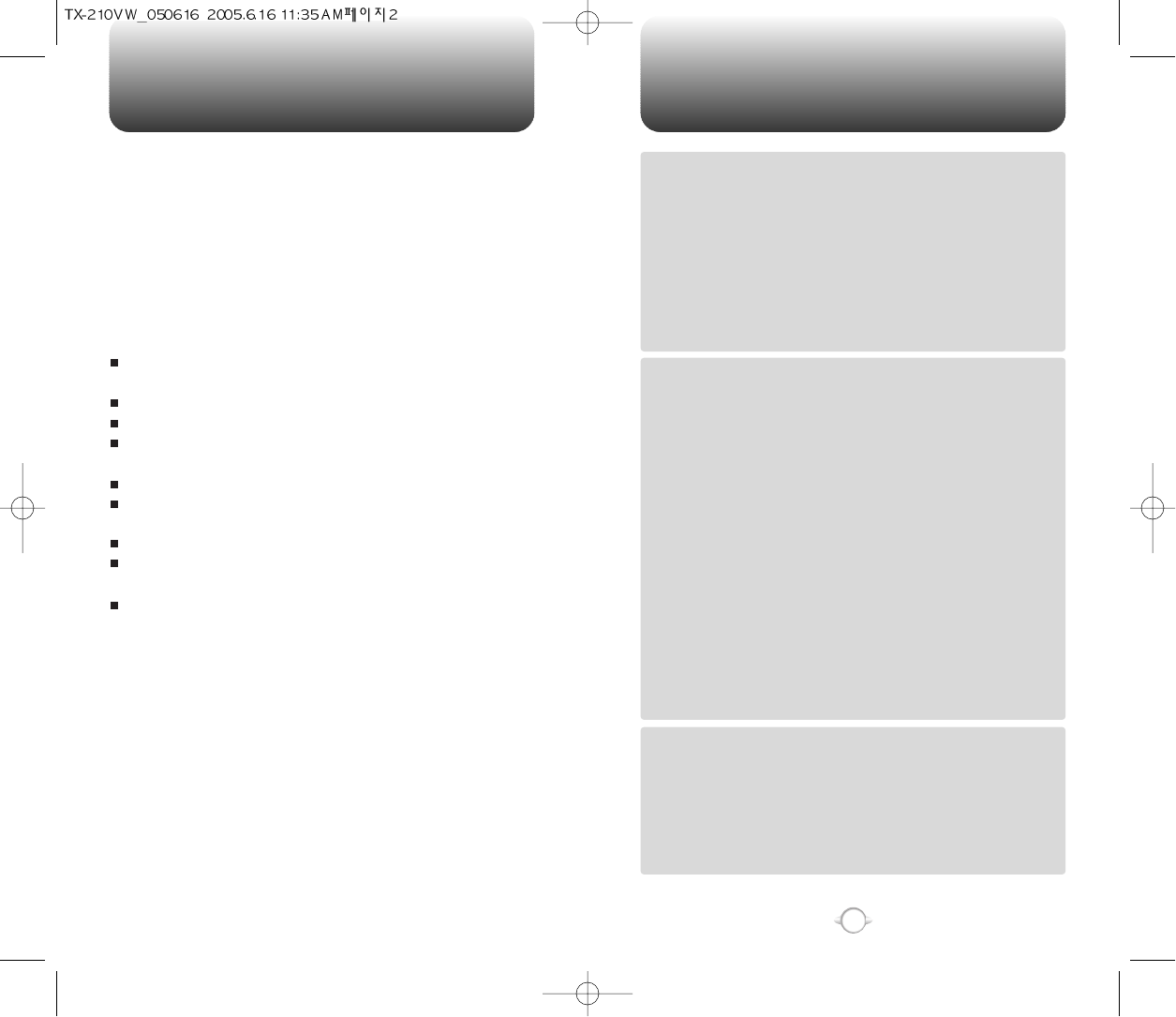
TABLE OF CONTENTS
1
Chapter 1
Chapter 2
Chapter 3
CHAPTER 1. BEFORE USING YOUR PHONE .................................5
INSIDE THE PACKAGE .....................................................................................6
HANDSET DESCRIPTION.................................................................................7
THE FUNCTION KEYS.............................................................................................8
DISPLAY INDICATORS ...........................................................................................9
BATTERY USAGE...........................................................................................11
BATTERY INSTALLATION ....................................................................................11
BATTERY REMOVAL.............................................................................................11
BATTERY CHARGING ...........................................................................................12
POWER CONNECTION ......................................................................................12
PCS AND 1X BATTERY TIMES ...........................................................................13
BATTERY LIFE (FOR NEW BATTERY) ................................................................13
BATTERY HANDLING INFORMATION..........................................................14
DOs.........................................................................................................................14
DON’Ts...................................................................................................................14
CHAPTER 2. BASIC OPERATION ..................................................15
TURNING THE PHONE ON / OFF ..................................................................16
TURNING THE PHONE ON...................................................................................16
TURNING THE PHONE OFF..................................................................................16
ACCESSING THE MENU................................................................................17
MENU SUMMARY .........................................................................................18
BASIC FUNCTIONS ........................................................................................20
MAKING A CALL ...................................................................................................20
ANSWERING CALLS.............................................................................................21
SPEAKER PHONE..................................................................................................21
WAIT/PAUSE FEATURE........................................................................................22
ANSWERING A CALL............................................................................................22
3-WAY CALLING ...................................................................................................23
CALLER ID FUNCTION..........................................................................................23
CALL WAITING FUNCTION ..................................................................................24
ADJUSTING VOLUME ..........................................................................................24
ENTER LOCK MODE .............................................................................................25
DURING A CALL .............................................................................................26
MUTE (UNMUTE)..................................................................................................26
SEND TXT MSG ....................................................................................................26
CONTACTS ............................................................................................................26
RECENT CALLS .....................................................................................................26
SEND DTMF...........................................................................................................26
VOICE PRIVACY.....................................................................................................27
LOCATION .............................................................................................................27
MAKING AN EMERGENCY CALL..................................................................28
911 IN LOCK MODE ..............................................................................................28
911 USING ANY AVAILABLE SYSTEM ...............................................................28
CHAPTER 3. MEMORY FUNCTION...............................................29
STORING A PHONE NUMBER ......................................................................30
ENTERING LETTERS, NUMBERS & SYMBOLS ...........................................31
STANDARD INPUT MODE....................................................................................32
T9 INPUT MODE....................................................................................................33
NUMERIC MODE...................................................................................................34
SYMBOL MODE ....................................................................................................34
MAKING A CALL THROUGH THE PHONE BOOK ........................................35
ONE-TOUCH/TWO-TOUCH DIALING...................................................................35
ONE-TOUCH DIALING:.......................................................................................35
TWO-TOUCH DIALING: ......................................................................................35
WELCOME
Thank you for choosing the up-to-date CDM-210, our new
model, developed by top researchers to support the
CDMA2000 1X system through Qualcomm-manufactured
MSM6050 chips and CDMA technologies. This product allows
for high speed communication services, such as web browsing,
data services, and a GUI animation menu.
T9 input mode makes it much easier to enter text, while VR
(Voice Recognition) makes the CDM-210 more user friendly.
Other proven technologies include:
Full graphic display of 9 text input lines and 1 icon line with
variable font size.
Easy to dial through the VR feature.
Easy to enter letters through the T9 text input mode.
Enhanced for web browsing & data services (i.e.; wireless
internet access, UP browser)
GUI & Animation display compliant with CDMA2000 1X.
Full graphic - Main LCD : TFT260K color wide LCD/
Sub LCD : CSTN 65K color LCD
Navigation Key and 21 keys aligned for more convenience.
Sophisticated features of speaker phone and voice
recognition.
Additional services of text messaging and Web browsing on
top of authentication, call forwarding, call transfer, call
waiting.
IMPORTANT INFORMATION
This CDM-210 user guide contains very important information
about how to handle and use the product.
Please read this manual thoroughly, pay attention to the
warranty on the back page and be alert to the exclusions and
limitations of your warranty, which are related with the
unauthorized use of components.
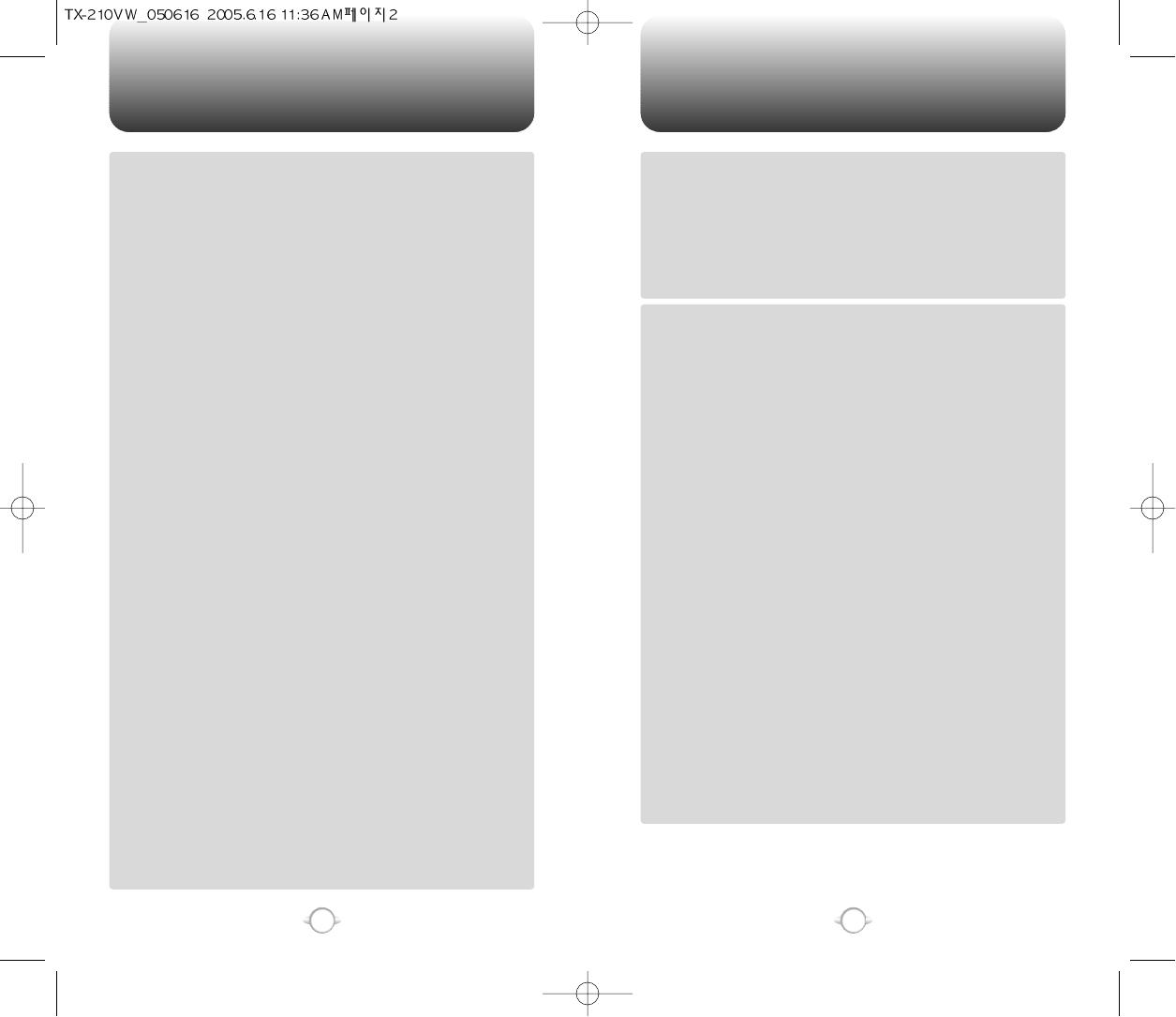
TABLE OF CONTENTS TABLE OF CONTENTS
3
2
Chapter 4 Chapter 5
Chapter 4
TOOLS.............................................................................................................79
CALENDAR ............................................................................................................79
ADD NEW ...........................................................................................................79
VIEW PLAN LIST.................................................................................................80
ALARM CLOCK......................................................................................................81
WORLD CLOCK .....................................................................................................82
NOTEPAD ..............................................................................................................83
ADD MEMO........................................................................................................83
VIEW MEMO ......................................................................................................83
CALCULATOR........................................................................................................84
STOP WATCH........................................................................................................85
CHAPTER 5. VOICE MAIL, TXT MESSAGING..............................87
WHEN A NEW MESSAGE ARRIVES .............................................................88
VOICE MAIL ....................................................................................................88
NEW TXT MSG .........................................................................................................89
INBOX ........................................................................................................................90
FORWARD..........................................................................................................90
ERASE.................................................................................................................91
REPLY WITH COPY ............................................................................................91
SAVE GRAPHICS ................................................................................................91
SAVE SOUND .....................................................................................................91
ADD TO CONTACTS...........................................................................................91
LOCK/UNLOCK ...................................................................................................92
SAVE QUICK TEXT..............................................................................................92
SENT ..........................................................................................................................93
FORWARD..........................................................................................................93
RESEND..............................................................................................................93
ERASE.................................................................................................................94
ADD TO CONTACTS...........................................................................................94
LOCK/UNLOCK ...................................................................................................94
SAVE QUICK TEXT..............................................................................................94
MESSAGE INFO .................................................................................................94
DRAFTS .....................................................................................................................95
SEND ..................................................................................................................95
ADD TO CONTACTS...........................................................................................95
LOCK/UNLOCK ...................................................................................................95
SAVE QUICK TEXT..............................................................................................95
E- MAIL ......................................................................................................................96
ERASE ALL ................................................................................................................97
SETTINGS..................................................................................................................98
AUTO SAVE...........................................................................................................98
AUTO ERASE.........................................................................................................98
AUTO VIEW TXT ...................................................................................................99
AUTO RECEIVE......................................................................................................99
SIGNATURE.........................................................................................................100
CALLBACK# .........................................................................................................100
VOICE MAIL# .......................................................................................................101
BLOCK/UNBLOCK ...............................................................................................101
ENTRY MODE......................................................................................................102
QUICK TEXT ........................................................................................................102
FONT SIZE ...........................................................................................................103
CHAPTER 4. MENU FUNCTION ....................................................37
CONTACTS .....................................................................................................38
NEW CONTACT.....................................................................................................38
CONTACT LIST......................................................................................................39
GROUPS ................................................................................................................40
ADD NEW GROUP .............................................................................................40
ASSIGN PHONE NUMBER TO GROUP..............................................................40
CHANGE GROUP NAME ....................................................................................41
SEND TXT MSG. GROUP ...................................................................................41
ERASE GROUP ...................................................................................................42
SPEED DIALS.........................................................................................................43
RECENT CALLS ..............................................................................................44
MISSED..................................................................................................................44
RECEIVED ..............................................................................................................45
DIALED...................................................................................................................46
ALL .........................................................................................................................47
SETTINGS .......................................................................................................48
SOUNDS ................................................................................................................48
MASTER VOUME ...............................................................................................48
CALL SOUND .....................................................................................................49
ALERT SOUNDS .................................................................................................50
KEYPAD VOUME ................................................................................................52
EARPIECE VOUME.............................................................................................52
SERVICE ALERTS ...............................................................................................53
POWER ON/OFF.................................................................................................54
ALARM SOUNDS ...............................................................................................55
DISPLAYS ..............................................................................................................56
BANNER .............................................................................................................56
BACKLIGHT ........................................................................................................57
CONTRAST .........................................................................................................58
WALLPAPER.......................................................................................................58
SCREENSAVER...................................................................................................59
DISPLAY THEMES..............................................................................................59
FONTS ................................................................................................................59
POWER ON/OFF ANIMATIONS .........................................................................60
SYSTEM.................................................................................................................61
SYSTEM SELECT................................................................................................61
NAM SELECTION ...............................................................................................62
DEVICE INFO ......................................................................................................63
LOCATION ..........................................................................................................64
SECURITY ...........................................................................................................65
LANGUAGE.........................................................................................................68
SHORT CUT KEY ................................................................................................69
CALL SETTINGS....................................................................................................70
ANSWER OPTIONS ............................................................................................70
AUTO RETRY ......................................................................................................71
TTY MODE..........................................................................................................71
ONE TOUCH DIAL ..............................................................................................72
VOICE PRIVACY..................................................................................................72
DATA SETTING ...................................................................................................72
VOICE SERVICES................................................................................................73
DTMF TONES .....................................................................................................76
CLOCK FORMAT ...................................................................................................77
MAIN CLOCK......................................................................................................77
FRONT CLOCK ...................................................................................................77
RINGER ID..............................................................................................................78
PICTURE ID ............................................................................................................78
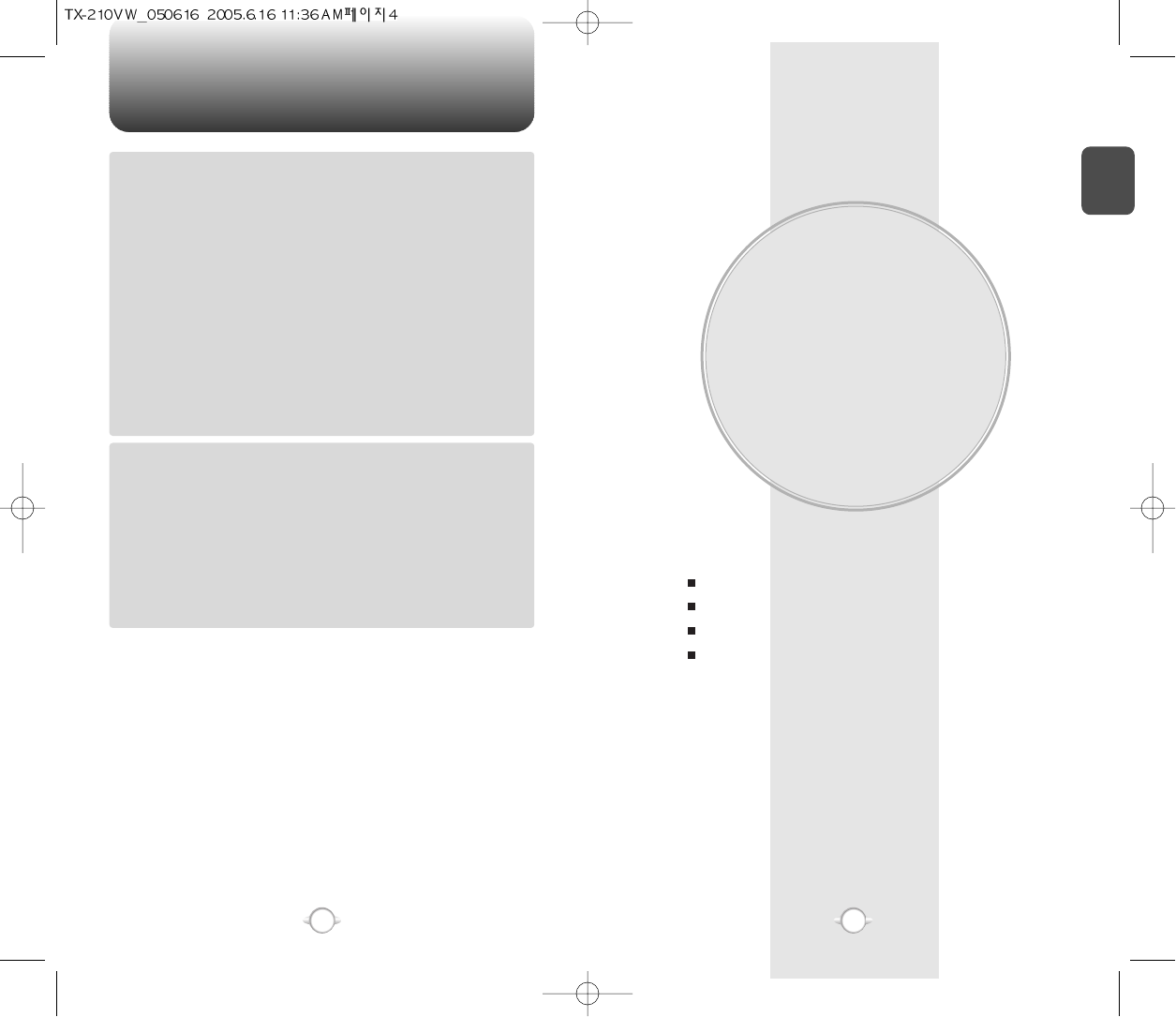
BEFORE USING
YOUR PHONE
C
H
.
1
5
This chapter provides important information about using the
CDM-210 including:
Chapter 1
INSIDE THE PACKAGE
HANDSET DESCRIPTION
BATTERY USAGE
BATTERY HANDLING INFORMATION
TABLE OF CONTENT
4
Chapter 6
Chapter 7
CHAPTER 6. GET IT NOW & MOBILE WEB 2.0..........................105
GET IT NOW .................................................................................................106
GET TUNES & TONES ........................................................................................106
DOWNLOADING NEW TUNES & TONES ........................................................106
TO RECORDING NEW TONES .........................................................................106
USING DOWNLOADED TUNES & TONES.......................................................107
GET FUN & GAMES............................................................................................108
DOWNLOADING NEW FUN & GAMES ...........................................................108
PLAYING DOWNLOADED FUN & GAMES ......................................................108
GALLERY .............................................................................................................109
STARTING INTERNET BROWSER...............................................................110
ACCESS THE INTERNET.....................................................................................110
BROWSER MENU.........................................................................................110
VZW HOME..........................................................................................................110
BACK ....................................................................................................................110
FORWARD ...........................................................................................................110
REFRESH..............................................................................................................111
HISTORY ..............................................................................................................111
ADDRESS.............................................................................................................111
CLEAR MEMORY.................................................................................................111
SETTINGS............................................................................................................112
ADVANCED..........................................................................................................112
EXIT......................................................................................................................112
CHAPTER 7. SAFETY AND WARRANTY ....................................113
SAFETY INFORMATION FOR WIRELESS HANDHELD PHONES ..............114
DRIVING SAFETY ................................................................................................115
ELECTRONIC DEVICES .......................................................................................116
OTHER SAFETY GUIDELINES ............................................................................117
PRECAUTIONS ....................................................................................................118
SAFETY INFORMATION FOR FCC RF EXPOSURE ....................................119
CAUTIONS...........................................................................................................119
SAR INFORMATION.....................................................................................120
FCC HEARING-AID COMPATIBILITY (HAC) REGULATIONS FOR
WIRELESS DEVICES.....................................................................................122
FDA CONSUMER UPDATE ..........................................................................124
PROTECT YOUR WARRANTY .....................................................................128
12 MONTH LIMITED WARRANTY...............................................................129
“Licensed by QUALCOMM Incorporated under one or more of the following Patents : U.S.Patent No.
4,901,307 U.S.Patent No. 5,056,109 U.S.Patent No. 5,099,204 U.S. Patent No. 5,101,501 U.S. Patent No.
5,103,459 U.S. Patent No. 5,107,225 U.S.Patent No. 5,109,390.”
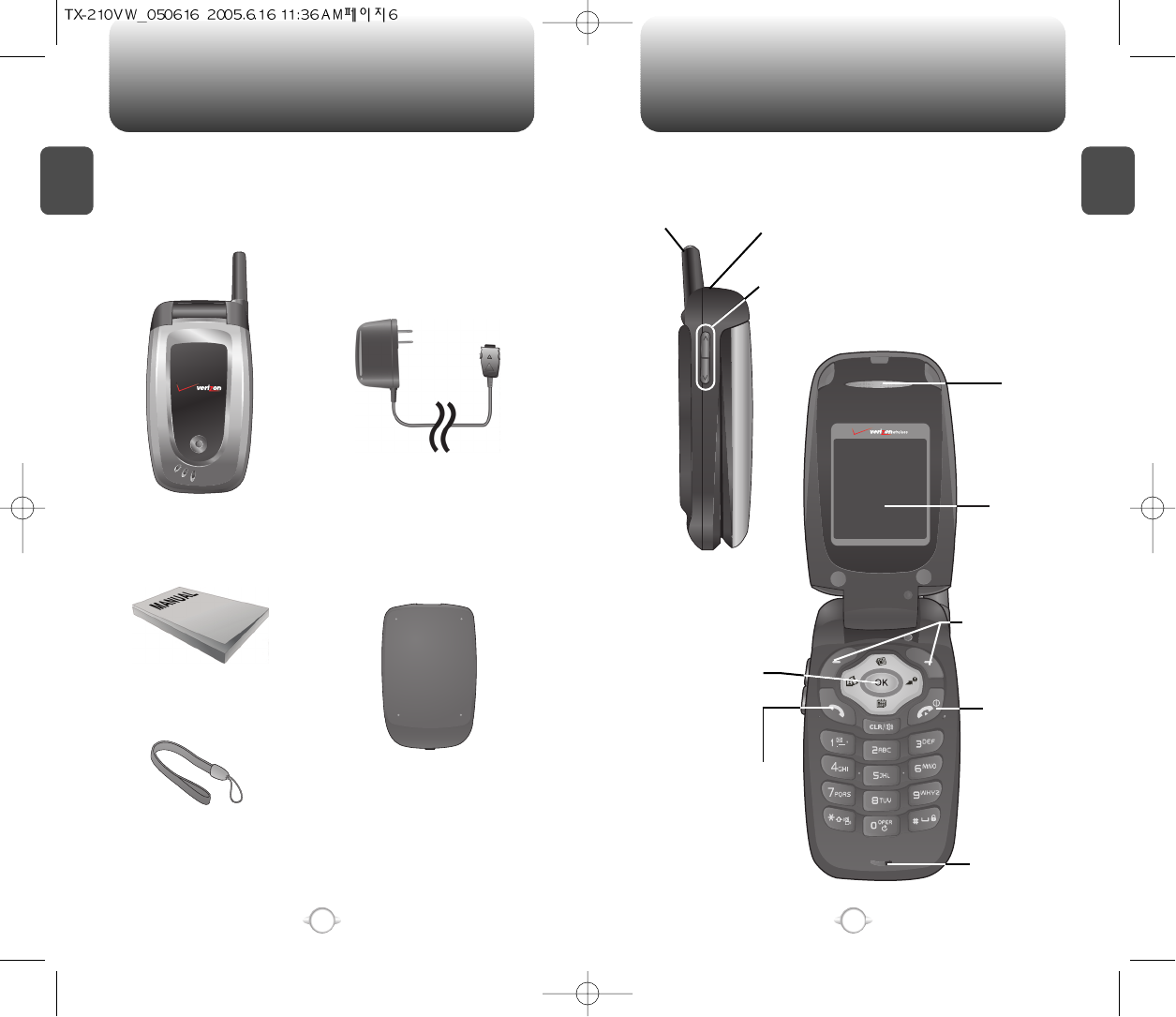
HANDSET DESCRIPTION
C
H
1
This package should include all items pictured below.
If any are missing or different, immediately contact the retailer
where you purchased the phone.
7
INSIDE THE PACKAGE
C
H
1
6
The CDM-210 weighs 3.7oz. The dimensions are 1.83” x 4.48” x 0.97”.
Handstrap
User Manual
AC Travel Charger
Handset
Standard Battery
Antenna Earjack
Volume Key
LCD Screen
Function Keys
Send Key
END/
Power Key
Microphone
Earpiece
Navigation Key
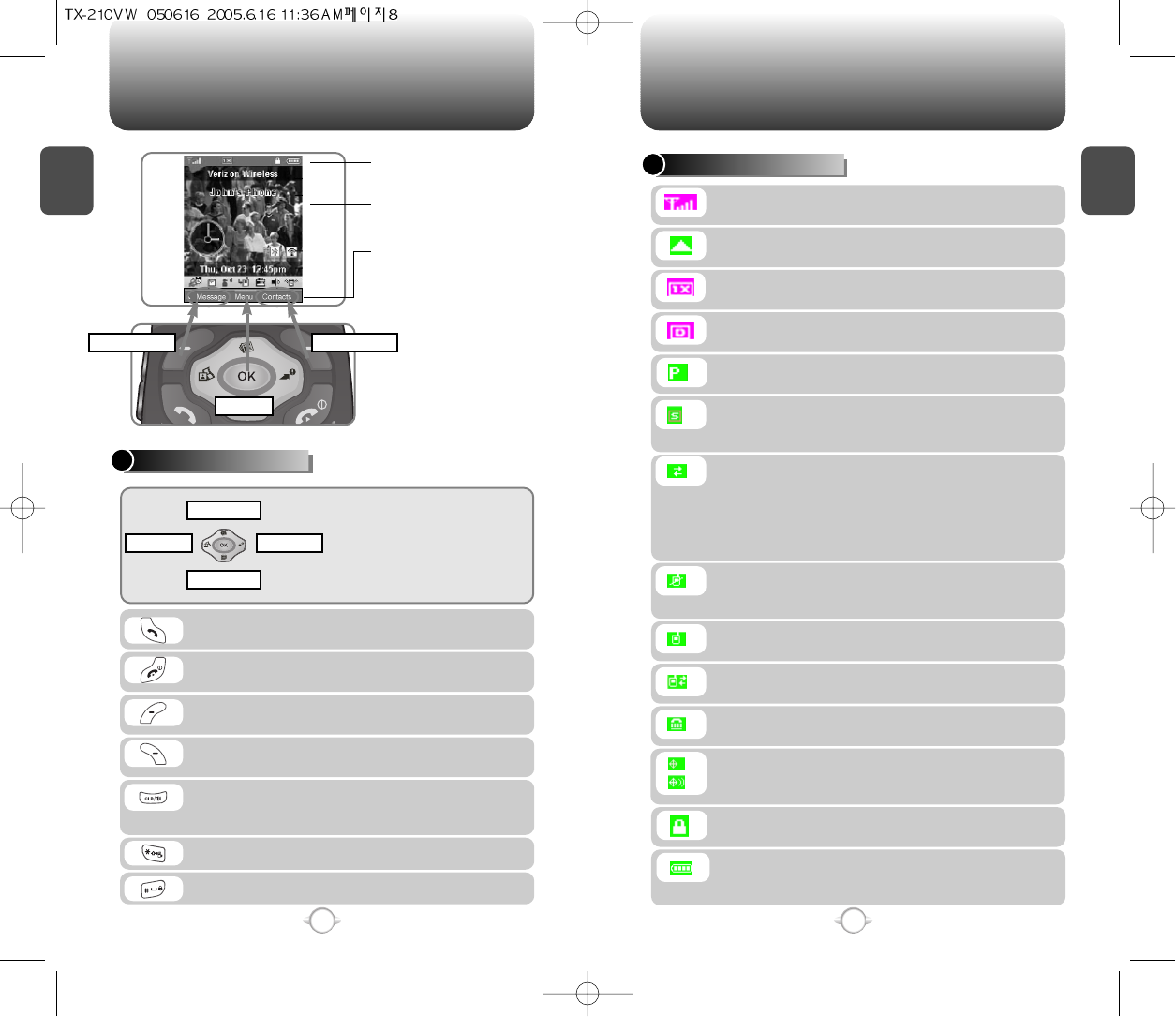
C
H
1
DISPLAY INDICATORS
9
C
H
1
THE FUNCTION KEYS
8
Press to make or receive a call.
Press to clear a digit from the display or to return
to the previous page.
Press and hold to enable speaker phone mode.
Press and hold to enter lock mode.
Press and hold to enter etiquette mode.
Press to turn the phone on/off, to terminate a call
or to return to the initial page.
Signal Strength - Current signal strength: the
more lines, the stronger the signal.
SLI
Roaming
Phone is out of home area.
1X
Phone is in the 1x service area.
Digital mode
Phone is operating in digital mode.
Dormant
Indicates your phone is in a dormant state during a
data call. Your phone goes to Dormant mode when
you have not had any activity on a page for some
time - your connection is still active and now you
can make and receive calls.
No Service
Indicates the phone cannot receive a signal from
the system.
Voice
Data Active
Locked
Indicates your phone is locked.
In Idle Mode
-
Press Up to access the Web Browser,
Down to access the Short Cut Key, Right
for Get It Now and Left for Get Pix &Flix.
Inside the menu
- Within a menu, use to scroll through
menu options, or to select a function
displayed on the screen.
(Left Soft Key) Press to access the message
menu or function displayed on bottom line.
(Right Soft Key) Press to access contacts menu
or function displayed on bottom line.
HANDSET DESCRIPTION HANDSET DESCRIPTION
Display Indicators
See page 9 for a list of icons.
Soft Key Indicators
Shows the functions currently
assigned to each soft key and
displays some icons.
Text & Graphic area
Message
Menu
Short Cut Key
Get It Now
Get Pix & Flix
Web Browser
Battery
Battery charging level – the more blocks, the
stronger the charge.
Contacts
TTY
Indicates your phone is in TTY mode is active.
Voice Privacy
Indicates “Voice Privacy” mode.
GPS Icon
Indicates the Location Service of your phone is
disabled/enabled.
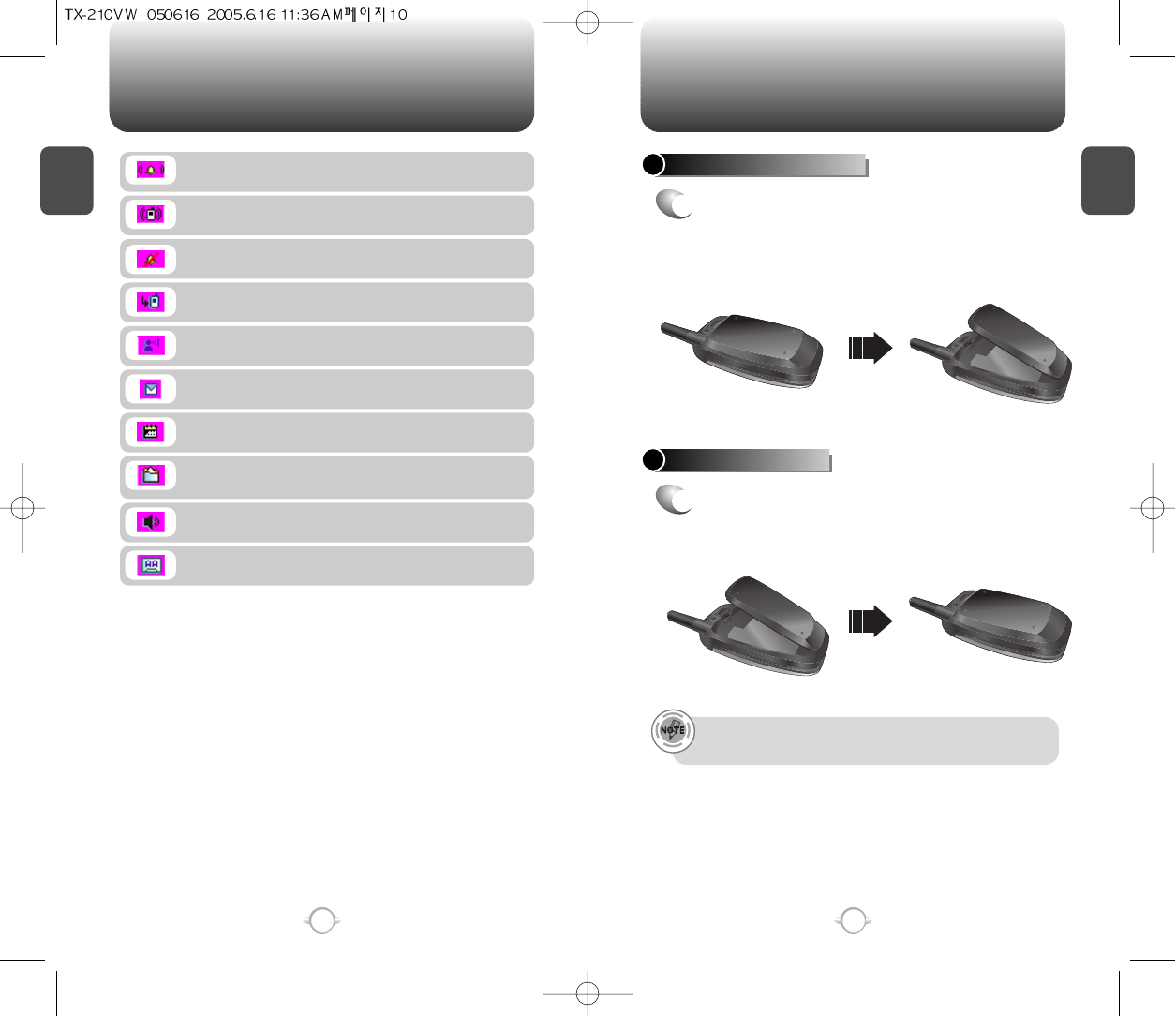
C
H
1
11
C
H
1
10
HANDSET DESCRIPTION BATTERY USAGE
Missed Call
Voice Mail
indicates you have voicemail messages.
New Message
New TXT or voice message.
Calendar Appointment
Indicates Event Alarm is active.
Data Only
Receives an async. call as a voice call.
Speaker Phone
Phone is in speaker phone mode.
Auto Answer
Phone is in answering machine mode.
All Sound
Indicates the ringer volume is set to off.
Vibrte On
Phone will vibrate when call is received.
Alarm Only
Phone will Alarm Only when call is received.
BATTERY INSTALLATION
1
uPlace the battery on the back of the handset
and slide into place. vPush the battery down
until it locks into place.
BATTERY REMOVAL
1
uPull down the release latch, lift up the
battery and vremove the battery from the
handset.
If the battery is not correctly placed in the compartment, the
handset will not turn on and/or the battery may detach during use.
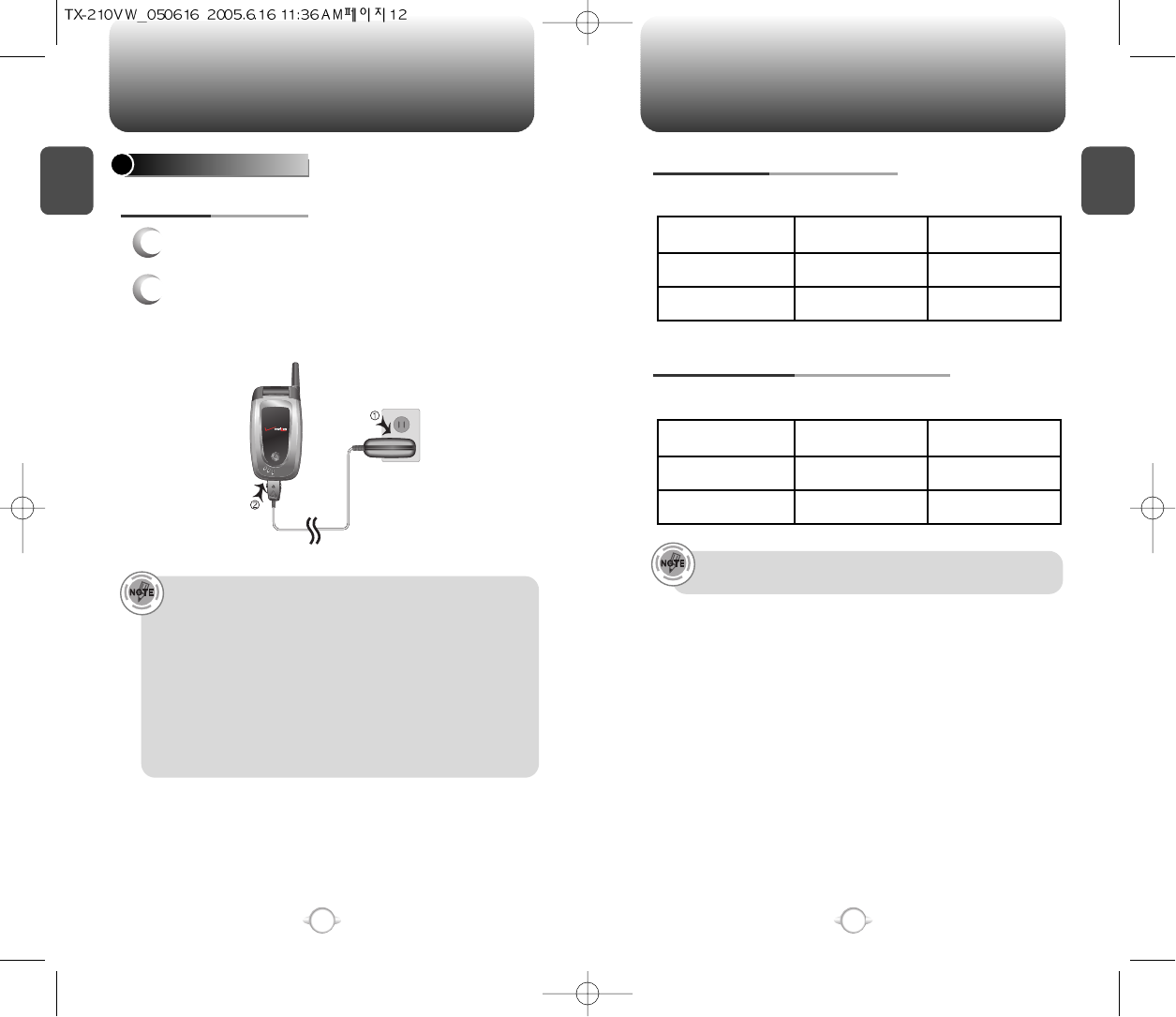
C
H
1
13
C
H
1
12
BATTERY USAGE BATTERY USAGE
BATTERY LIFE (FOR NEW BATTERY)
The operating time is subject to your handset usage and configuration.
PCS AND 1X BATTERY TIMES
The operating time is subject to your handset usage and configuration.
These times are for a new battery. Usage and Standby time may
decrease over time.
• When you charge the battery with the phone power off, you
will see a charging status screen. You cannot operate the
phone until it is powered on.
• The battery is not charged at the time of purchase.
• Fully charge the battery before use.
• It is more efficient to charge the battery with the handset
powered off.
• The battery must be connected to the phone in order to charge it.
• Battery operating time gradually decreases over time.
• If the battery fails to perform normally, you may need to replace
the battery.
1
Plug the AC Charger into a standard outlet.
2
Plug the other end of the AC Charger into the
bottom of your phone. The battery must be
installed onto the phone.
BATTERY CHARGING
POWER CONNECTION
PCS
Up to 160 m
Up to 270 m
DCS
Up to 162 m
Up to 282m
STD 1000 mAh
Battery Capacity
EXT 1700 mAh
PCS
172 Hours
293 Hours
DCS
190 Hours
326 Hours
STD 1000 mAh
Battery Capacity
EXT 1700 mAh
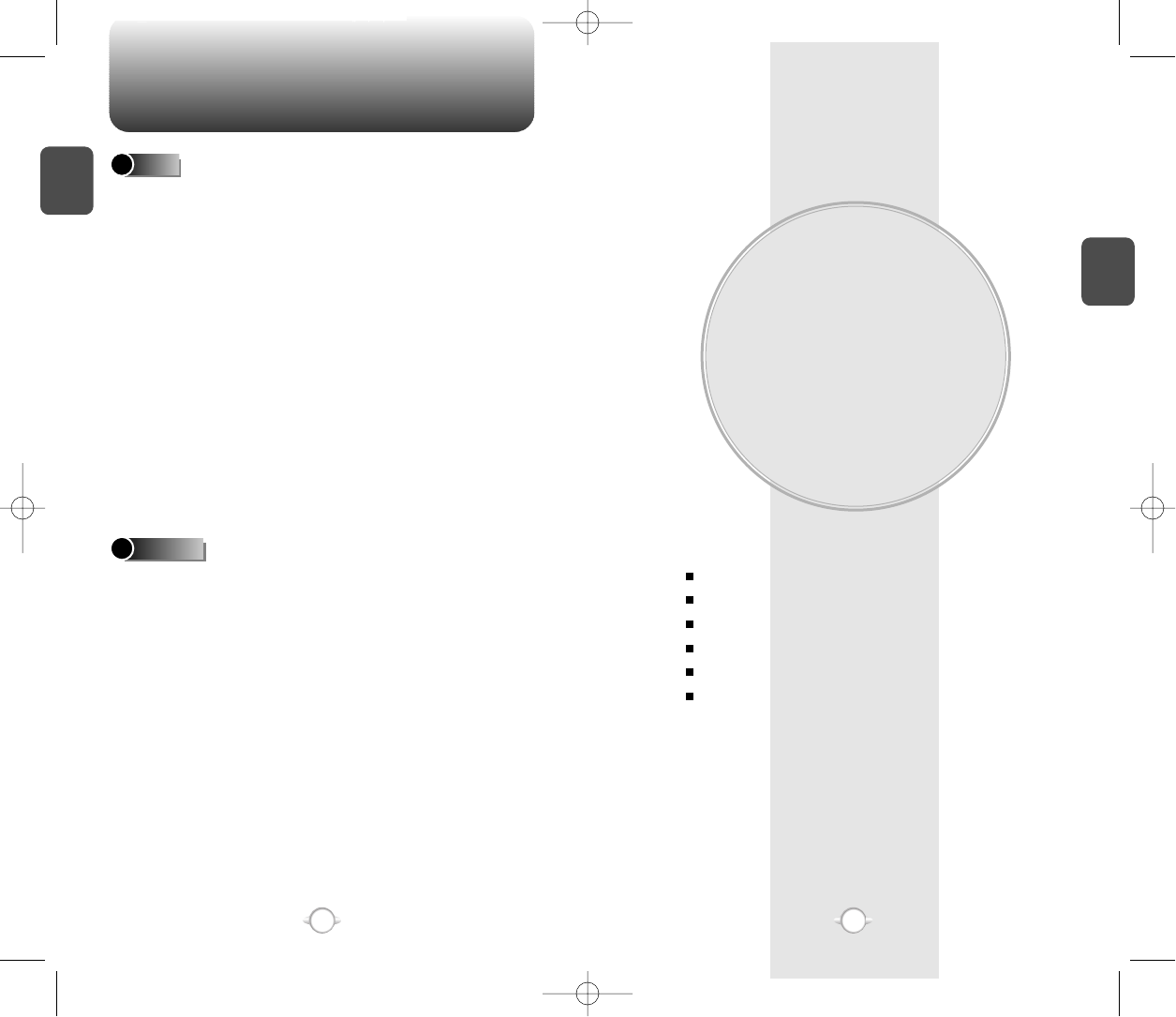
BATTERY HANDLING INFORMATION
BASIC OPERATION
This chapter addresses and explains the basic features of your phone
including:
Chapter 2
C
H
2
15
C
H
1
14
TURNING THE PHONE ON / OFF
ACCESSING THE MENU
MENU SUMMARY
BASIC FUNCTIONS
DURING A CALL
MAKING AN EMERGENCY CALL
lOnly use the battery and charger approved by the
manufacturer.
lOnly use the battery for its original purpose.
lTry to keep batteries in a temperature between
41ºF (5ºC ) and 95ºF (35ºC).
lIf the battery is stored in temperatures above or
below the recommended range, give it time to warm
up or cool down before using.
lCompletely drain the battery before recharging.
It may take one to four days to completely drain.
lStore the discharged battery in a cool, dark, and dry
place.
lPurchase a new battery when its operating time
gradually decreases after fully charging.
lProperly dispose of the battery according to local
laws.
lDon’t attempt to disassemble the battery –
it is a sealed unit with no serviceable parts.
lDon’t accidentally short circuit the battery by
carrying it in your pocket or purse with other
metallic objects such as coins, clips and pens.
This may critically damage the battery.
lDon’t leave the battery in hot or cold temps.
Otherwise, it could significantly reduce the capacity
and lifetime of the battery.
lDon’t dispose of the battery into a fire.
DOs
DON’Ts
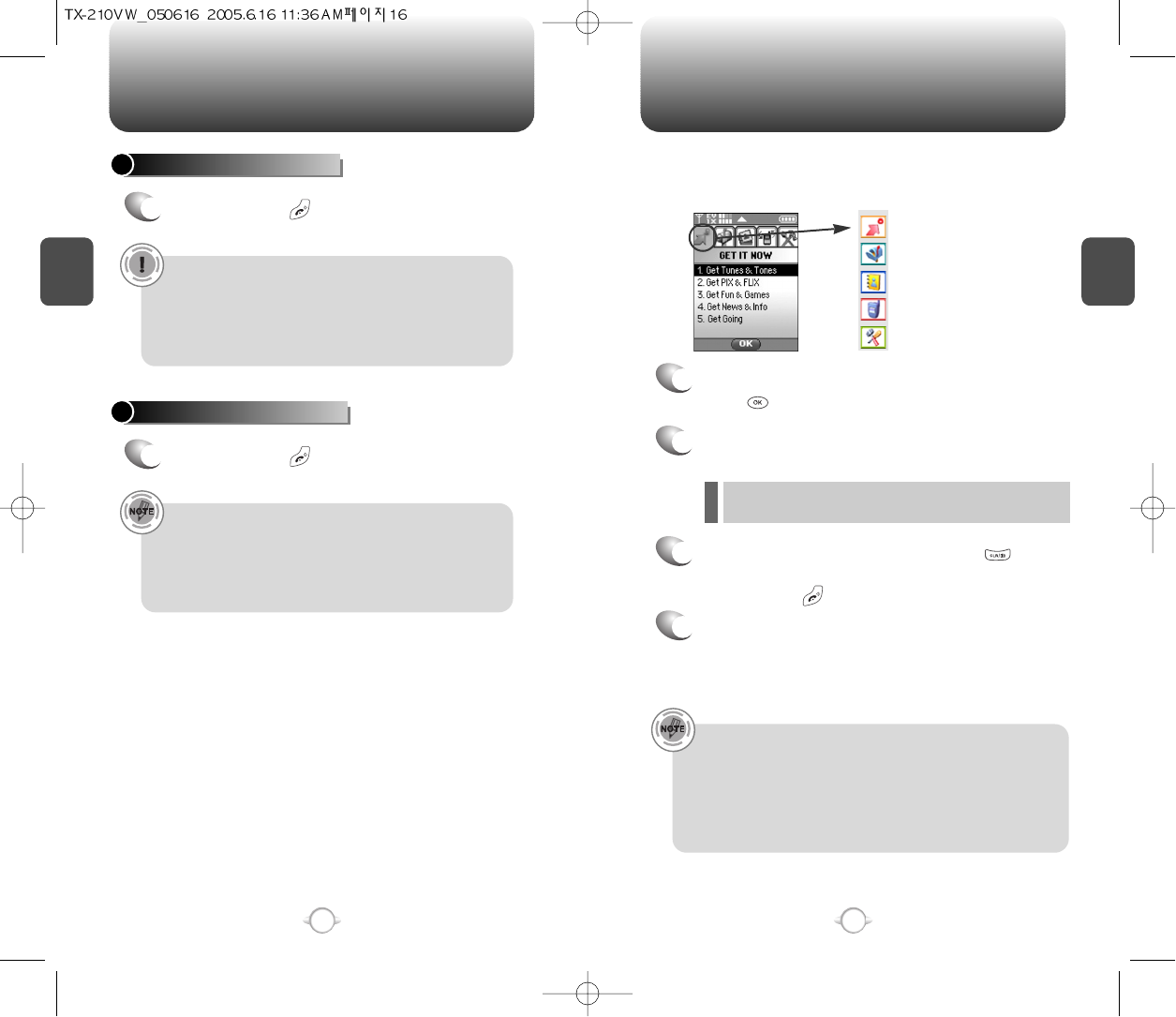
ACCESSING THE MENU
C
H
2
Your phone can be customized via the menu. Each function can be
accessed by scrolling with the Navigation Key or by pressing the
number that corresponds with the menu item.
1
To access the menu in the idle mode,
press [MENU].
2
Use the Navigation Key to scroll through the
menu.
3
To return to the previous page, press .
To exit the current menu and return to the idle
mode, press .
4
Press the Navigation Key to enter a function
when its main page is displayed or press its
assigned number to have direct access to
the function.
17
C
H
2
TURNING THE PHONE ON
1
Press and hold until your “Power On” logo
appears and the tone sounds.
• To select a logo, refer to page 58 for more details.
(Settings & Tools>Displays>Wallpaper) for more detail.
• If “Password” appears on the display enter your 4-digit
password to unlock your phone.
• The default password is the last 4 digit of your phone
number.
16
TURNING THE PHONE OFF
1
Press and hold until your “Power Off” logo
appears.
• Immediately change or recharge the battery when
“LOW BATTERY!! PHONE IS TURNING OFF!” appears on
the display. Memory may possibly be damaged if the phone
turns off due to the battery completely draining.
• Turn the phone off before removing or replacing the battery.
If the phone is on, unsaved data may be lost.
Hotkey
In idle mode, move the Navigation Key as follows to access
these functions:
• Upward movement : Web Browser
• Downward movement : Short Cut Key
• Rightward movement : Get It Now
• Leftward movement : Get Pix & Flix
TURNING THE PHONE ON / OFF
lTo search through the menu in numerical order, press the
Navigation Key.
Get It Now
Messaging
Contacts
Recent Calls
Settings & Tools
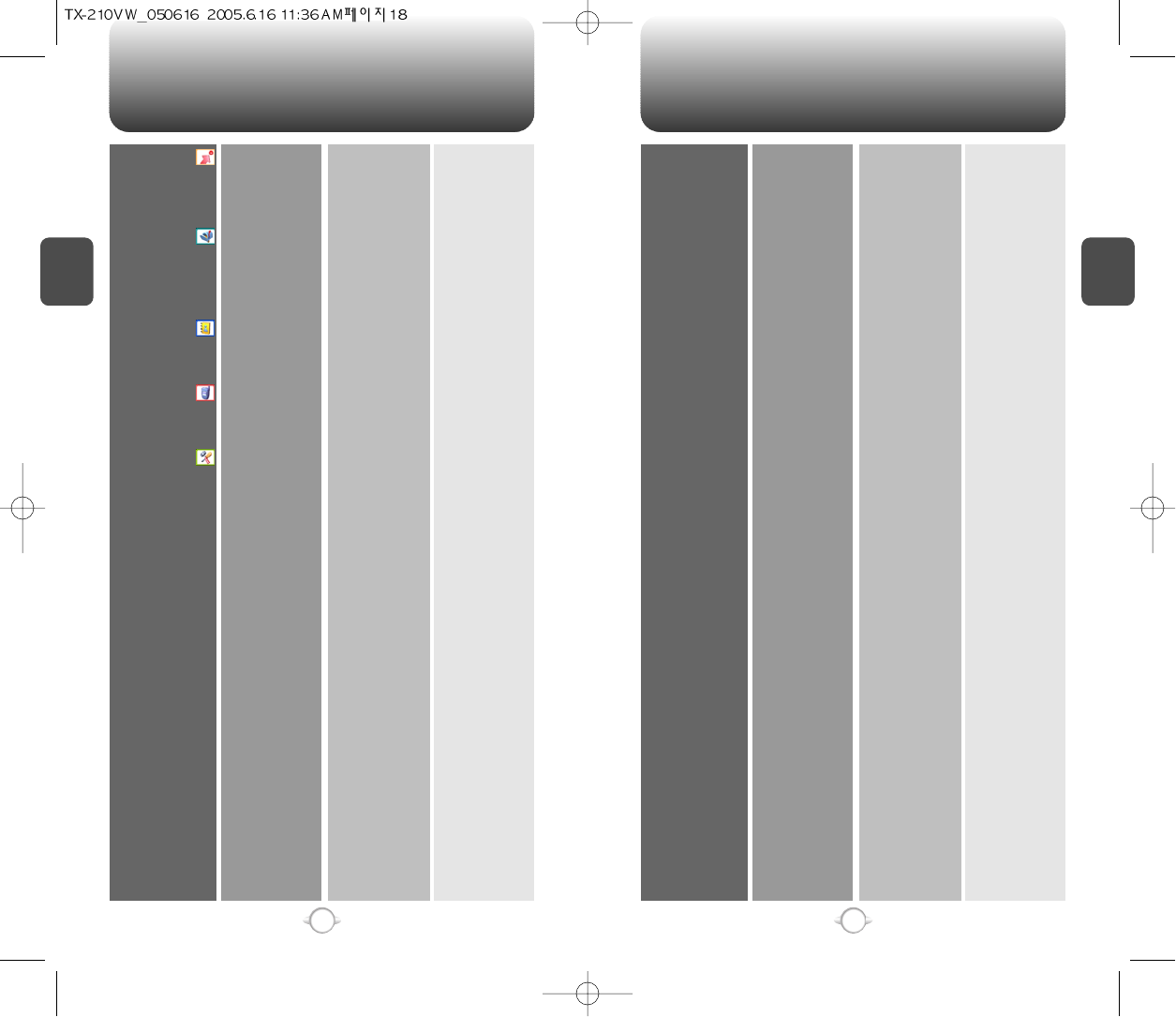
MENU SUMMARY MENU SUMMARY
C
H
2
19
C
H
2
18
Get It Now
Messaging
Contacts
Recent Calls
Settings & Tools
1. Get Tunes &
Tones
2. Get Fun &
Games
3. Gallery
1. New Txt Msg
2. Inbox
3. Sent
4. Drafts
5. Voice Mail
6. E-mail
1. New Contact
2. Contact List
3. Groups
4. Speed Dials
1. Missed
2. Received
3. Dialed
4. All
1. Tools
2. Sounds
3. Displays
1. Get New
2. Record New
1. Calendar
2. Alarm Clock
3. World Clock
4. Notepad
5. Calculator
6. Stop Watch
1. Master Volume
2. Call Sound
3. Alert Sounds
4. Keypad Volume
5. Earpiece Volume
6. Service Alerts
7. Power On/Off
8. Alarm Sounds
1. Banner
2. Backlight
3. Contrast
4. Wallpaper
5. Screensaver
6. Display Themes
7. Fonts
1. Alarm 1
2. Alarm 2
3. Alarm 3
1. Call Ringtone
2. Call Vibrate
1. ERI Tones
2. Txt Message
3. Pix Message
4. Voice Message
1. Service Change
2. Minute Beep
3. Call Connect
1. Power On
2. Power Off
1. Alarm Tone
2. Alarm Vibrate
1. Personal
2. ERI Banner
1. LCD
2. Keypad
4. System
5. Call Settings
6. Clock Format
7. Ringer ID
8. Picture ID
8. Power On/Off
Animations
1. System Select
2. NAM Selection
3. Device Info
4. Location
5. Security
6. Language
7. Short Cut Key
1. Answer Options
2. Auto Retry
3. TTY Mode
4. One Touch Dial
5. Voice Privacy
6. Data Settings
7. Voice Services
8. DTMF Tones
1. Main Clock
2. Front Clock
1. Power On
Animation
2. Power Off
Animation
1. Auto NAM
2. Change NAM
1. My Number
2. SW Version
3. Icon Glossary
1. Common Code
2. Lock Mode
3. Edit Code
4. Special #’s
5. Erase All
6. Reset Phone
1. Voice Dials
2. Voice Setting
3. Voice Memo
4. Train Words
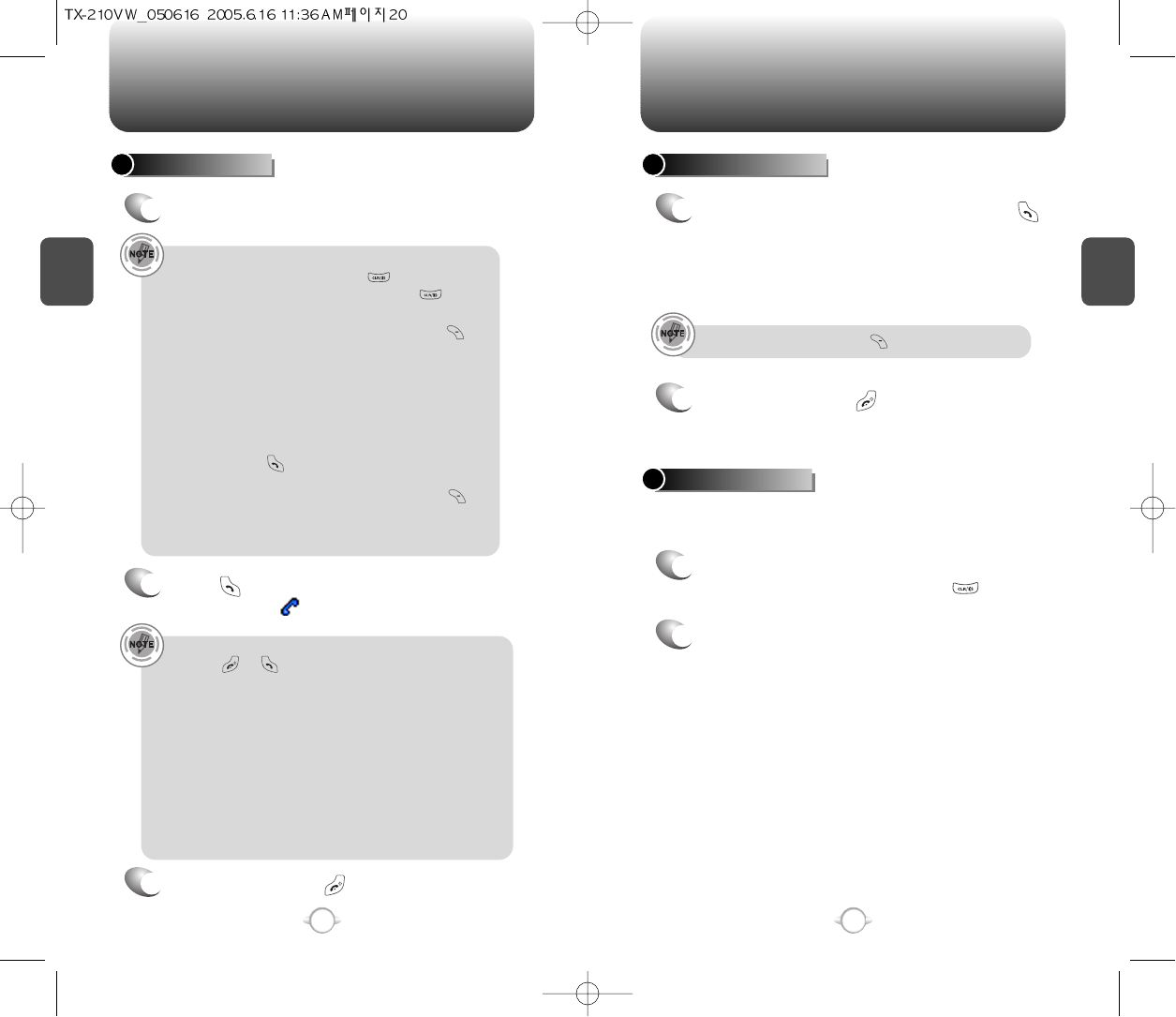
BASIC FUNCTIONS
C
H
2
21
C
H
2
20
BASIC FUNCTIONS
MAKING A CALL
1
Enter a phone number.
To modify the phone number you have entered :
• To erase one digit at a time press .
• To erase the entire number, press and hold .
To find the phone number with you’r contact list :
• To enter a part of the phone number, then press
[Options], select “Search”.
Phone number display in contact list
If contact’s name field empty, then highest priority phone
number displayed. If any phone number and name is not
exist then email address diaplay.
Referece “Contact display order”.
All matching entries will be displayed. To call the selected
number, press .
To send the txt with phone number :
• To enter a part of the phone number, then press
[Options], select “Send Txt Msg . Please refer to page 89
for more details on “Send TXT Msg”.
2
Press .
The indicator, , appears on the display.
• If “CALL FAILED” appears on the display or the line is busy,
press or .
• If you activate the “AUTO RETRY” function, the phone will
automatically retry for the number of times you have
selected. (refer to page 71).
• When you place or receive a call from stored phone
numbers, both the name and phone number will be
displayed.
• There is another way to make a call through the VR mode,
which is called “VAD (Voice Activated Dialing)”.
Please refer to page 73 (Voice Service) for more details.
• If “Enter Lock Code” appears on the display enter your
4-digit password to unlock your phone.
3
To end a call, press .
To ignore incoming calls, press [Ignore].
ANSWERING CALLS
1
When your phone rings or vibrates, press
to answer the incoming call.
(Depending on your phone’s settings, you may
also answer incoming calls by opening the
phone or by pressing any digit key.)
2
To end a call, press .
The speaker phone feature lets you hear audio through the speaker and
talk without holding the phone.
SPEAKER PHONE
1
To activate the speaker phone in idle, answering
or calling modes, press and hold .
2
The phone returns to normal (Speaker Phone Off)
after ending a call or when the phone is turned off
and back on.
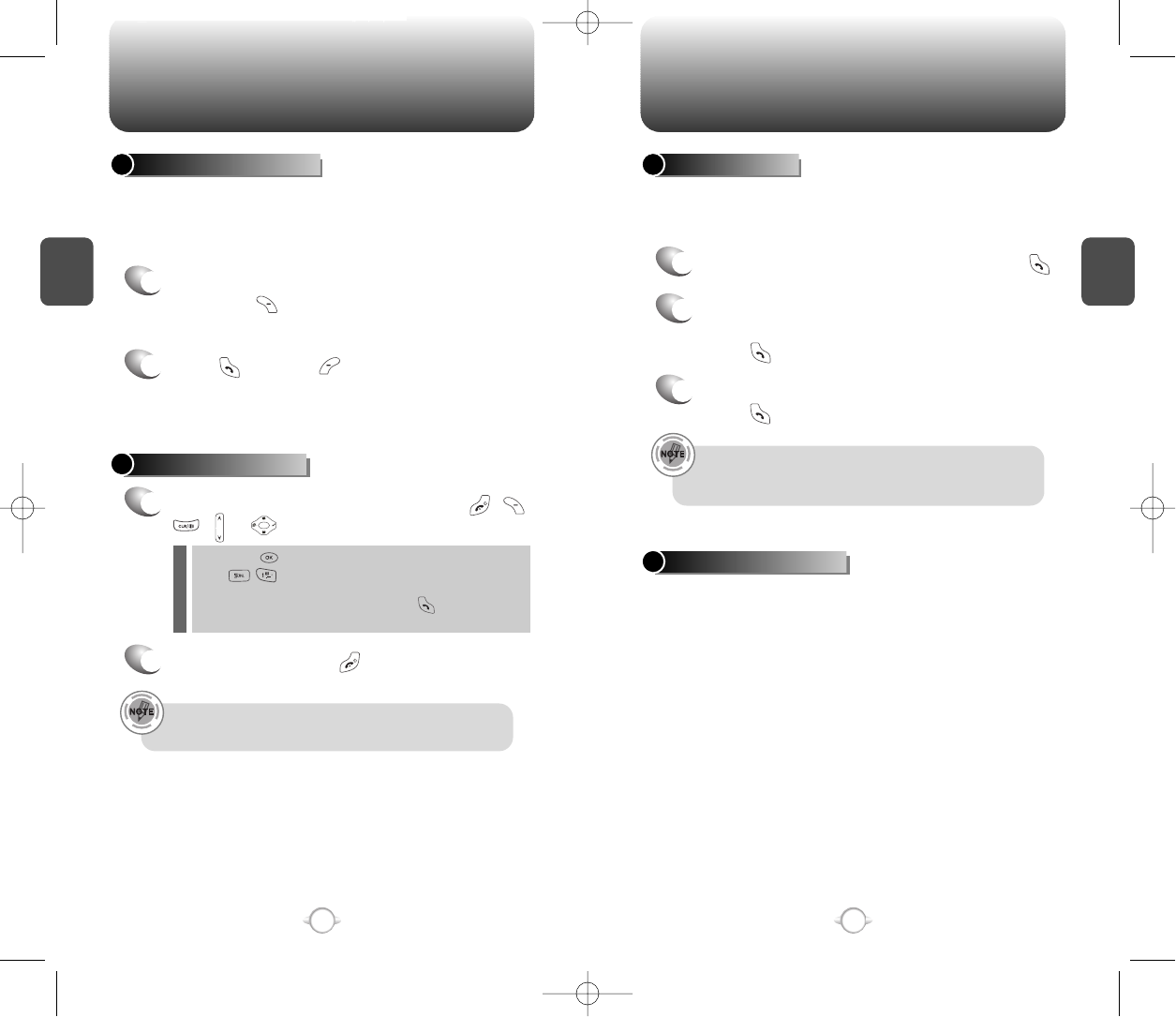
BASIC FUNCTIONS BASIC FUNCTIONS
C
H
2
23
C
H
2
22
ANSWERING A CALL
1
To answer a call, press any key except , ,
, or .
2
To end the call, press .
In Auto Answer Mode a call is automatically answered after a
preset number of ring tones. See page 70 for more details.
If one of the people you called hangs up during your call, you
and the remaining caller stay connected. If you initiated the call
and are the first to hang up, all three callers are disconnected.
lBy pressing [MENU] tnen select “Settings & Tools” menu,
press , you can select either “Flip Open”, “Any Key”
or “Send Only” to answer a call. lf “Send Only” is selected, the
phone can only be answered by pressing .
See page 71 for more information.
With Three-Way Calling, you can talk to two people at the same time.
When using this feature, the normal airtime rates will be applied for
each of the two calls.
3-WAY CALLING
1
Enter a number you wish to call then press .
2
Once you have established the connection,
enter the second number you wish to call then
press .
3
When you’re connected to the second party,
press again to begin your three-way call.
Pauses are used for automated systems (i.e., voice mail, calling cards).
Insert a pause after a phone number then enter another group of
numbers. The second set of numbers is dialed automatically after the
pause. This feature is useful for dialing into systems that require a code.
WAIT/PAUSE FEATURE
1
To insert a wait/pause, enter a phone number
then press [OPTIONS]. Select either a Hard
Pause (“P” appears) or a Wait (“W” appears).
2
Press to dial or to save.
Please refer to page 30 for more details about
storing a phone number.
Identifies caller by displaying their phone number. If the caller’s name
and number are already stored in your phone book, they both will
appear. The caller ID is stored in the call history.
CALLER ID FUNCTION
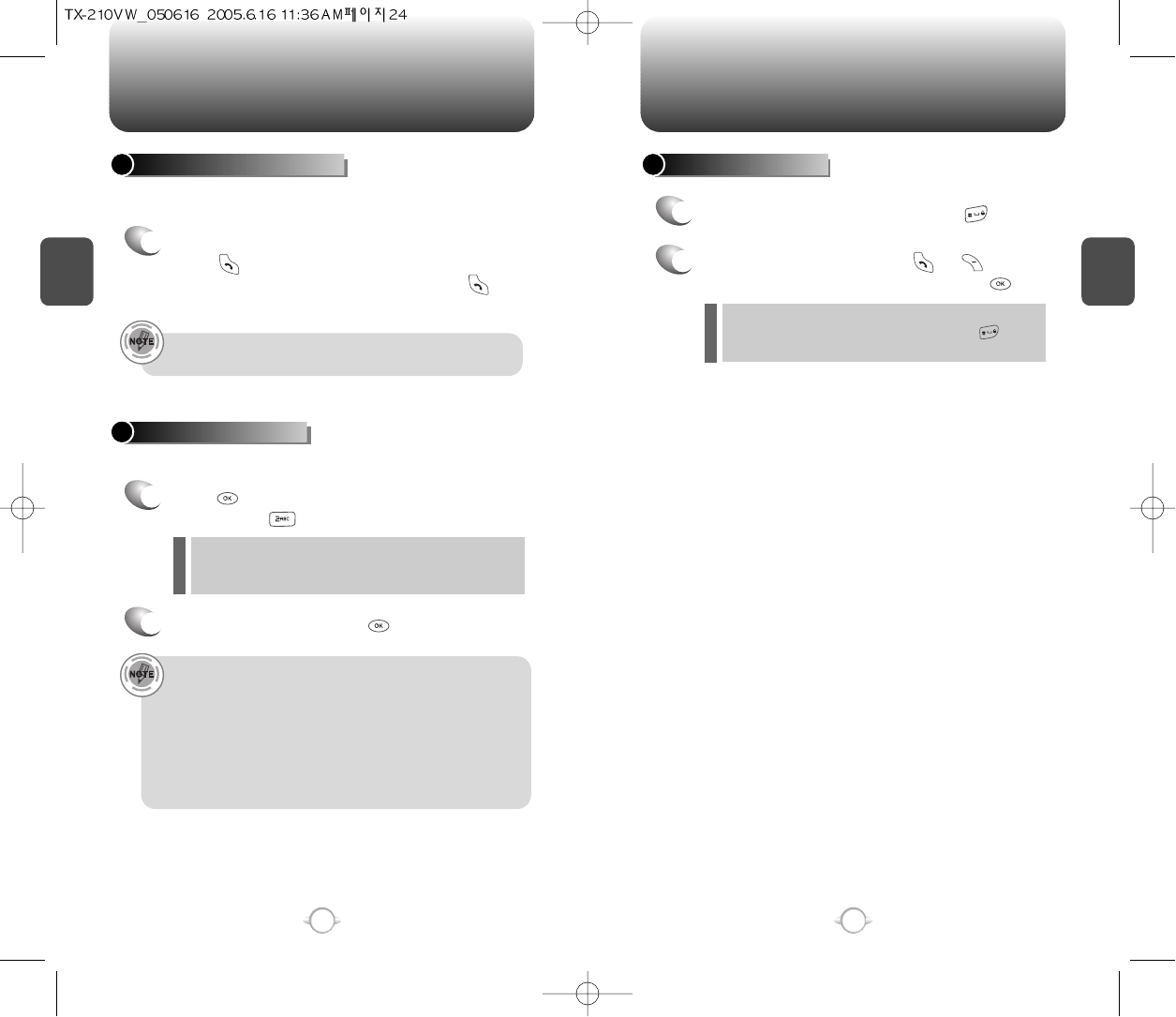
BASIC FUNCTIONS BASIC FUNCTIONS
C
H
2
25
C
H
2
24
ENTER LOCK MODE
1
To lock the phone, press and hold .
2
To unlock the phone, press or [UNLOCK],
then input your password, then press [OK].
The lock feature will deactivate when the phone is powered
off. Upon next power up, you will need to press to lock
phone again.
l
Notifies you of an incoming call when you are already on a call by
sounding a beep tone and displaying the caller’s phone number.
CALL WAITING FUNCTION
1
To answer another call while on the phone,
press . This places the first call on hold.
To switch back to the first caller, press
again.
Adjusts the volume of the ringer, key beep and speaker.
ADJUSTING VOLUME
1
Press [MENU], then select “Settings & Tools”
menu, press then select one of the following.
2
Adjust volume then press [OK] to save it.
Master Volume : Controls the ringer volume.
Keypad Volume : Controls the keypad volume.
Earpiece Volume : Controls the earpiece volume.
l
l
l
• To adjust earpiece volume during a call, press the Navigation
Key up or down.
• To adjust master volume, press short side up/ down key.
•In Idel Mode:
Side Volume Up key Long Press: Volume key shall bring device
out of silence.
Side Volume Down key Long Press: Switch between on/off
sound including alarm but
except speaker.
Call Waiting is a system dependent feature. Please contact your
service provider for details.
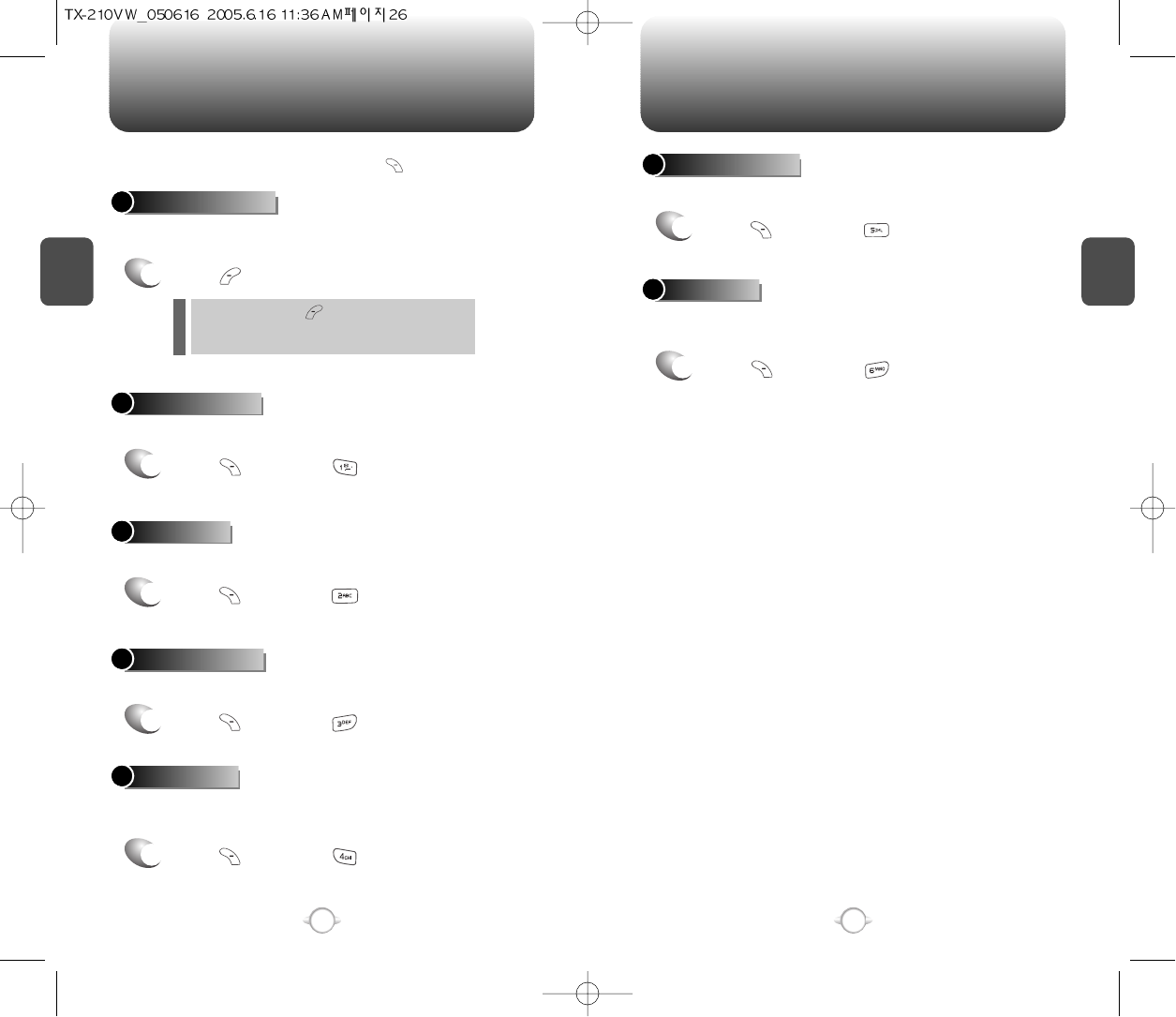
DURING A CALL DURING A CALL
C
H
2
27
C
H
2
26
Increases security during a call.
VOICE PRIVACY
Enables the network to locate your current location through Global
Positioning System (GPS). (Refer to page 66 for more details.)
LOCATION
1
Press [OPTIONS] .
1
Press [OPTIONS] .
Enables you to send a TXT message (SMS) during a call.
To display menu options during a call, press [
Options
].
SEND TXT MSG
1
Press [OPTIONS] .
To select the phone number in your recent calls List.
RECENT CALLS
Automatically transmits your phone number to a pager during a call.
(Dependent on pager service)
SEND DTMF
To select the phone number in your internal Contact List.
CONTACTS
1
Press [OPTIONS] .
1
Press [OPTIONS] .
1
Press [OPTIONS] .
The caller cannot hear you or any sounds from your side but you can
still hear them.
MUTE (UNMUTE)
1
Press [Mute].
To deactivate, press [UNMUTE].
The phone will automatically un-mute in Emergency
Call or Callback mode.
l
l
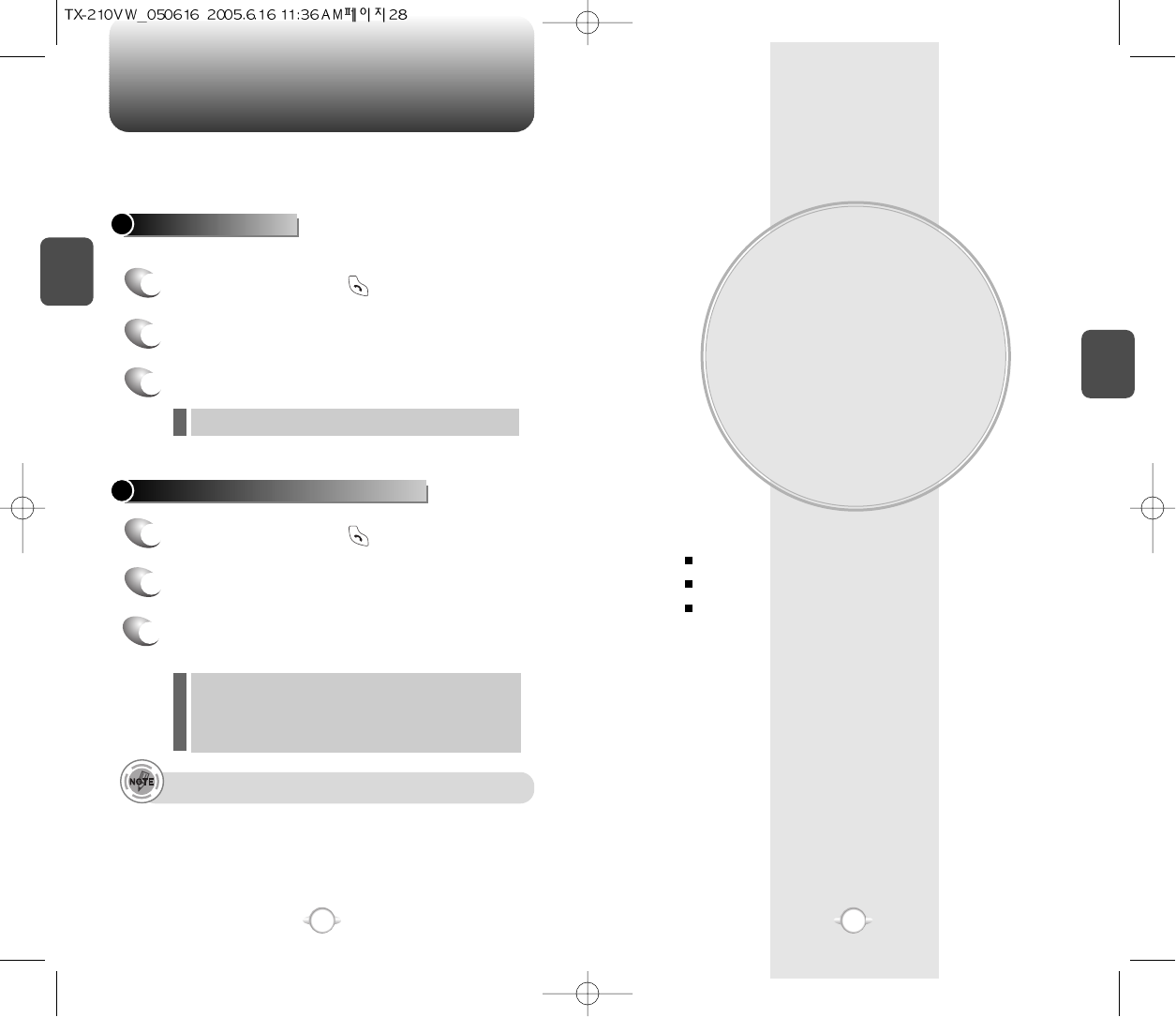
MEMORY FUNCTION
This chapter addresses memory functions including:
Chapter 3
C
H
3
29
MAKING AN EMERGENCY CALL
C
H
2
28
STORING A PHONE NUMBER
ENTERING LETTERS, NUMBERS & SYMBOLS
MAKING A CALL THROUGH THE PHONE BOOK
The 911 feature puts the phone in the Emergency Call Mode
when you dial the preprogrammed emergency number, 911.
It also operates in the lock mode and out of the service area.
The 911 call service is available even in the lock mode.
911 IN LOCK MODE
1
Enter “911” then press .
When the call ends, the phone returns to the Lock Mode.
2
The call connects.
3
The phone exits the Lock Mode for 5 minutes.
911 USING ANY AVAILABLE SYSTEM
1
Enter “911” then press .
The phone returns to the Lock Mode.
While the phone is in the emergency mode for 5 minutes,
the phone can receive an incoming call from any available
system. However, it can’t make a call.
2
The call connects.
3
The phone maintains the Emergency Mode
for 5 minutes.
l
l
l
The 911 call is not recorded in the recent call list.
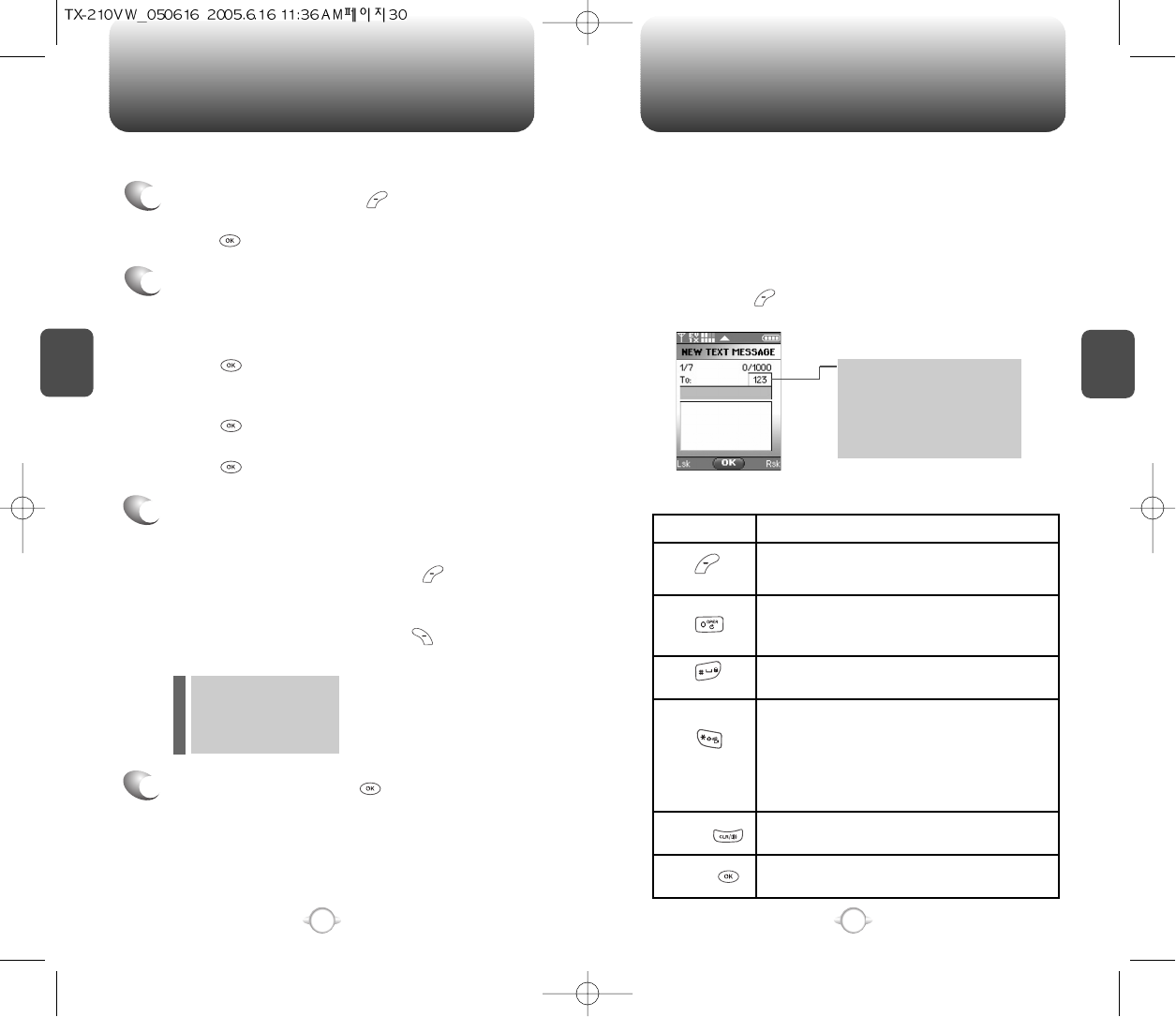
Enter a name.
Please refer to page 31 for more details on
entering letters, numbers & symbols.
To change the input mode, press [Abc].
Press the Navigation Key down to select other
options (Mobile1.2, E-mail1.2, etc...).
If entered phone number, press [OPTIONS]
to select one of the following options:
Input mode indicator
T9Word : T9 mode
Abc : Abc mode
ABC : ABC mode
123 : Number mode
Symbols : Symbol mode
STORING A PHONE NUMBER
ENTERING LETTERS, NUMBERS & SYMBOLS
C
H
3
The input mode (Alpha editor) will automatically be activated when
necessary to enter letters and numbers. As shown below, there are 4
available modes ; Standard input mode (Abc), T9 input mode
(T9Word), Numeric mode (123), and Symbol mode (Symbols).
The following illustrates the function assigned to each key in the
Alpha Editor.
31
C
H
.
3
The phone book stores up to 500 entries.
1
Enter phone # then press [SAVE] then
choose “Create New” or “Update Existing”.
Press [OK] to select. The input mode indicator appears on the upper right
of the display when letters and numbers are entered.
To select the desired input mode among the 5 modes
below, press [MODE], then enter letters and
numbers.
2
If “Create New” is selected, the phone number
will appear above a list. Press the Navigation
Key up or down to choose the type of number
you’re adding, as indicated by the icon.
Press [OK] to select. If “Update Existing” is
selected, your contact list is displayed. Choose
the entry to add the phone number to, then
press [OK]. You will then see the phone
number listed about a list.
Press [OK] to select.
3
4
To store the entry, press [SAVE].
“CONTACT SAVED” will be displayed.
30
Mode
Next
Space
Caps Lock
Clear
Send
Press to change mode.
[T9Word][Abc][ABC][123][Symbols]
Press to view the next matching word if
the highlighted word is not the word you
intended.
Press to accept a word and add a space.
Press to select a letter case of the
standard text input or T9 text input mode.
[Abc], [ABC] and [abc] indicate the
standard text input.
[T9Word], [T9WORD] and [T9word]
indicate the predictive text input.
Press to delete a character to the left of
the cursor.
Send the letters and numbers you enter.
KEY FUNCTION
lSet Speed Dial
lSet Voice Dial
lSet As Default
lAdd Pause
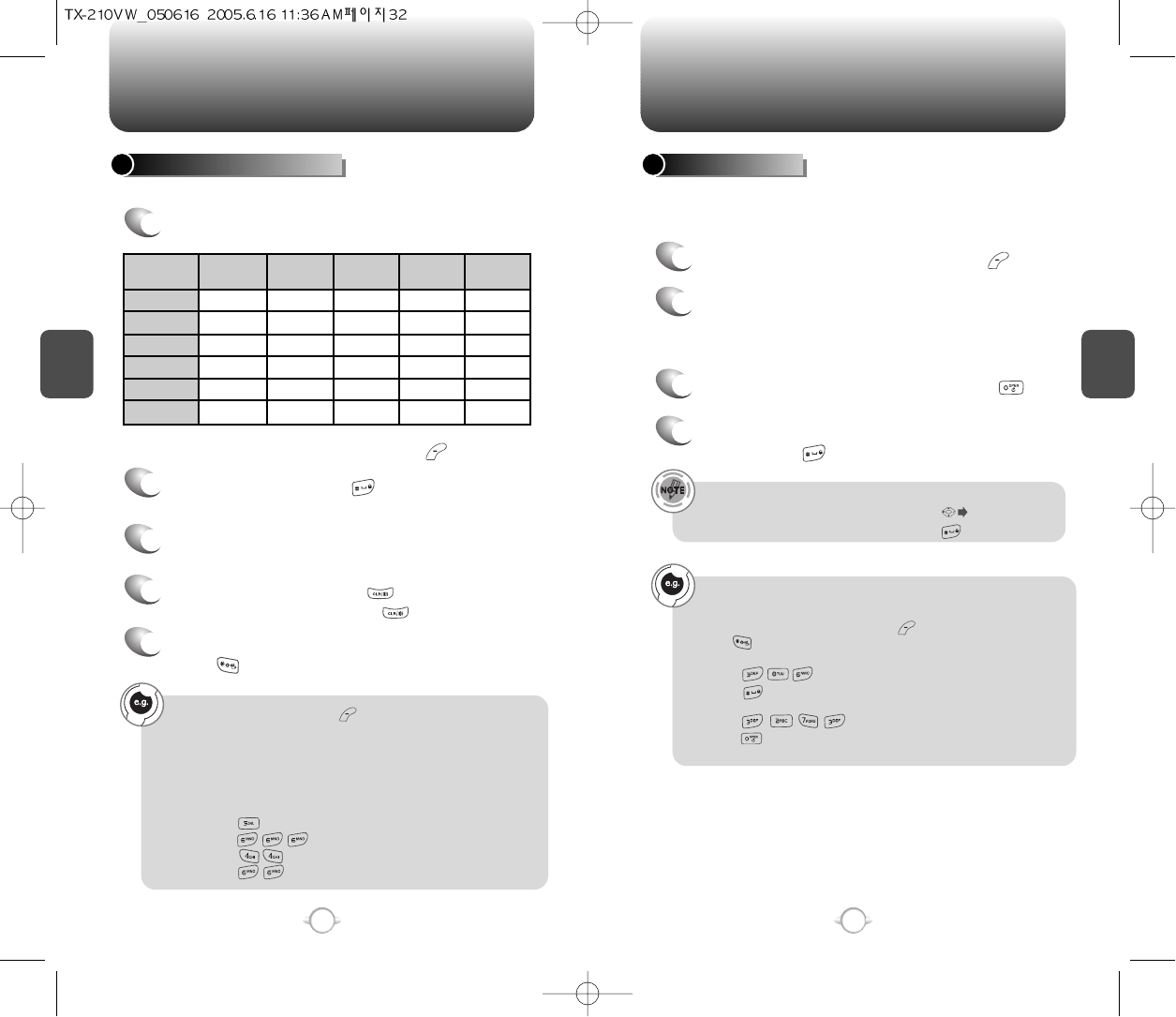
ENTERING LETTERS, NUMBERS & SYMBOLS ENTERING LETTERS, NUMBERS & SYMBOLS
C
H
3
The T9 input mode incorporates a built-in-dictionary to determine a
word based on the entered characters. A word can be entered more
quickly by pressing a key once per character.
T9 INPUT MODE
1
Select the T9Word mode by pressing [Abc].
2
Press a digit key once to enter the character
you want then enter all the characters to input
the word you want.
3
To view the next matching word, press .
To enter a compound word:
• Enter the first part of the word then press to accept it.
• Enter the last part of the word then press to enter the word.
Select Abc mode by pressing [Abc].
When you select this mode, the Abc icon appears as a visual
confirmation.
- Find the key that corresponds to the letter you want to enter.
- Press it as many times as needed for the letter to appear on the
screen.
- To enter the name “John”:
Press [ ] J
Press [ ] o
Press [ ] h
Press [ ] n
33
C
H
3
Use the digit keys to enter letters, numbers and characters.
STANDARD INPUT MODE
1
Enter letters using the key pad as follows:
2
To enter a space, press . The cursor will
automatically move to the next column.
3
Repeat until letters are entered.
There is a 16-letter limit.
4
To delete one digit, press . To delete the
entire entry, press and hold .
To change the input mode, press [Abc].
32
Key Pad
1
2ABC
3DEF
4GHI
:
9WXYZ
.
A
D
G
:
W
@
B
E
H
:
X
?
C
F
I
:
Y
!
2
3
4
:
Z
-
A
D
G
:
9
1
Time
Repetitions
2 times
Repetitions
3 times
Repetitions
4 times
Repetitions
5 times
4
To accept the matching word then enter a
space, press .
5
To change from lowercase to uppercase,
press .
To enter “Fun fare” in the T9 input mode.
- After you enter the 1st letter, press [Abc] to select T9 mode
and to choose the lower case (T9Word).
- Press and you will see “Fun” highlighted.
Press to select it.
- Press and until you see “ease” highlighted.
Press to select the next matching word, you will see “fare”
then enter a space.
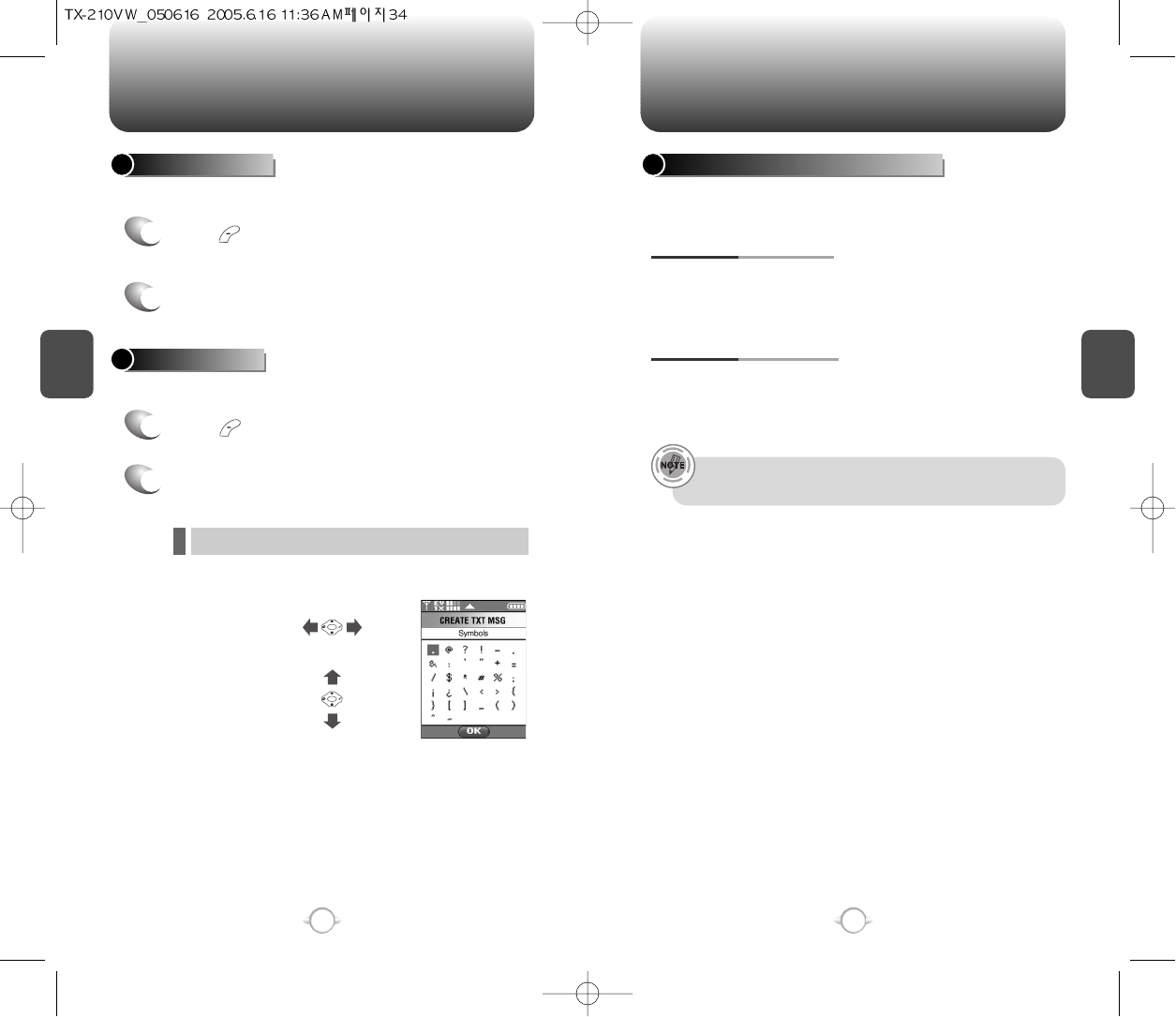
ENTERING LETTERS, NUMBERS & SYMBOLS MAKING A CALL THROUGH THE PHONE BOOK
C
H
3
NUMERIC MODE
1
Press [Abc] and scroll to the input mode to
changes to “Symbols (Symbol mode)”.
35
C
H
3
34
1
Press [Abc] and scroll to the input mode to
changes to “123 (Numeric mode)”.
2
To enter a number, press a digit key.
Press [ ],
or
Press [ ].
2
Select symbol you want to enter with the
Navigation Key.
lUse the Navigation Key to view a different line of symbols.
SYMBOL MODE
Allows you to enter numbers.
Allows you to enter symbols.
Ideal for frequently dialed numbers, this feature allows phone book
entries to be dialed via the keypad with only one or two key presses.
ONE-TOUCH/TWO-TOUCH DIALING
1-9 : Press and hold the corresponding memory
number for more than 1 second.
ONE-TOUCH DIALING:
10-22/97-99 : Press the first digit and second digits
of the memory number short and long
respectively.
TWO-TOUCH DIALING:
• If no phone number is stored in the location entered,
“Unssigned location” will appear on the screen.
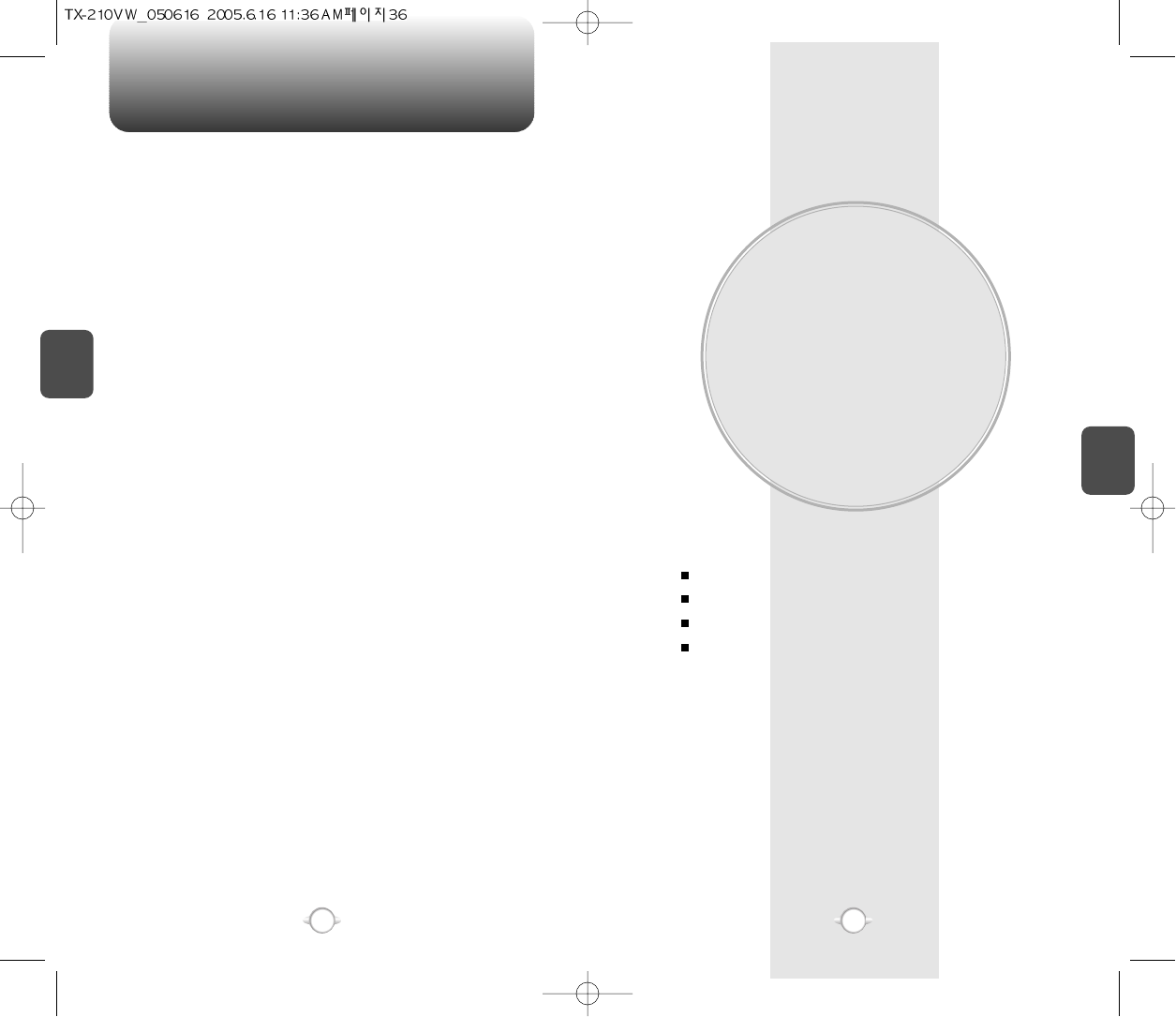
MEMO
MENU FUNCTION
This chapter addresses accessing the menu and using its functions
and features to customize your phone.
Chapter 4
C
H
4
37
C
H
3
36
CONTACTS
RECENT CALLS
SETTINGS
TOOLS
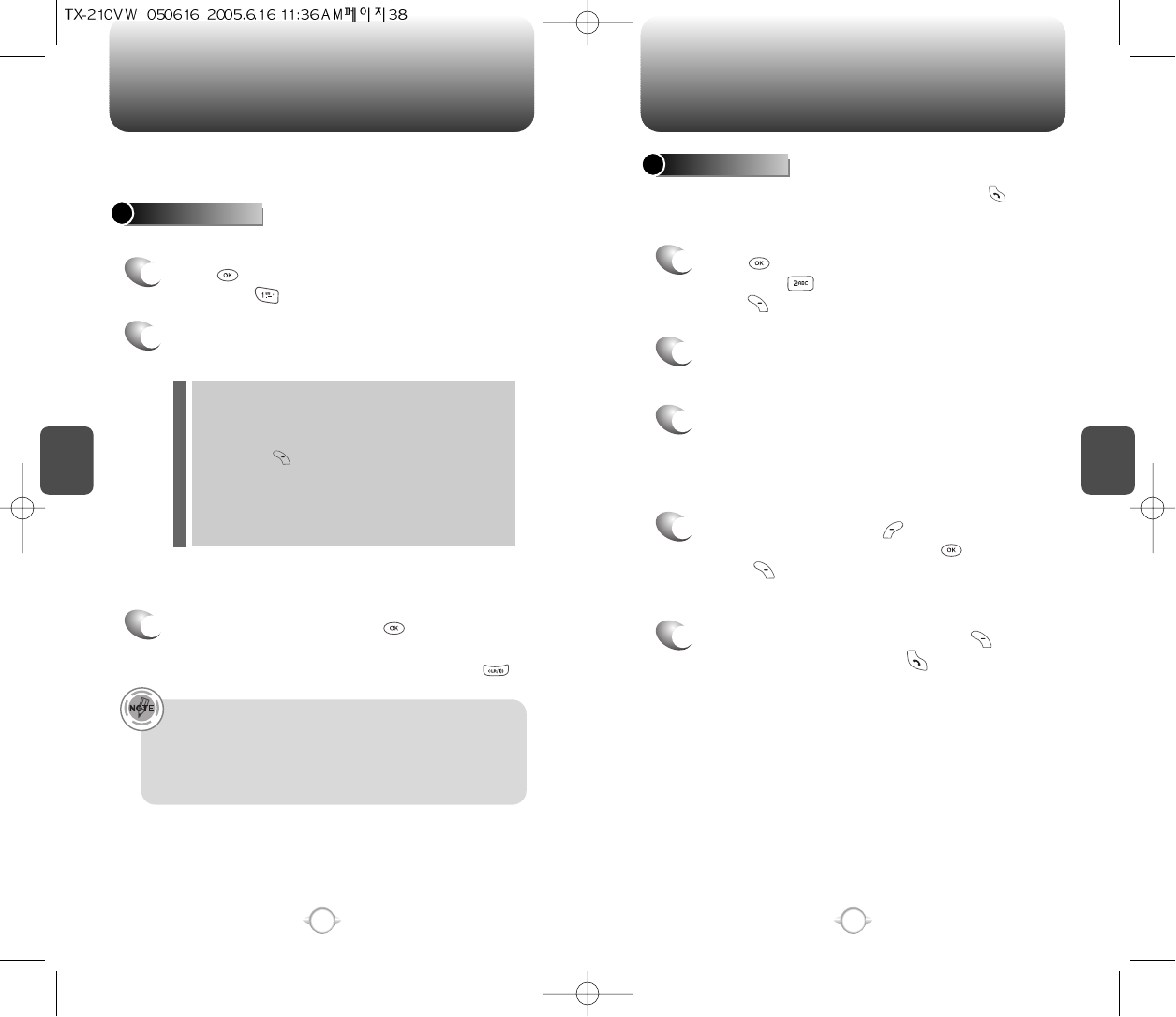
C
H
4
39
C
H
4
38
Stores up to 500 entries, each of which can be assigned to a group.
Entries can be retrieved by name or group. Retrieves an entry by name and calls by simply pressing .
You can review all the entries stored in your phone book list or
quickly find an entry by entering a name or its character string.
CONTACT LIST
CONTACTS CONTACTS
1
2
3
4
5
Press [MENU], then select “Contacts” menu,
then press “Contact List” or
press [CONTACTS].
Enter a name or its character string or scroll
through the list with the Navigation Key.
Please refer to page 31 for more details on
entering letters, numbers & symbols.
The list of names in your phone book is
displayed alphabetically.
To edit the entry, press [EDIT].
To show detail the entry, press [VIEW].
Press [OPTIONS] to 1. New Contact, 2. Erase,
3. Send Txt Msg or 4. Call.
To call the selected number, press [OPTIONS]
then select “Call” or press .
1
2
Press [MENU], then select “Contacts” menu,
then press “New Contact”.
Adds a new entry.
NEW CONTACT
To enter a name or number, use the Navigation
Key to select the phone book field.
Please refer to page 31 for more details on entering
letters, numbers & symbols.
3
3.1 To save the entry, press [SAVE].
3.2 To return to the previous page, press .
PHONE BOOK FIELDS :
Name/Mobile1/Home/Work/E-Mail1/Group/Ringtone/
Mobile2/Fax/E-Mail2.
Under “Mobile 1” or “Mobile 2”, input the phone number,
then by press [OPTIONS], you can choose from the
following:
1. Set Speed Dial
2. Set Voice Dial
3. Set As Default
4. Add Pause
l
l
• If user not input at least one field among number, e-mail then
display “Please insert at least one of phone number or E-mail”
in dialogue box.
• If name field is empty in edit contact but one of phone number
field inserted then saved so display phone number in contacts
list.
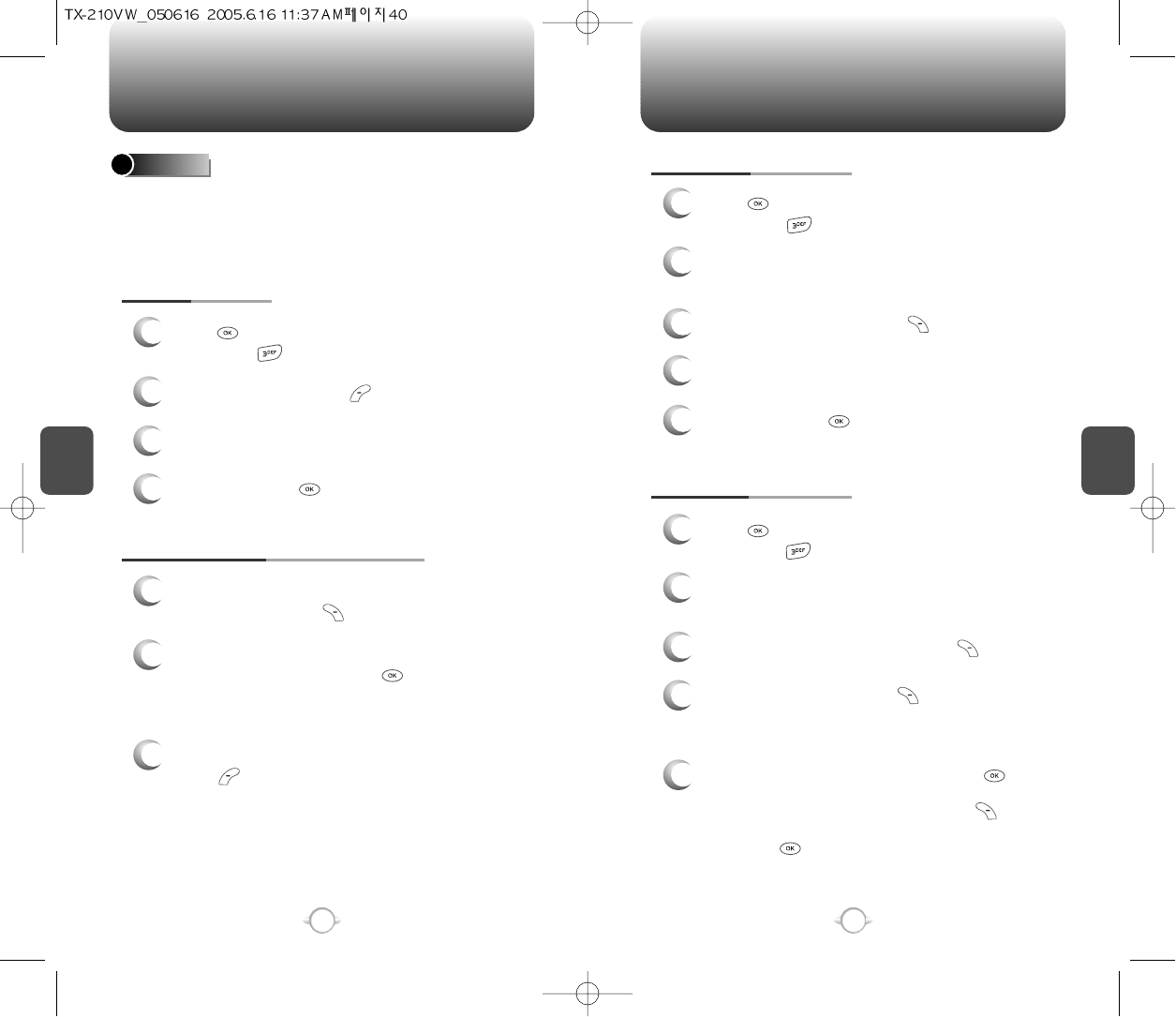
C
H
4
C
H
4
40
CONTACTS CONTACTS
41
CHANGE GROUP NAME
2
Select an existing group name that you have
added with the Navigation Key.
4
Input a new group name.
5
To save it, press [SAVE].
3
To select “Rename”, press [OPTIONS].
1
Press [MENU], then select “Contacts” menu,
then press “Groups”.
GROUPS
Allows you to classify phone entries into groups. Existing groups
include FAMILY, WORK. A maximum of 30 groups is allowed.
Predefined group that can’t rename or Erase. User can add group max
28 group. Allows the user to add group up to 10 phone number. The
user can add, change, and erase Group.
1
3
Press [MENU], then select “Contacts” menu,
then press “Groups”.
ADD NEW GROUP
Input a new group name.
4
To save it, press [SAVE].
2
To select “New”, press [NEW].
1
Press [MENU], then select “Contacts” menu,
then press “Groups”.
1
3
To assign phone numbers to a Group,
select “Add”, press [OPTION].
ASSIGN PHONE NUMBER TO GROUP
Select the contact for the group then
press [DONE]. “Contact Added to (Group
Name)” will be displayed.
Repeat for each location for the Group.
2
“unassigned” locations appear.
Select a location and press [OK].
Your phone book entries will be displayed in
alphabetical order.
SEND TXT MSG. GROUP
2
Select an existing group name with the
Navigation Key.
4
Input a “Message”, press [OPTION] to
select “Save as Drafts”, “Call Back #” and
“Priority Level”.
5
3
To select “Send Txt Msg.”, press [OPTIONS].
5.1. To send the text message, press [SEND].
5.2. To save the text message, press [OPTIONS],
then select “Save as Drafts”, then
press [OK].
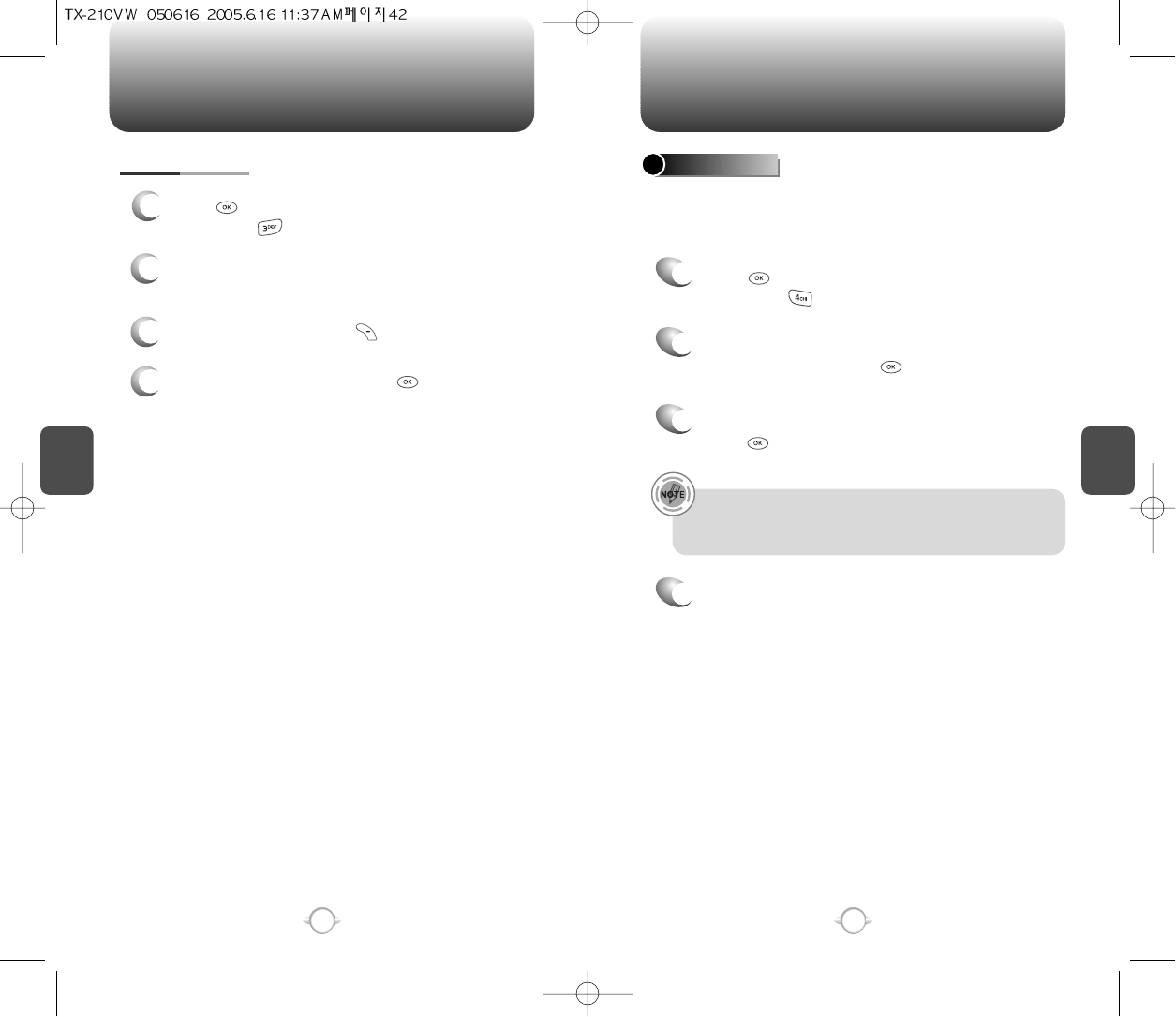
C
H
4
C
H
4
42
CONTACTS CONTACTS
43
In idle mode, calls can be placed to numbers stored in speed dial by
pressing & holding the location number on the key pad. For a 2-digit
location number, press the first number, then press and hold the
second number.
SPEED DIALS
1
2
To assign a phone number to a location, select
the location then press [SET].
3
Select the contact with the Navigation Key then
press [OK].
4
“SPEED DIAL SET” will be displayed.
• “Unassigned” appears if the location is available.
• To call an assigned number, press & hold the last digit of the
speed dial #.
ERASE GROUP
2
Select an existing group name with the
Navigation Key.
3
To select “Erase”, press [OPTIONS].
4
Select “Yes” to erase it, press [OK].
1
Press [MENU], then select “Contacts” menu,
then press “Groups”.
Press [MENU], then select “Contacts” menu,
then press “Speed Dials”.
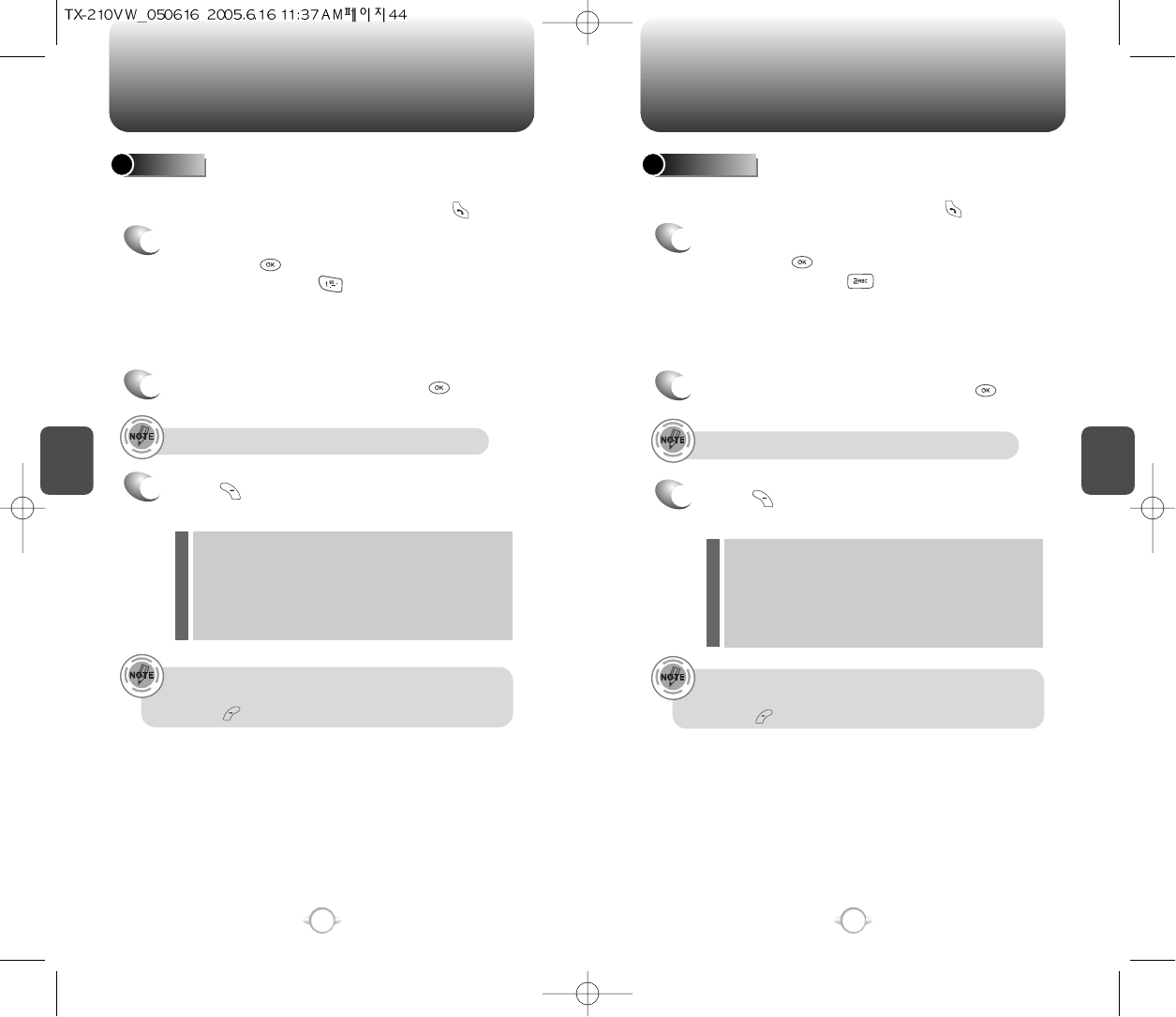
C
H
4
45
C
H
4
44
RECENT CALLS RECENT CALLS
Displays information about the 20 most recently missed calls.
Place a call to a missed call number by simply pressing .
To see a list of the 20 most recently missed
calls, press [MENU], then select “Recent
Calls” menu, press “Missed”. If the
number is already stored in your phone book,
only the name appears. If the number is not
stored, only the phone number appears.
MISSED
1
2
To view missed call details, press [OPEN].
Call details include date, time and phone number.
• After 20 missed calls, the oldest call will automatically
be erased from the history.
• Press [MESSAGE], to send the Txt message.
3
Save : To store the phone number in your phone book.
Details : To view the caller’s information.
Erase : To erase a missed calls list.
Lock/Unlock : To lock or unlock missed calls list.
Erase All : To erase all missed calls list.
View Timers : To display usage time.
l
l
l
l
l
l
Press [OPTIONS] and select “SAVE” to
save it or select “Erase” to delete it.
Call details include date, time and phone number.
• After 20 received calls, the oldest call will automatically
be erased from the history.
• Press [MESSAGE], to send the Txt message.
Displays information about the 20 most recently answered calls.
Place a call to a received call by simply pressing .
RECEIVED
1
To see a list of the 20 most recently answered
calls, press [MENU], then select “Recent
Calls” menu, press “Received”. If the
number is already stored in your phone book,
only the name appears. If the number is not
stored, only the phone number appears.
2
To view incoming call details, press [OPEN].
3
Save : To store the phone number in your phone book.
Details : To view the caller’s information.
Erase : To erase a received calls list.
Lock/Unlock : To lock or unlock received calls list.
Erase All : To erase all received calls list.
View Timers : To display usage time.
l
l
l
l
l
l
Press [OPTIONS] and select “SAVE” to
save it or select “Erase” to delete it.
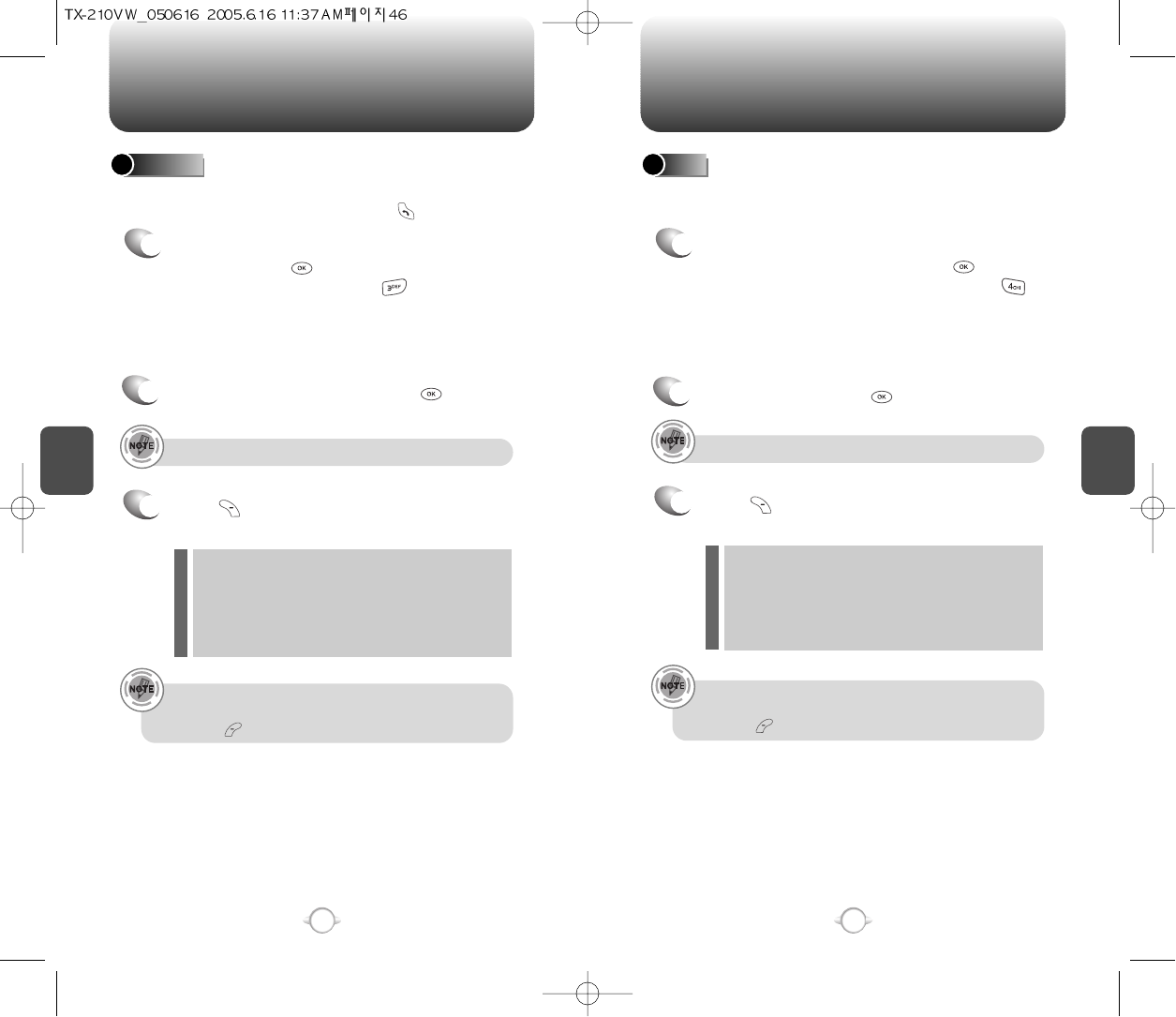
C
H
4
47
C
H
4
46
RECENT CALLS RECENT CALLS
Call details include type of call, date, time and phone number.
• After 20 dialed calls, the oldest call will automatically
be erased from the history.
• Press [MESSAGE], to send the Txt message.
Displays information about the 20 most recently dialed numbers.
Place a call to a dialed call by simply pressing .
DIALED
1
To see a list of the 20 most recently dialed
numbers, press [MENU], then select
“Recent Calls” menu, press “Dialed”.
If the number is already stored in your phone
book, only the name appears. If the number is
not stored, only the phone number appears.
2
To view dialed call details, press [OPEN].
3
Save : To store the phone number in your phone book.
Details : To view the caller’s information.
Erase : To erase a dialed calls list.
Lock/Unlock : To lock or unlock dialed calls list.
Erase All : To erase all dialed calls list.
View Timers : To display usage time.
l
l
l
l
l
l
Press [OPTIONS] and select “SAVE” to
save it or select “Erase” to delete it.
Call details include type of call, date, time and phone number.
• After the 20 received, dialed or missed calls, the oldest call
will automatically be erased from the history.
• Press [MESSAGE], to send the message.
Displays information about the most recent incoming, outgoing and
missed calls.
ALL
1
To see a list of the 60 most recent incoming,
outgoing and missed calls, press [MENU],
then select “Recent Calls” menu, press “All”.
If the number is already stored in your phone book,
only the name appears. If the number is not stored,
only the phone number appears.
2
3
To view details, press [OPEN].
Save : To store the phone number in your phone book.
Details : To view the caller’s information.
Erase : To erase a recent calls list.
Lock/Unlock : To lock or unlock recent calls list.
Erase All : To erase all recent calls list.
View Timers : To display usage time.
l
l
l
l
l
l
Press [OPTIONS] and select “SAVE” to
save it or select “Erase” to delete it.
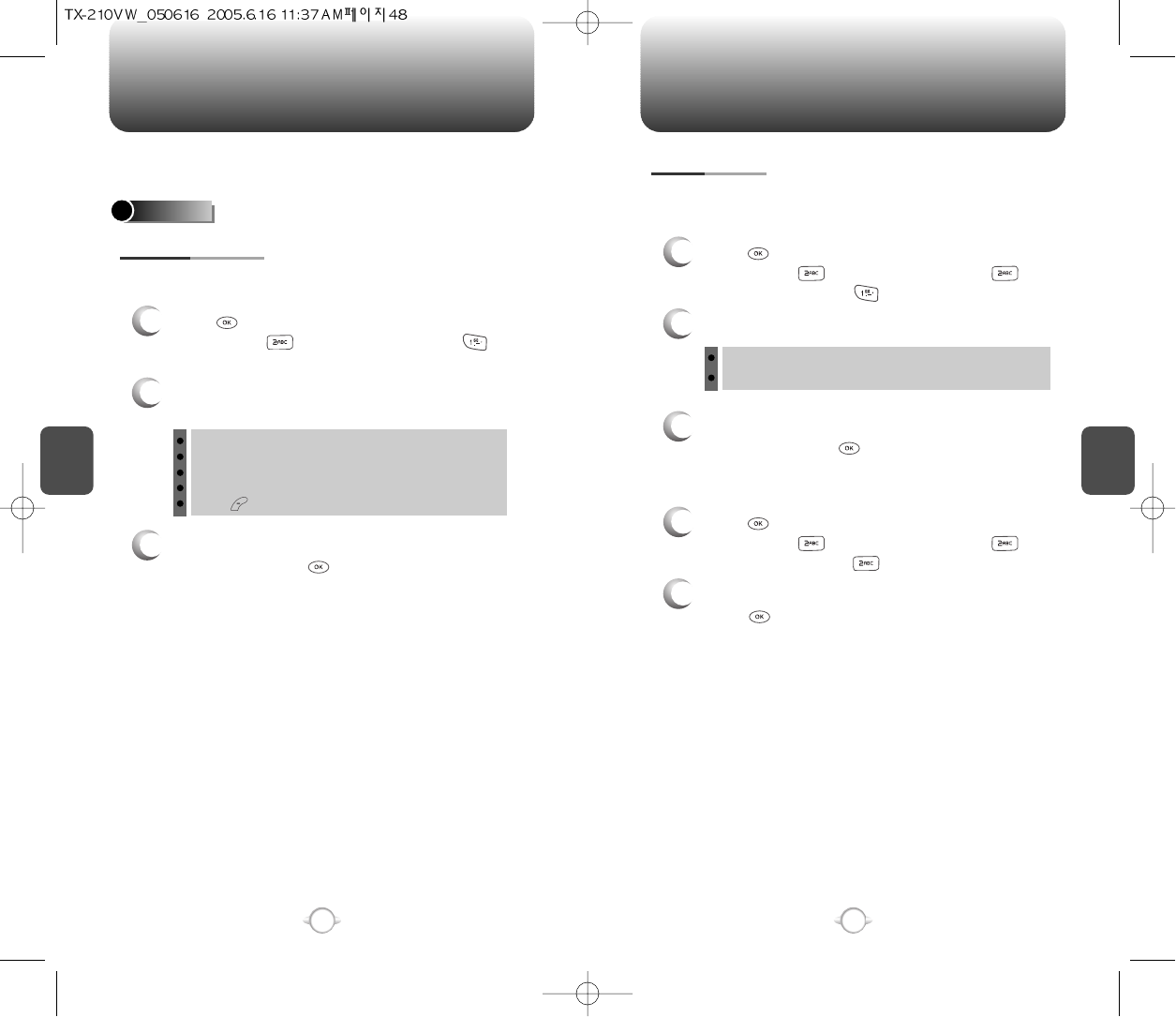
C
H
4
4948
C
H
4
SETTINGSSETTINGS
Controls the Ringer volume and alerts you to incoming calls in the
modes listed in the gray box below.
Customizes your phone and optimizes performance through a variety
of settings.
SOUNDS
MASTER VOUME
2
Select one of the following options by pressing
the Navigation Key to the right.
3
Select one of the available ring types.
To confirm, press [OK].
1
Press [MENU], then select “Settings & Tools”
menu, press “Sounds” then select
“Master Volume”.
All Off
Alarm Only
Vibrate Only
Low, Med Low, Med, Med High, High.
Press to play sound.
To select a ringer type for incoming calls:
CALL SOUND
2
Select your desired ringer type.
3
Select one of the available ring types.
To confirm, press [OK].
1
Press [MENU], then select “Settings & Tools”
menu, press “Sounds” then select
“Call Sound”, press “Call Ringtone”.
Up or Down key : Select “Ringer”.
Press Play/Pause to Play/Pause the ringer.
CALL RINGTONE
2
Select “On” or “Off” with the Navigation Key then
press [OK] to save it.
1
Press [MENU], then select “Settings & Tools”
menu, press “Sounds” then select
“Call Sound”, press “Call Vibrate”.
CALL VIBRATE
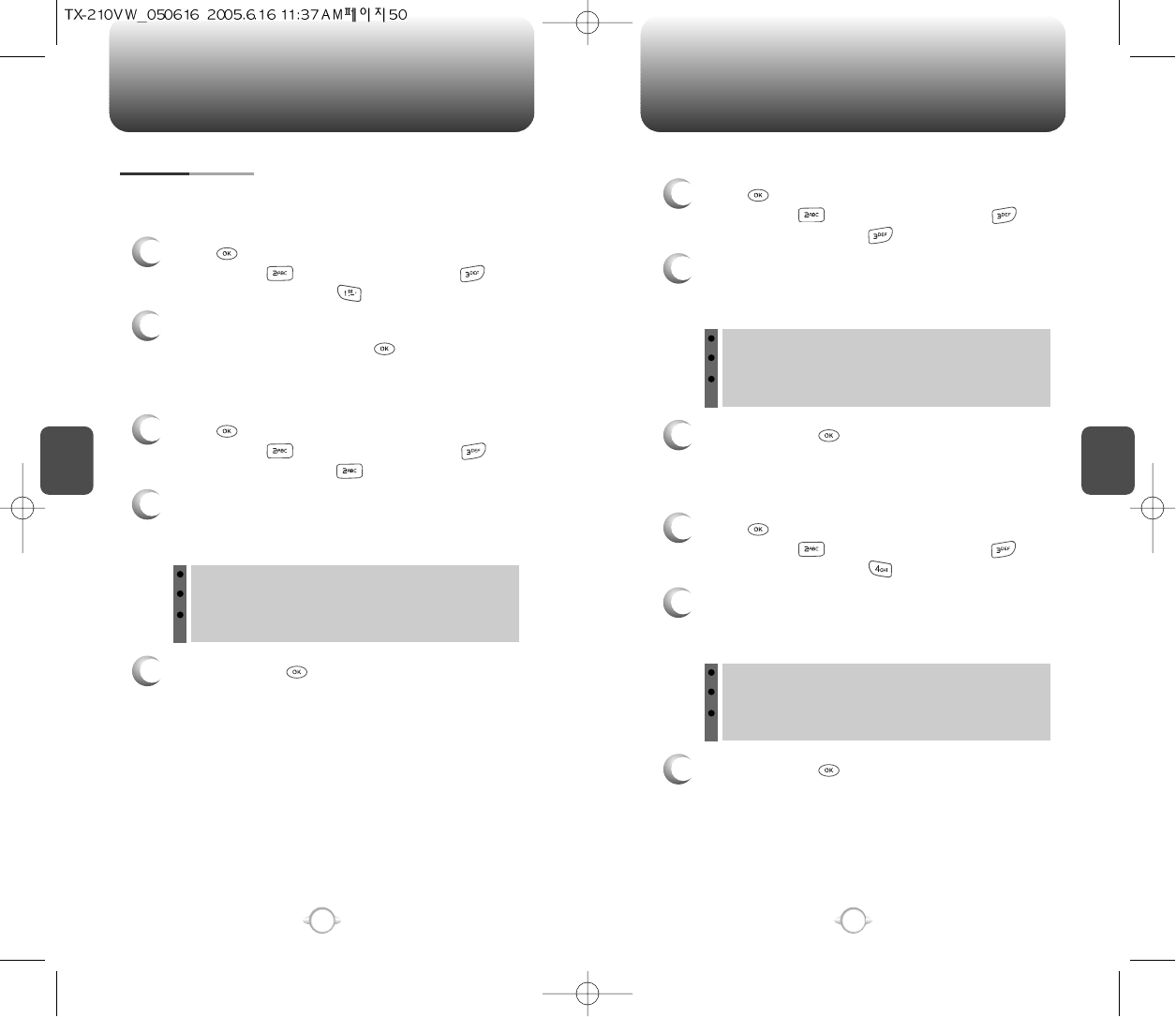
C
H
4
51
C
H
4
50
SETTINGS
50
SETTINGS
When selected, this setting alerts you to the following handset changes:
ALERT SOUNDS
1
Press [MENU], then select “Settings & Tools”
menu, press “Sounds” then select
“Alert Sounds”, press “ERI Tones”.
ERI TONES
2
Select “Beep”, “Voice” or “Off” with the
Navigation Key then press [OK] to save it.
1
Press [MENU], then select “Settings & Tools”
menu, press “Sounds” then select
“Alert Sounds”, press “TXT Message”.
TXT MESSAGE
2
Select “Tone”, “Vibrate” or “Reminder” with the
Navigation Key then select one of the following
options by pressing the Navigation Key.
Tone : Select your desired ringer type.
Vibrate : Select “On” or “Off”.
Reminder : Select “Once”, “Every 2 Minutes”,
“Every 15 Minutes” or “Off”.
3
To save, press [OK].
1
Press [MENU], then select “Settings & Tools”
menu, press “Sounds” then select
“Alert Sounds”, press “Pix Message”.
PIX MESSAGE
2
Select “Tone”, “Vibrate” or “Reminder” with the
Navigation Key then select one of the following
options by pressing the Navigation Key.
Tone : Select your desired ringer type.
Vibrate : Select “On” or “Off”.
Reminder : Select “Once”, “Every 2 Minutes”,
“Every 15 Minutes” or “Off”.
3
To save, press [OK].
1
Press [MENU], then select “Settings & Tools”
menu, press “Sounds” then select
“Alert Sounds”, press “Voice Message”.
VOICE MESSAGE
2
Select “Tone”, “Vibrate” or “Reminder” with the
Navigation Key then select one of the following
options by pressing the Navigation Key.
Tone : Select your desired ringer type.
Vibrate : Select “On” or “Off”.
Reminder : Select “Once”, “Every 2 Minutes”,
“Every 15 Minutes” or “Off”.
3
To save, press [OK].
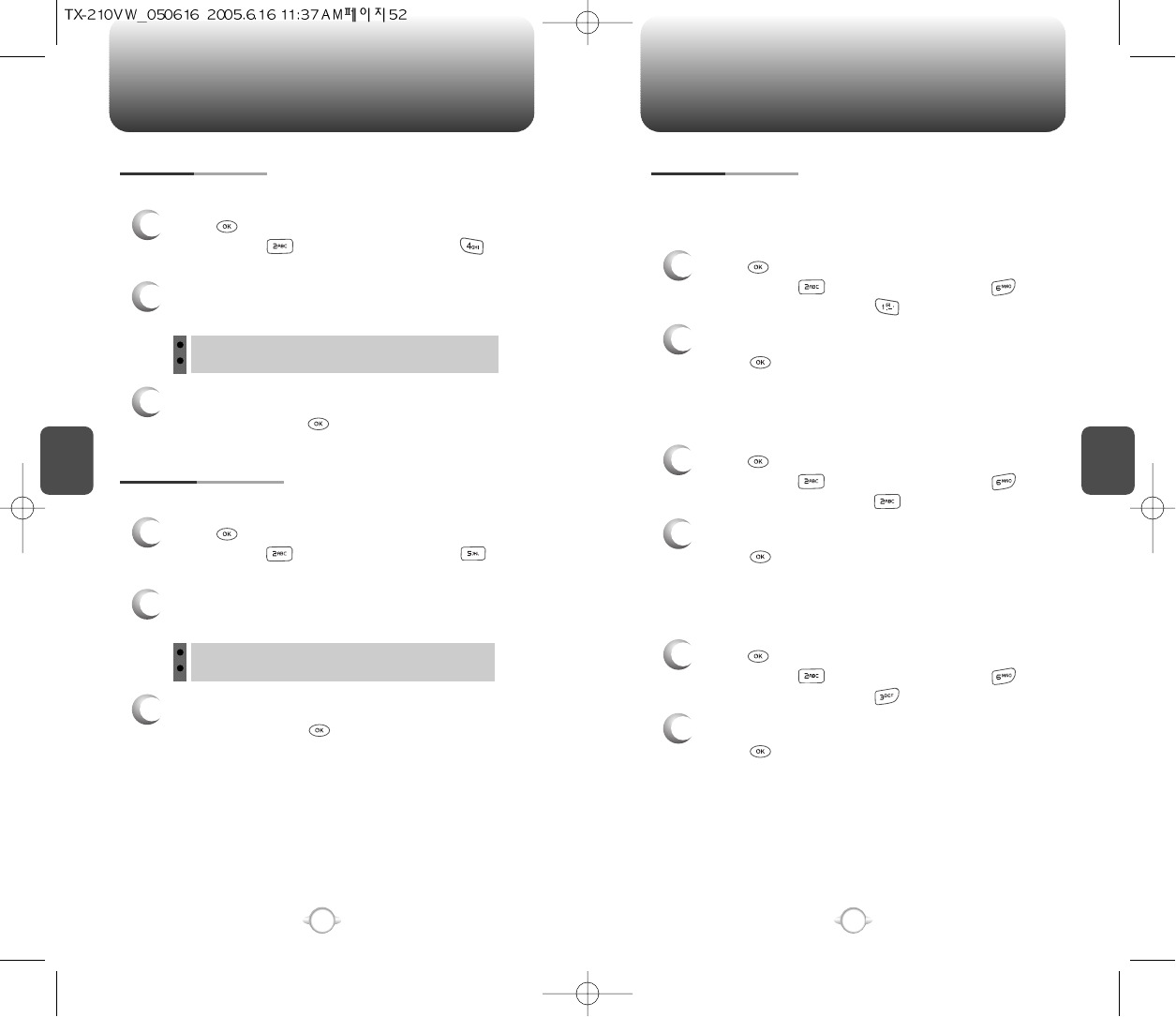
C
H
4
53
C
H
4
52
SETTINGS
52
SETTINGS
To adjust key pad tone:
KEYPAD VOLUME
2
Select one of the following options by pressing
the Navigation Key to the right.
3
Select one of the available ring types.
To confirm, press [OK].
1
Press [MENU], then select “Settings & Tools”
menu, press “Sounds” then select
“Keypad Volume”.
Off
Low, Med Low, Med, Med High, High
To adjust earpiece volume:
EARPIECE VOLUME
2
Select one of the following options by pressing
the Navigation Key to the right.
3
Select one of the available ring types.
To confirm, press [OK].
1
Press [MENU], then select “Settings & Tools”
menu, press “Sounds” then select
“Earpiece Volume”.
Low
Med Low, Med, Med High, High
Sounds an alert when leaving a service area and entering a roaming
service area.
SERVICE ALERTS
1
Press [MENU], then select “Settings & Tools”
menu, press “Sounds” then select
“Service Alerts”, press “Service Change”.
SERVICE CHANGE
2
Select “On” or “Off” with the Navigation Key then
press [OK] to save it.
Sounds an alert every minute during a call.
1
Press [MENU], then select “Settings & Tools”
menu, press “Sounds” then select
“Service Alerts”, press “Minute Beep”.
MINUTE BEEP
2
Select “On” or “Off” with the Navigation Key then
press [OK] to save it.
Notifies you that a call has been successfully placed.
1
Press [MENU], then select “Settings & Tools”
menu, press “Sounds” then select
“Service Alerts”, press “Call Connect”.
CALL CONNECT
2
Select “On” or “Off” with the Navigation Key then
press [OK] to save it.
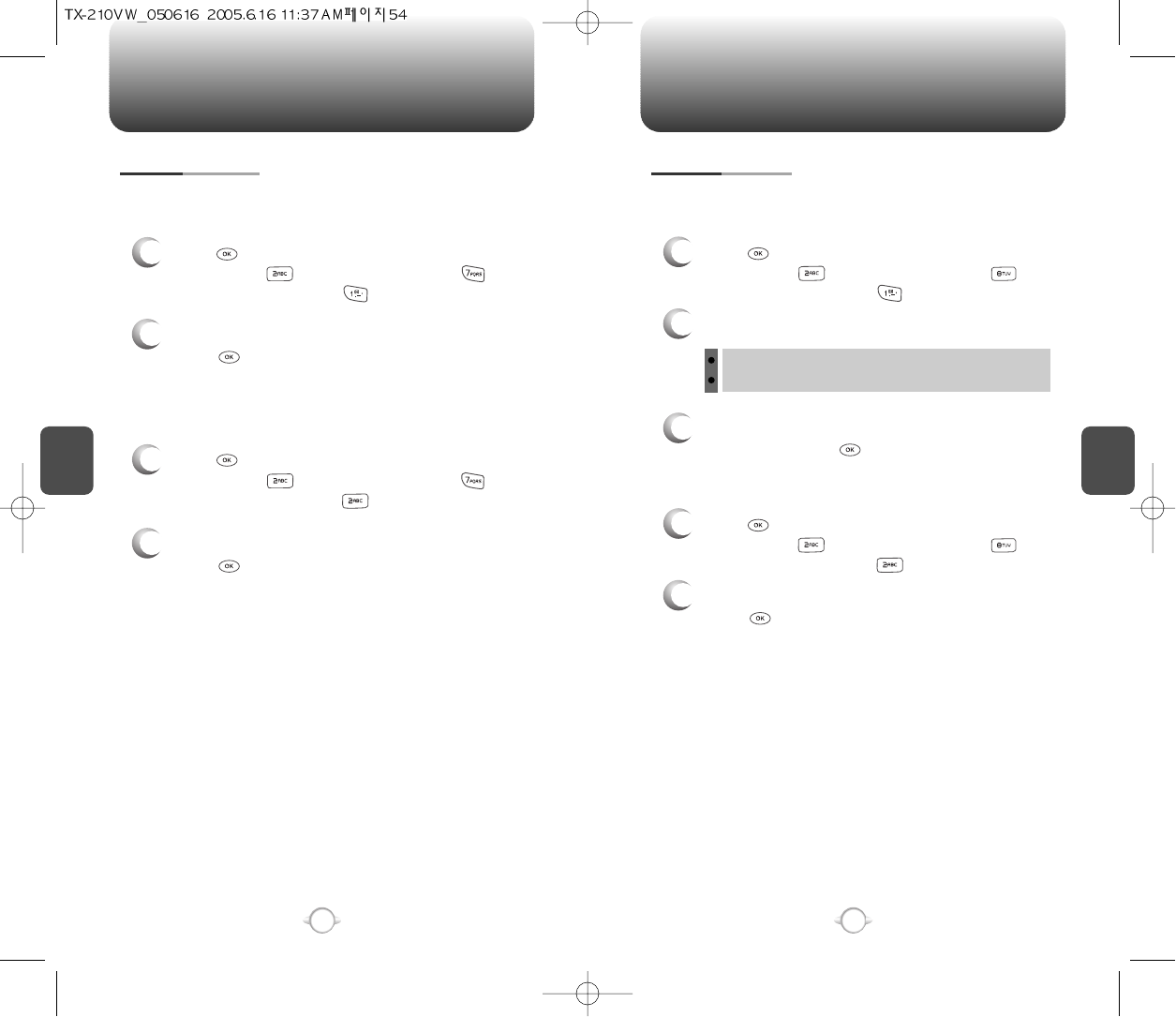
SETTINGS SETTINGS
C
H
4
55
C
H
4
54
Allows you to activate/deactivate the power on tones.
POWER ON/OFF
1
Press [MENU], then select “Settings & Tools”
menu, press “Sounds” then select
“Power On/Off”, press “Power On”.
POWER ON
2
Select “On” or “Off” with the Navigation Key then
press [OK] to save it.
Allows you to activate/deactivate the power off tones.
1
Press [MENU], then select “Settings & Tools”
menu, press “Sounds” then select
“Power On/Off”, press “Power Off”.
POWER OFF
2
Select “On” or “Off” with the Navigation Key then
press [OK] to save it.
To select a ringer type for alarm sound:
ALARM SOUNDS
2
Select your desired ringer type.
3
Select one of the available ring types.
To confirm, press [OK].
1
Press [MENU], then select “Settings & Tools”
menu, press “Sounds” then select
“Alarm Sounds”, press “Alarm Tone”.
ALARM TONE
2
Select “On” or “Off” with the Navigation Key then
press [OK] to save it.
1
Press [MENU], then select “Settings & Tools”
menu, press “Sounds” then select
“Alarm Sounds”, press “Alarm Vibrate”.
ALARM VIBRATE
Up or Down key : Select “Ringer”.
Press Play/Pause to Play/Pause the ringer.
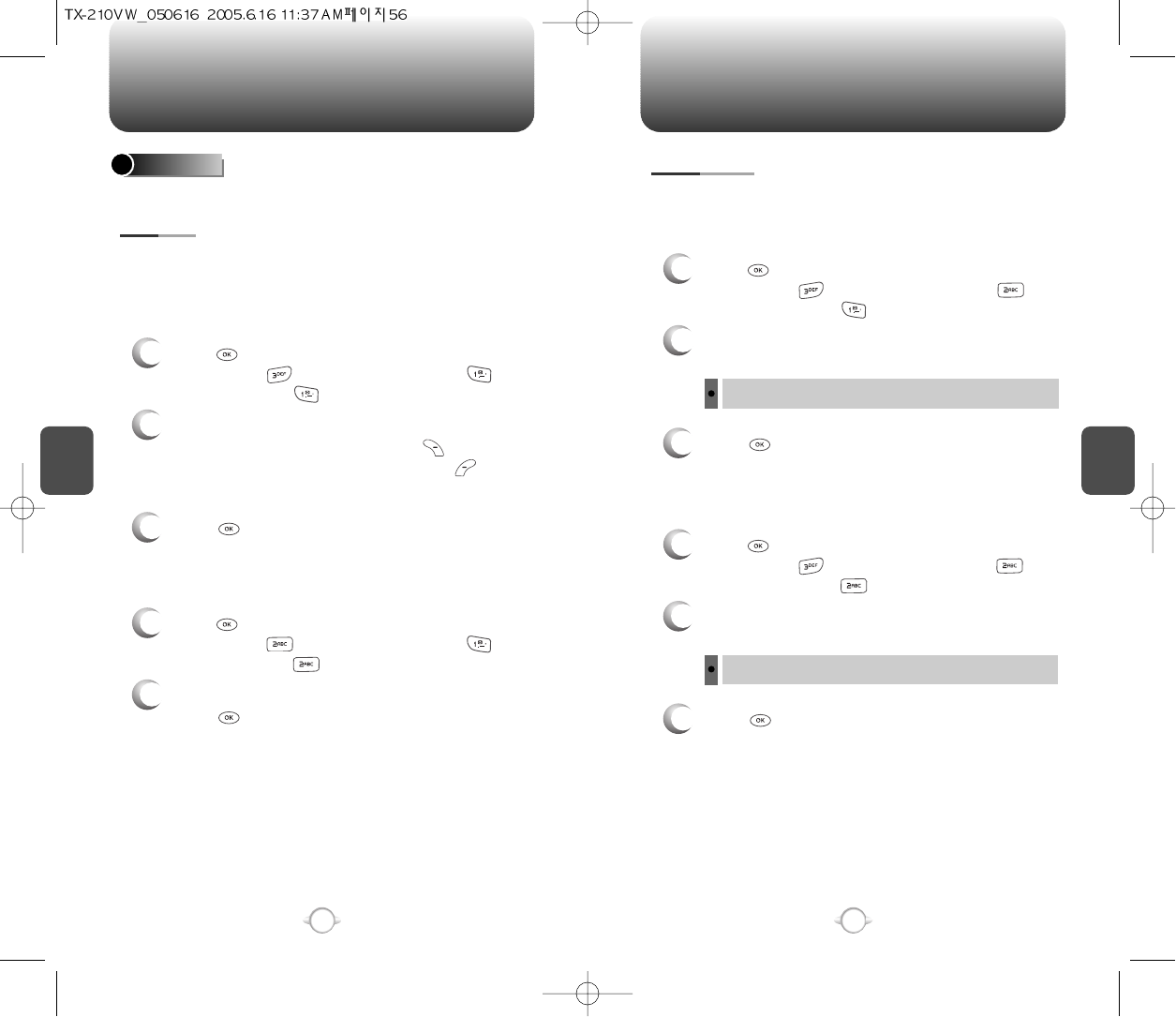
SETTINGS SETTINGS
C
H
4
57
C
H
4
56
Allows you to customize the display.
DISPLAYS
To input a personal/ERI banner greeting:
The text greeting can be up to 16 characters and is displayed on
your phone’s screen in standby mode.
BANNER
2
Enter a new personal greeting.
To change the input mode, press [Abc].
To return to the previous page, press
[CANCEL].
3
Press [OK] to save it.
1
Press [MENU], then select “Settings & Tools”
menu, press “Displays” then select
“Banner”, press “Personal”.
PERSONAL
2
Select “On” or “Off” with the Navigation Key then
press [OK] to save it.
1
Press [MENU], then select “Settings & Tools”
menu, press “Displays” then select
“Banner”, press “ERI Banner”.
ERI BANNER
Backlights the display and key pad and activates dimming for easy
viewing in dark places.
BACKLIGHT
2
Select one of the following options with the
Navigation Key.
3
Press [OK] to save it.
1
Press [MENU], then select “Settings & Tools”
menu, press “Displays” then select
“Backlight”, press “LCD”.
LCD
Always On, Always Off, 5 Seconds, 15 Seconds, 30 Seconds.
2
Select one of the following options with the
Navigation Key.
3
Press [OK] to save it.
1
Press [MENU], then select “Settings & Tools”
menu, press “Displays” then select
“Backlight”, press “Keypad”.
KEYPAD
Always On, Always Off, 5 Seconds, 15 Seconds, 30 Seconds.
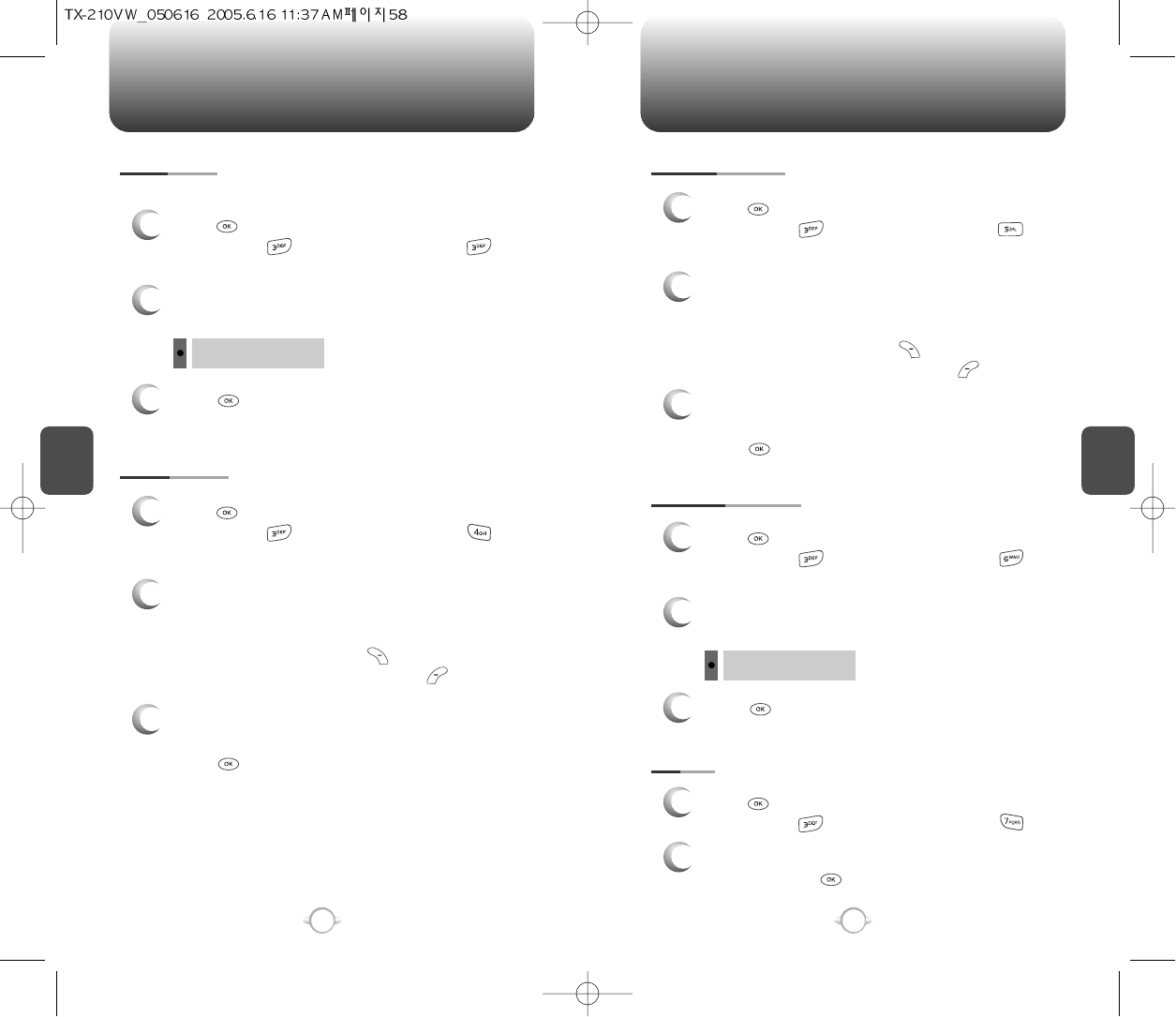
SETTINGS SETTINGS
C
H
4
59
C
H
4
58
To adjust the display contrast:
CONTRAST
3
Press [OK] to save it.
1
Press [MENU], then select “Settings & Tools”
menu, press “Displays” then select
“Contrast”.
2
Select one of the following options with the
Navigation Key.
Leve 1 ~ Leve 5
WALLPAPER
1
Press [MENU], then select “Settings & Tools”
menu, press “Displays” then select
“Wallpaper”.
2
Select Default to choose a pre-installed display,
Downloads or Pix # to choose a display you
have downloaded to your phone.
To launch “BREW”, press [GET NEW].
To expand selected image, press [VIEW].
3
Select a display from the Animation and the
Graphic list using the Navigation Key and
press [SET] to save it.
DISPLAY THEMES
3
Press [OK] to save it.
1
Press [MENU], then select “Settings & Tools”
menu, press “Displays” then select
“Display Themes”.
2
Select one of the following options with the
Navigation Key.
Theme 1 ~ Theme 4
SCREENSAVER
1
Press [MENU], then select “Settings & Tools”
menu, press “Displays” then select
“Screensaver”.
2
Select Default to choose a pre-installed display,
Downloads or Pix # to choose a display you
have downloaded to your phone.
To launch “BREW”, press [GET NEW].
To expand selected image, press [VIEW].
3
Select a display from the Animation and the
Graphic list using the Navigation Key and
press [SET] to save it.
FONTS
1
Press [MENU], then select “Settings & Tools”
menu, press “Displays” then select “Fonts”.
2
Select “Normal” or “Large” with the Navigation
Key then press [OK] to save it.
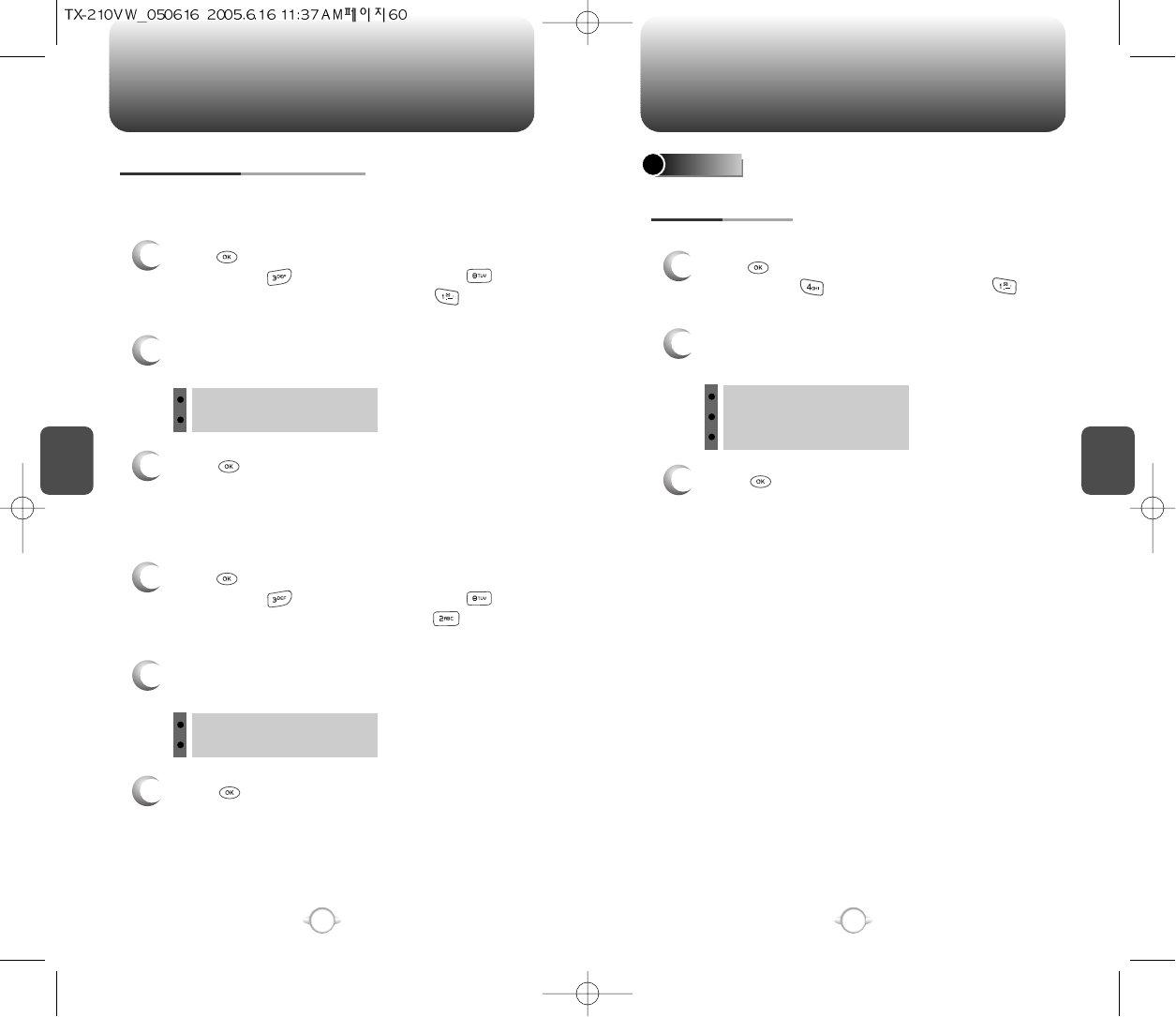
SETTINGS SETTINGS
C
H
4
61
C
H
4
60
Allows you to the power on animation.
POWER ON/OFF ANIMATIONS
1
Press [MENU], then select “Settings & Tools”
menu, press “Displays” then select
“Power On/Off Animations”, press
“Power On Animation”.
POWER ON ANIMATION
Allows you to the power off animation.
1
Press [MENU], then select “Settings & Tools”
menu, press “Displays” then select
“Power On/Off Animations”, press
“Power Off Animation”.
POWER OFF ANIMATION
3
Press [OK] to save it.
2
Select one of the following options with the
Navigation Key.
Animation 1
Animation 2
3
Press [OK] to save it.
2
Select one of the following options with the
Navigation Key.
Animation 1
Animation 2
SYSTEM
Selects the Preferred System.
SYSTEM SELECT
1
Press [MENU], then select “Settings & Tools”
menu, press “System” then select
“System Select”.
3
Press [OK] to save it.
2
Select one of the following options with the
Navigation Key.
Automatic B
Automatic A
Home Only
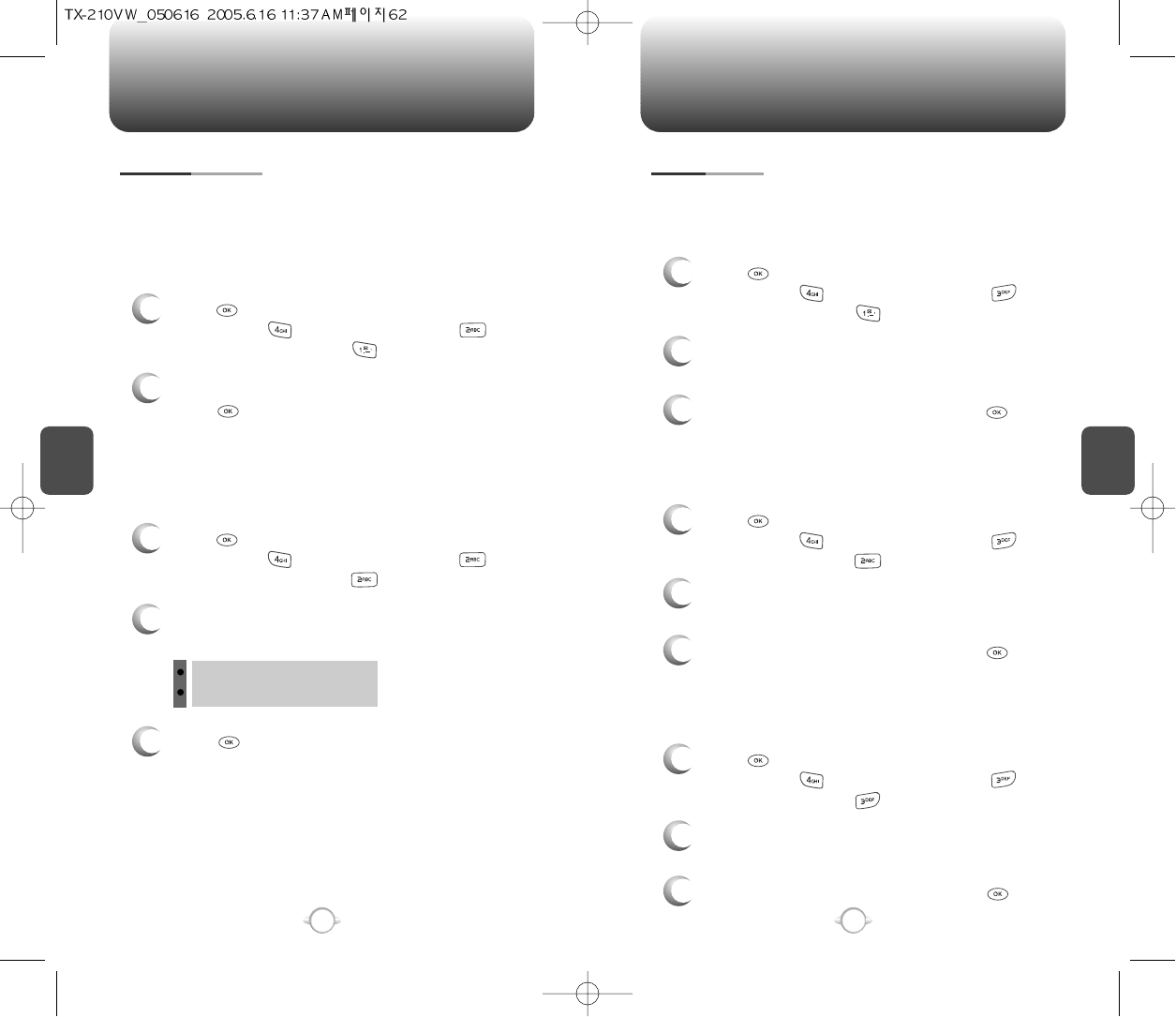
SETTINGS SETTINGS
C
H
4
63
C
H
4
62
Enables Auto NAM (Number Assignment Modules) or manually
selects a NAM.
NAM SELECTION
1
Press [MENU], then select “Settings & Tools”
menu, press “System” then select
“NAM Selection”, press “Auto NAM”.
3
Press [OK] to save it.
2
Select one of the following options with the
Navigation Key.
NAM 1 - VERIZON
NAM 2 - VERIZON
Automatically switches phone to proper NAM when you have multiple
NAM registrations.
AUTO NAM
2
Select “Yes” or “No” with the Navigation Key then
press [OK] to save it.
1
Press [MENU], then select “Settings & Tools”
menu, press “System” then select
“NAM Selection”, press “Change NAM”.
Changes the NAM used by the phone when you have multiple
registrations.
CHANGE NAM
Displays the information of your phone:
DEVICE INFO
1
Press [MENU], then select “Settings & Tools”
menu, press “System” then select
“Device Info”, press “My Number”.
Displays the your phone number (MDN/MIN number and provider) :
MY NUMBER
3
To return to the previous page, press [OK].
3
To return to the previous page, press [OK].
1
Press [MENU], then select “Settings & Tools”
menu, press “System” then select
“Device Info”, press “SW Version”.
Displays the (Software/PRL/ERI/Browser/Get It Now) version.
SW VERSION
2
You are to see the Indicator Icons of your
cellular telephone.
2
You are to see the version of software,
hardware and others.
2
You are to see the MDN/MIN number and
provider name.
3
To return to the previous page, press [OK].
1
Press [MENU], then select “Settings & Tools”
menu, press “System” then select
“Device Info”, press “Icon Glossary”.
Displays the Indicator Icons of your cellular telephone.
ICON GLOSSARY
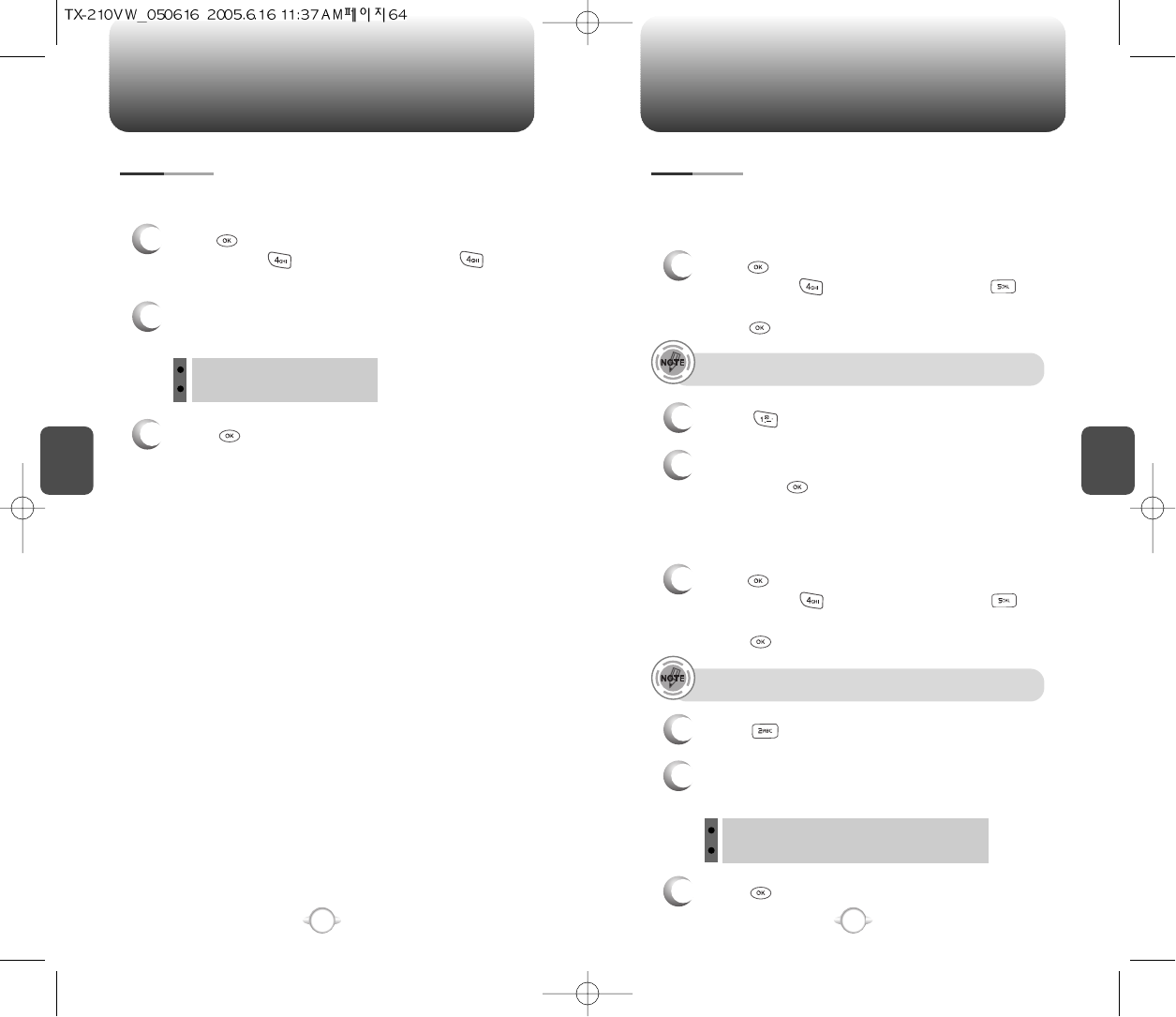
SETTINGS SETTINGS
C
H
4
65
C
H
4
64
To determine whether or not the network system can detect your
position:
LOCATION
1
Press [MENU], then select “Settings & Tools”
menu, press “System” then select
“Location”.
3
Press [OK] to save it.
2
Select one of the following options with the
Navigation Key.
Location On
E911 Only
4
Press [OK] to save it.
Device : Lock, Unlock, On Power Up
Location : Lock, Unlock
Prevents unauthorized use of your phone. The following settings can
be restricted:
Prevents the phone from being used without entering the password first.
SECURITY
1
Press [MENU], then select “Settings & Tools”
menu, press “System” then select
“Security”, then enter your password,
press [OK].
3
Select “On” or “Off” with the Navigation Key
then press [OK] to save it.
2
Select “Common Code”.
COMMON CODE
The default password is the last 4 digit of your phone number.
1
Press [MENU], then select “Settings & Tools”
menu, press “System” then select
“Security”, then enter your password,
press [OK].
3
Select “Device” or “Location” then select one of
the following options with the Navigation Key.
2
Select “Lock Mode”.
LOCK MODE
The default password is the last 4 digit of your phone number.
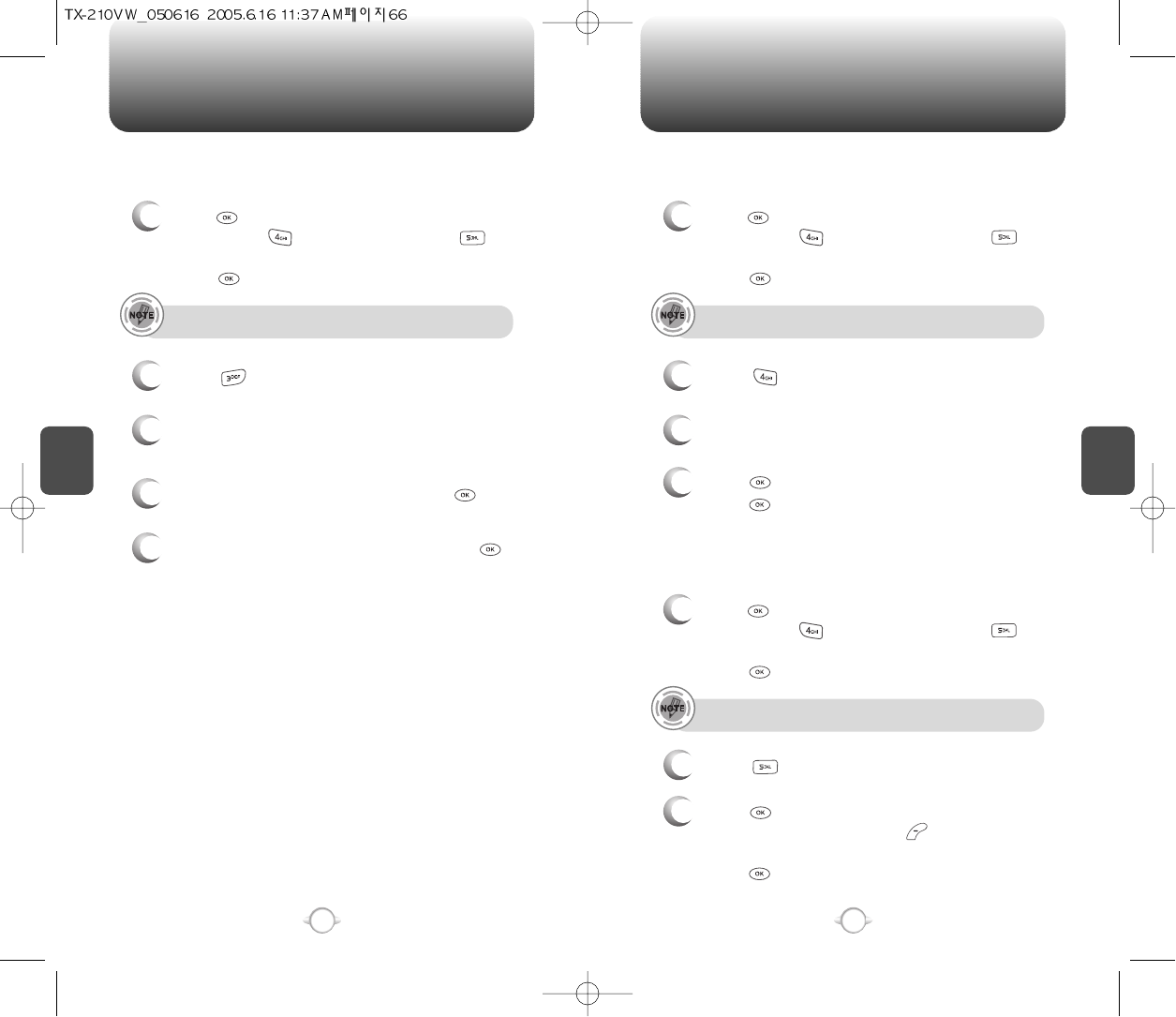
SETTINGS SETTINGS
C
H
4
67
C
H
4
66
4
Enter a “New Lock Code” then press [OK].
5
Enter a “Confirm Lock Code” then press [OK]
to save it.
1
Press [MENU], then select “Settings & Tools”
menu, press “System” then select
“Security”, then enter your password,
press [OK].
3
Select “Device” or “Location” then select one of
the following options with the Navigation Key.
2
Select “Edit Code”.
EDIT CODE
The default password is the last 4 digit of your phone number.
Changes your Device/Location 4-digit password.
1
Press [MENU], then select “Settings & Tools”
menu, press “System” then select
“Security”, then enter your password,
press [OK].
3
Select a location (1~3) with the Navigation Key.
4
Press [SET] and input a phone number,
press [OK] again to save.
2
Select “Special #’s”.
SPECIAL #’S
The default password is the last 4 digit of your phone number.
Stores 3 phone numbers that can be called even in the lock mode.
1
Press [MENU], then select “Settings & Tools”
menu, press “System” then select
“Security”, then enter your password,
press [OK].
3
Press [OK] to check “Contacts”, “Downloads”
or “Pix Gallery” then press [DONE] to erase all
the items in those categories, then select “Yes”,
press [OK].
2
Select “Erase All”.
ERASE ALL
The default password is the last 4 digit of your phone number.
Clears all contact, downloads entries and pix gallery from your phone.
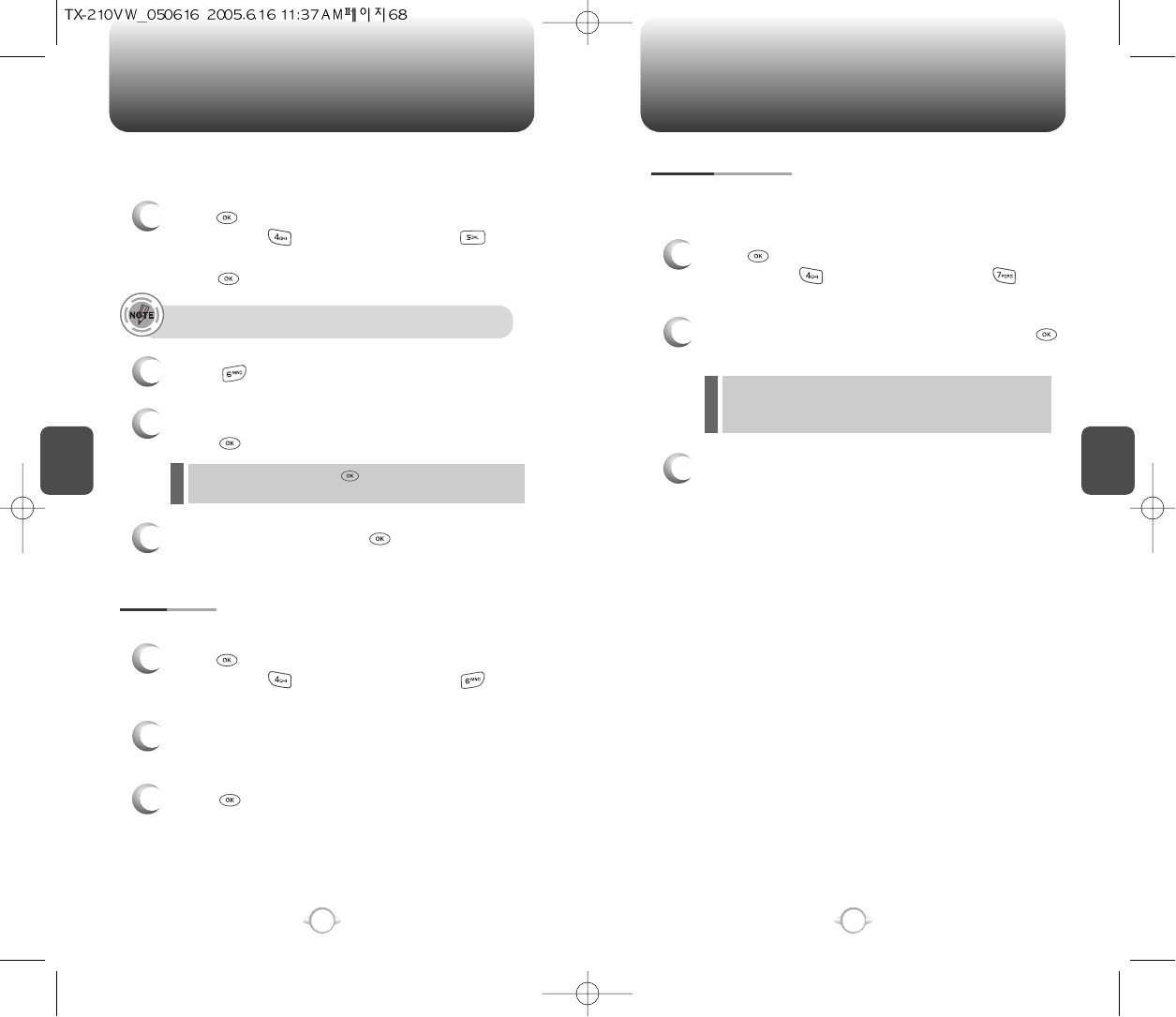
C
H
4
69
SETTINGS
C
H
4
68
SETTINGS
1
Press [MENU], then select “Settings & Tools”
menu, press “System” then select
“Security”, then enter your password,
press [OK].
3
Select “Yes” or “No” with the Navigation Key.
Press [OK].
2
Select “Reset Phone”.
RESET PHONE
The default password is the last 4 digit of your phone number.
Resets phone to default settings.
When you select “Yes” and [OK], you will see “This will
be reset to default settings. Reset Phone ?” on the display.
4
To reset the phone, press [OK].
Selects the language in which letters are displayed on the screen.
LANGUAGE
1
Press [MENU], then select “Settings & Tools”
menu, press “System” then select
“Language”.
3
Press [OK] to save it.
2
Select “English” or “Spanish” with the Navigation
Key.
Calendar/Tunes & Tones/Gallery/Fun & Games/News & Info/
Inbox/Sent/Email/Chat/IM/Settings & Tools/
Tools-Alarm Clock, Calculator
Your phone offers you the option of assigning a short-cut key
(Down Navigation Key) to a favorite or often-used function.
To assign a shortcut to the key:
SHORT CUT KEY
1
Press [MENU], then select “Settings & Tools”
menu, press “System” then select
“Short Cut Key”.
3
The Shortcut can now be accessed by pressing
the “Down Navigation Key”.
2
Select your desired menu option then press
[OK].
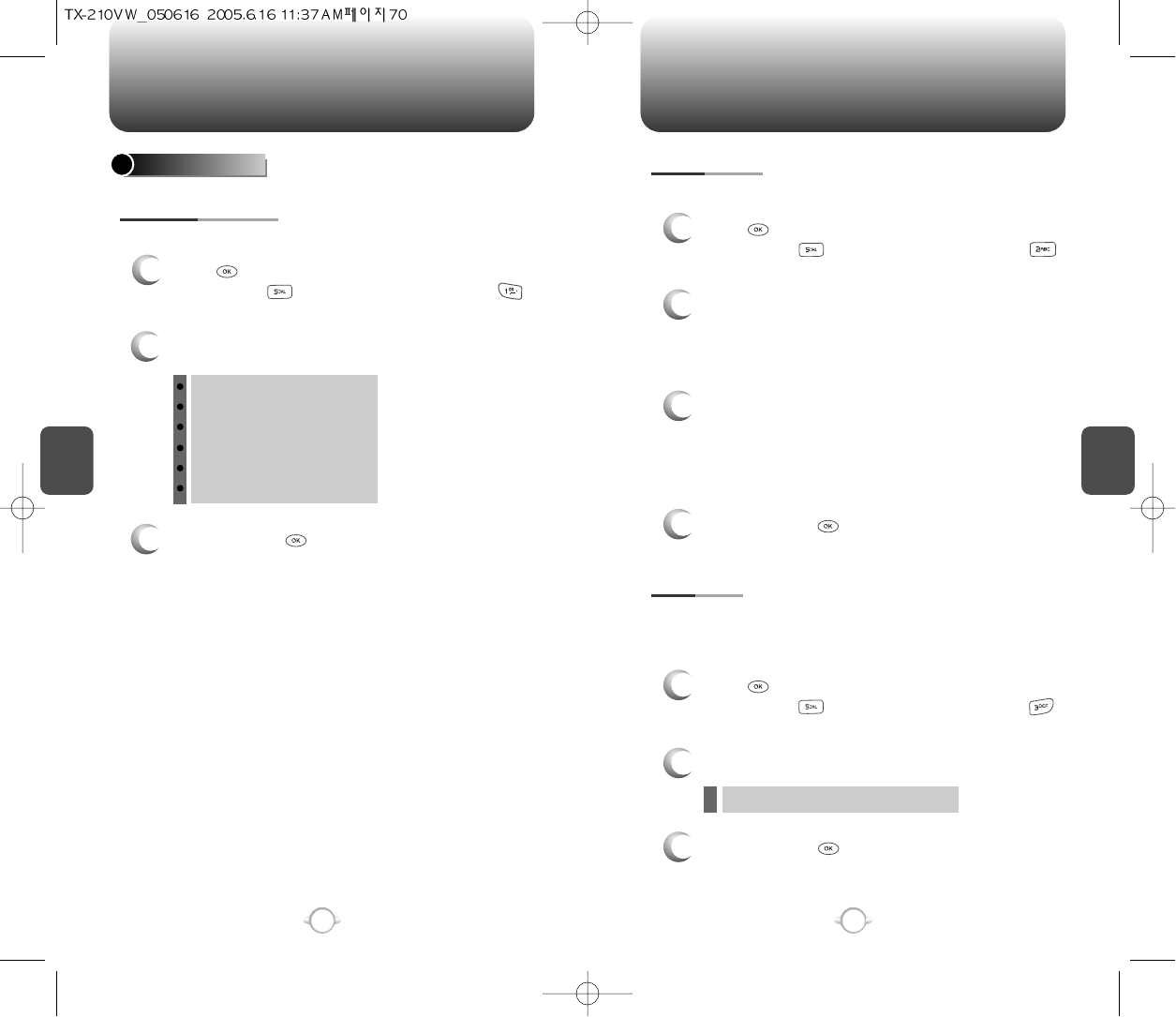
C
H
4
71
SETTINGS
C
H
4
70
SETTINGS
CALL SETTINGS
ANSWER OPTIONS
1
Press [MENU], then select “Settings & Tools”
menu, press “Call Settings” then select
“Answer Options”.
2
Select one of the following with the Navigation Key.
3
To save, press [OK].
To select an answer mode:
Flip Open
Any Key
Send Only
Auto Answer – Headset
Auto Answer – Handsfree
Auto Answer – Handset
1
Press [MENU], then select “Settings & Tools”
menu, press “Call Settings” then select
“Auto Retry”.
Automatically redials a call up to 5 times after a set time interval.
2
3
Retry time to field is shown. Press the Navigation
Key left or right to choose the amount of time.
(Off, 3 Seconds, 5 Seconds, 7 Seconds or
10 Seconds)
When a time is chosen for retry time, the repeat
field is shown. Press the Navigation Key down to
highlight the repeat field. Press the Navigation
Key left or right to choose the number of
repeats. (1 Time, 3 Times or 5 Times).
4
To save, press [OK].
AUTO RETRY
1
Press [MENU], then select “Settings & Tools”
menu, press “Call Settings” then select
“TTY Mode”.
Your phone is able to operate with a TTY (Teletypewriter) device in
both analog and digital modes. This feature is system dependent and
may not be available in all areas.
3
To save, press [OK].
TTY MODE
2
Select one of the following with the Navigation Key.
TTY Off/TTY+ TALK/TTY + HEAR/TTY Full
l
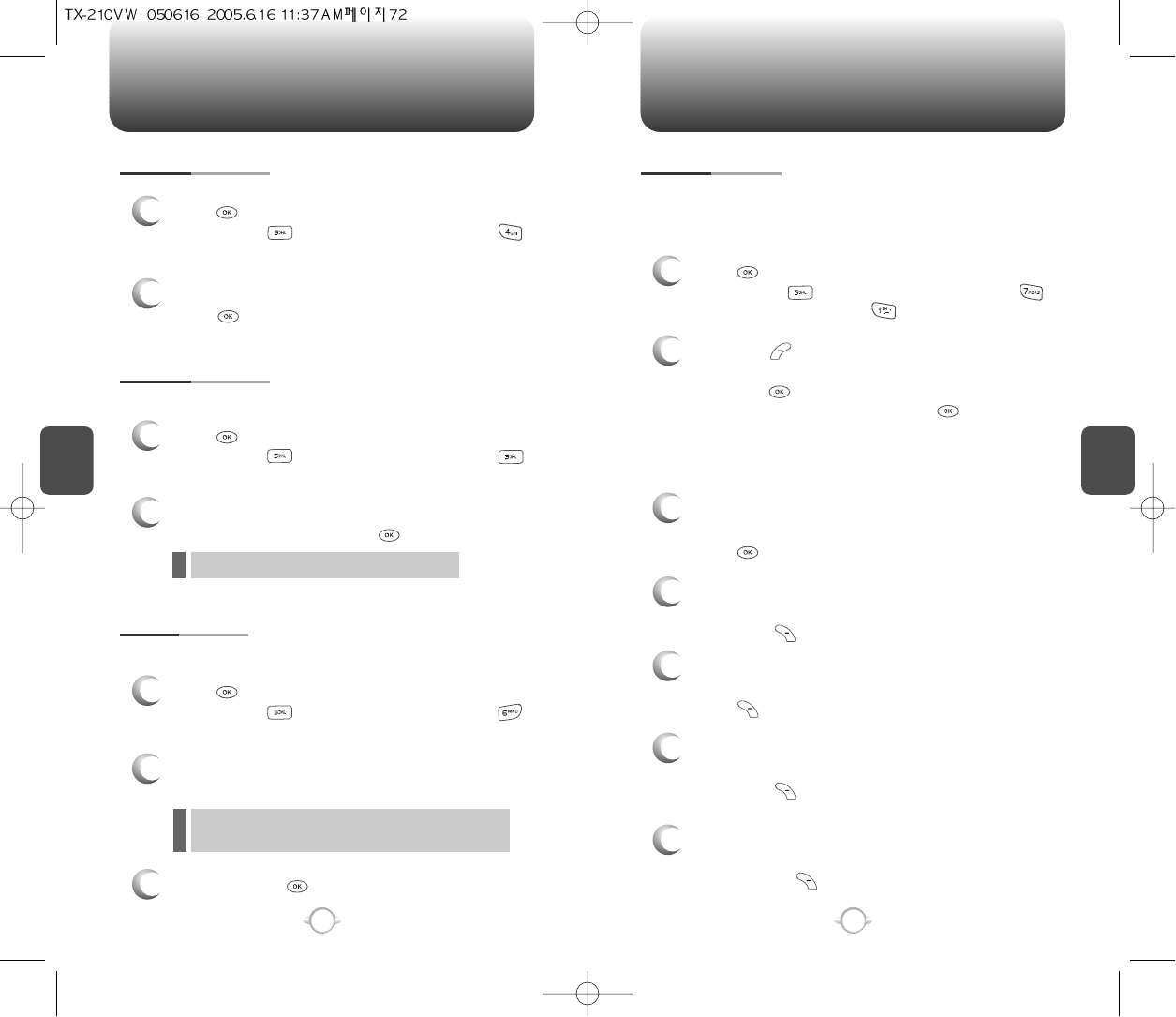
C
H
4
73
SETTINGS
C
H
4
72
SETTINGS
Enhances voice privacy and avoids tapping during a call.
Enhanced : Makes it more difficult to wire tap.
l
1
Press [MENU], then select “Settings & Tools”
menu, press “Call Settings” then select
“One Touch Dial”.
ONE TOUCH DIAL
2
Select “On” or “Off” with the Navigation Key then
press [OK] to save it.
1
Press [MENU], then select “Settings & Tools”
menu, press “Call Settings” then select
“Voice Privacy”.
VOICE PRIVACY
2
Select “Standard” or “Enhanced” with the
Navigation Key, then press [OK] to save it.
1
Press [MENU], then select “Settings & Tools”
menu, press “Call Settings” then select
“Data Setting”.
Choose the connection mode for the usage of your phone.
3
To save, press [OK].
DATA SETTING
2
Select one of the following connection modes
with the Navigation Key.
Voice Call : To receive a voice call.
Data Only : To receive data when connected to PC.
l
l
VOICE SERVICES
1
Press [MENU], then select “Settings & Tools”
menu, press “Call Settings” then select
“Voice Services”, press “Voice Dials”.
Voice Dial allows you to call a person by simply saying their name.
To access Voice Dial:
2.1. Press [NEW]. The phone book list will be
displayed alphabetically. Select a name then
press [OK]. Instructions (Please OK and say
name) will be displayed and [OK].
You will hear “Name Please”.
2.2. Say the name for the voice tag and repeat the
name when prompted. You will hear “Added”.
To play a voice dial.
Highlight the voice tag you want to play then
press [PLAY].
To detail a voice dial.
Highlight the voice tag you want to detail view
then press [OPTIONS] then select “Detail”.
To re-record a voice dial.
Highlight the voice tag you want to re-record then
press [OPTIONS] then select “Re-record”.
To erase or erase all voice dial.
Highlight the voice tag you want to erase or erase
all then press [OPTIONS] then select “Erase”
or “Erase All”.
To play speaker a voice dial.
Highlight the voice tag you want to play speaker
then press [OPTIONS] then select “Play
Speaker”.
VOICE DIALS
2
3
4
5
6
7
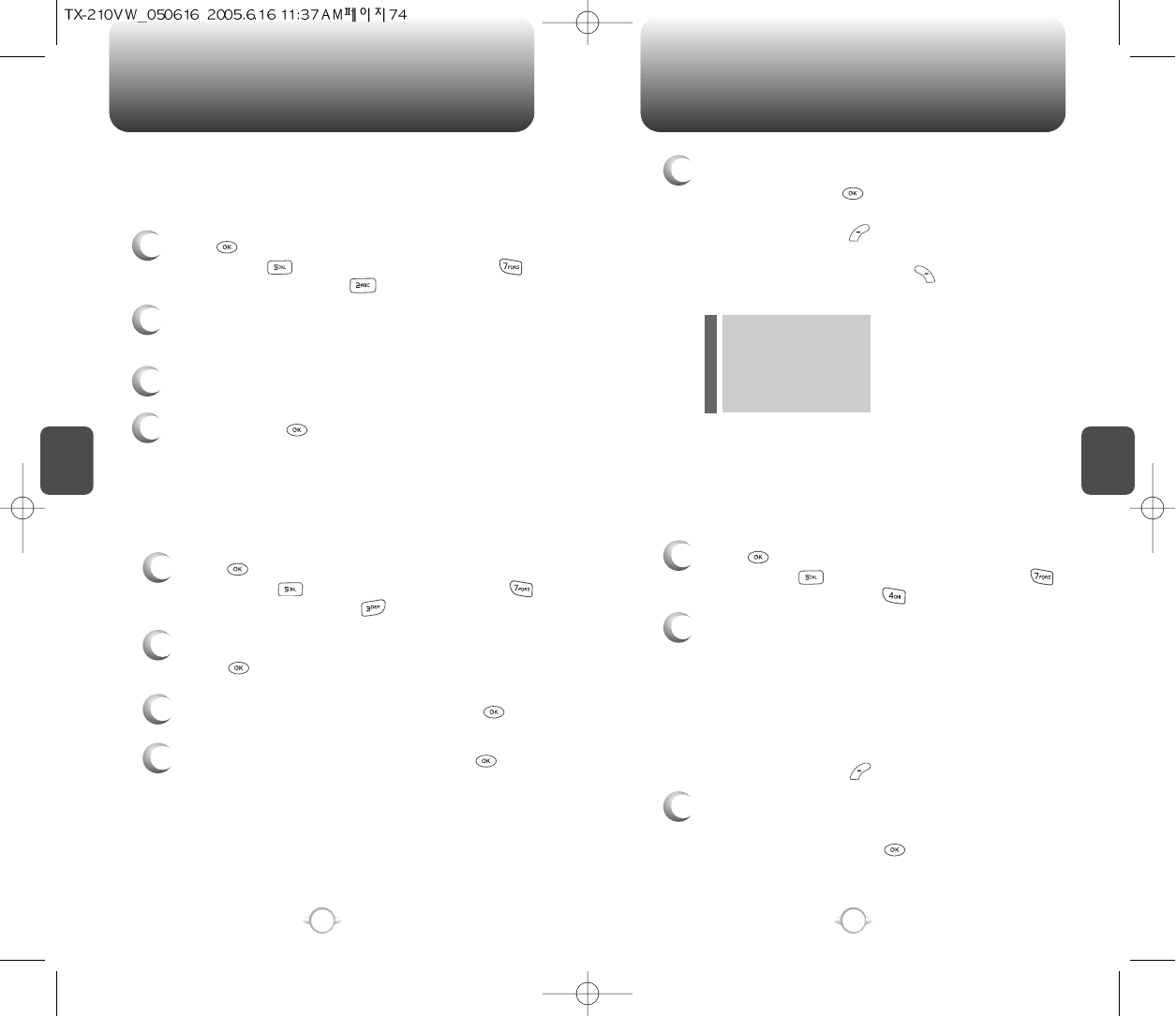
C
H
4
75
SETTINGS
C
H
4
74
SETTINGS
1
Press [MENU], then select “Settings & Tools”
menu, press “Call Settings” then select
“Voice Services”, press “Voice Memo”.
VOICE MEMO
2
To record a voice memo, select “Record New”,
press [OK].
3
To start recording a voice memo, press [OK].
Voice Memo allows you to record a reminder message that can be up
to 60 seconds. To record a memo:
4
To stop recording a voice memo, press [STOP].
To saved into voice memo list automatically.
Voice memo order by date and recent file is
uppermost.
1
Press [MENU], then select “Settings & Tools”
menu, press “Call Settings” then select
“Voice Services”, press “Voice Setting”.
VOICE SETTING
2
Under “Set Active”, select a option “Off”,
“Active Flip” or “Send Key”.
3
Under “HFK Mode”, select a option “On” or “Off”.
After turning on Set Active, open the flip to go on to VR mode. After
turning on HFK mode, put Hands-free kit and say “wake up” to go on
to VR mode.
4
To save, press [OK].
1
Press [MENU], then select “Settings & Tools”
menu, press “Call Settings” then select
“Voice Services”, press “Train Words”.
TRAIN WORDS
2
Under “Yes”, “No”, “Wake-Up”.
“Please listen closely to hear instructions” will be
displayed and you will hear “Now training control
words. Please say the word”. Say word. You will
hear “Again”. Say word again. You will hear
“Training word successful”.
To undo voice recognition, select a word you want
to undo then press [UNDO].
3
Under “Undo Train All”.
“Undo voice recognition for all procedures?”
will be displayed. Press [OK] to undo all
trained words.
Train allows you to use Control words to make a call without using
the keypad. Use to train or untrain the Voice Recognition with the
control word, “Yes”, “No” or “Wake-Up”.
5
To play voice memo, select the message you want
to play then press [PLAY].
To send voice memo, select the message you want
to send then press [SEND] to access the “New
Txt Msg” see “New Txt Msg” on page 89.
If saved voice memo, press [OPTIONS] to select
one of the following options:
lSet As Ringtone
lSet As Ringer ID
lRename
lErase
lErase All
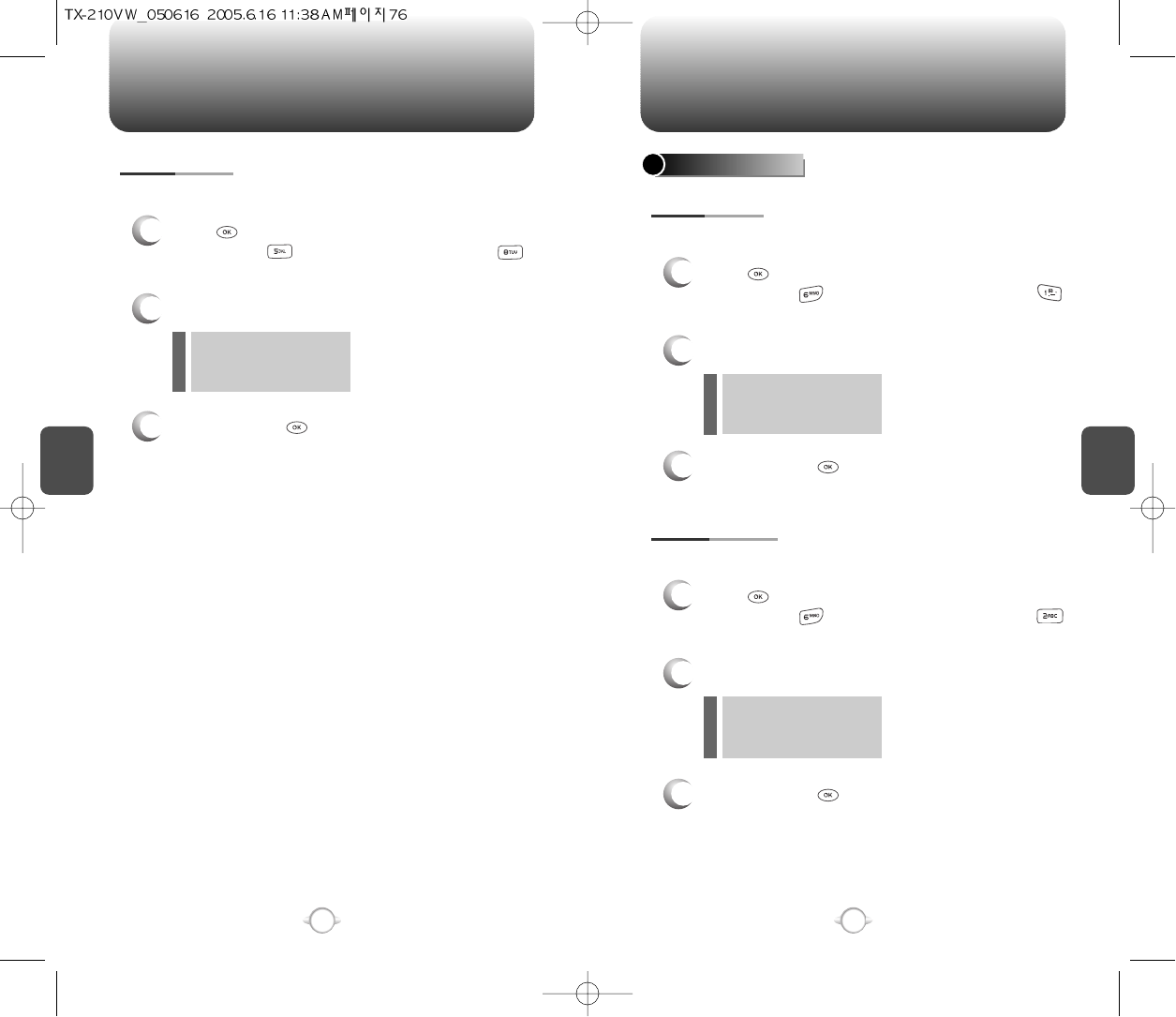
C
H
4
77
SETTINGS
C
H
4
76
SETTINGS
1
Press [MENU], then select “Settings & Tools”
menu, press “Call Settings” then select
“DTMF Tones”.
3
To save, press [OK].
DTMF TONES
2
Select one of the following with the Navigation Key.
Normal
Long
Off
l
l
l
To adjust tone length:
CLOCK FORMAT
1
Press [MENU], then select “Settings & Tools”
menu, press “Clock Format” then select
“Main Clock”.
3
To save, press [OK].
MAIN CLOCK
2
Select one of the following with the Navigation Key.
Digital
Analog
Off
l
l
l
To change the main clock’s appearance on the standby screen:
1
Press [MENU], then select “Settings & Tools”
menu, press “Clock Format” then select
“Front Clock”.
3
To save, press [OK].
FRONT CLOCK
2
Select one of the following with the Navigation Key.
Digital
Analog
Off
l
l
l
To change the front clock’s appearance on the standby screen:
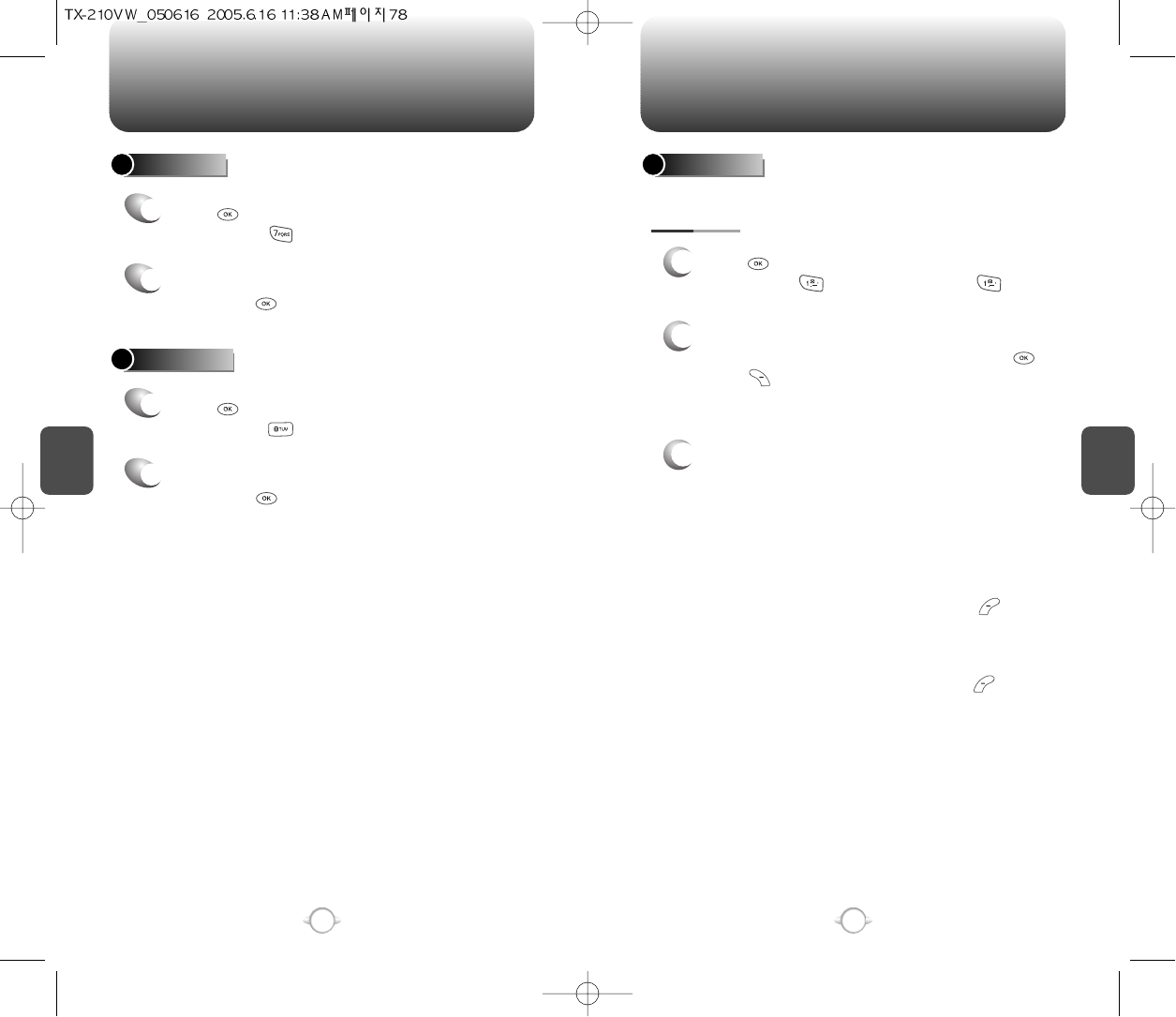
SETTINGS TOOLS
C
H
4
79
C
H
4
78
RINGER ID
1
2
Press [MENU], then select “Settings & Tools”
menu, press “Ringer ID”.
Select “On” or “Off” with the Navigation Key,
then press [OK] to save it.
PICTURE ID
1
2
Press [MENU], then select “Settings & Tools”
menu, press “Picture ID”.
Select “On” or “Off” with the Navigation Key,
then press [OK] to save it.
Use the Navigation Key to select a time zone.
(OFF, EST, EDT, CST, CDT, MST, PST, PDT,
AKST, AKDT, HAST, HADT or GMT/UTC).
TIME ZONE
CALENDAR
ADD NEW
Sets an event and reminds you of that event.
2
3
Move the Navigation Key left, right, up or down to
choose a date in the calendar then press [OK].
Press [OPTIONS] to 1. Monthly View, 2. Weekly
View, 3. New, 4. Go To Date, 5. Erase, 6. Erase
Today or 7. Erase Passed.
Use the keypad to set a start time and to
select “AM” or “PM”.
START TIME
Use the keypad to entering a appointment of your
schedule.
APPOINTMENT
Use the keypad to change or enter the start date.
START DATE
The date field is highlighted. Press the Navigation
Key down to set the alarm options.
Use the keypad to set a end time and to
select “AM” or “PM”.
END TIME
1
Press [MENU], then select “Settings & Tools”
menu, press “Tools” then select
“Calendar”.
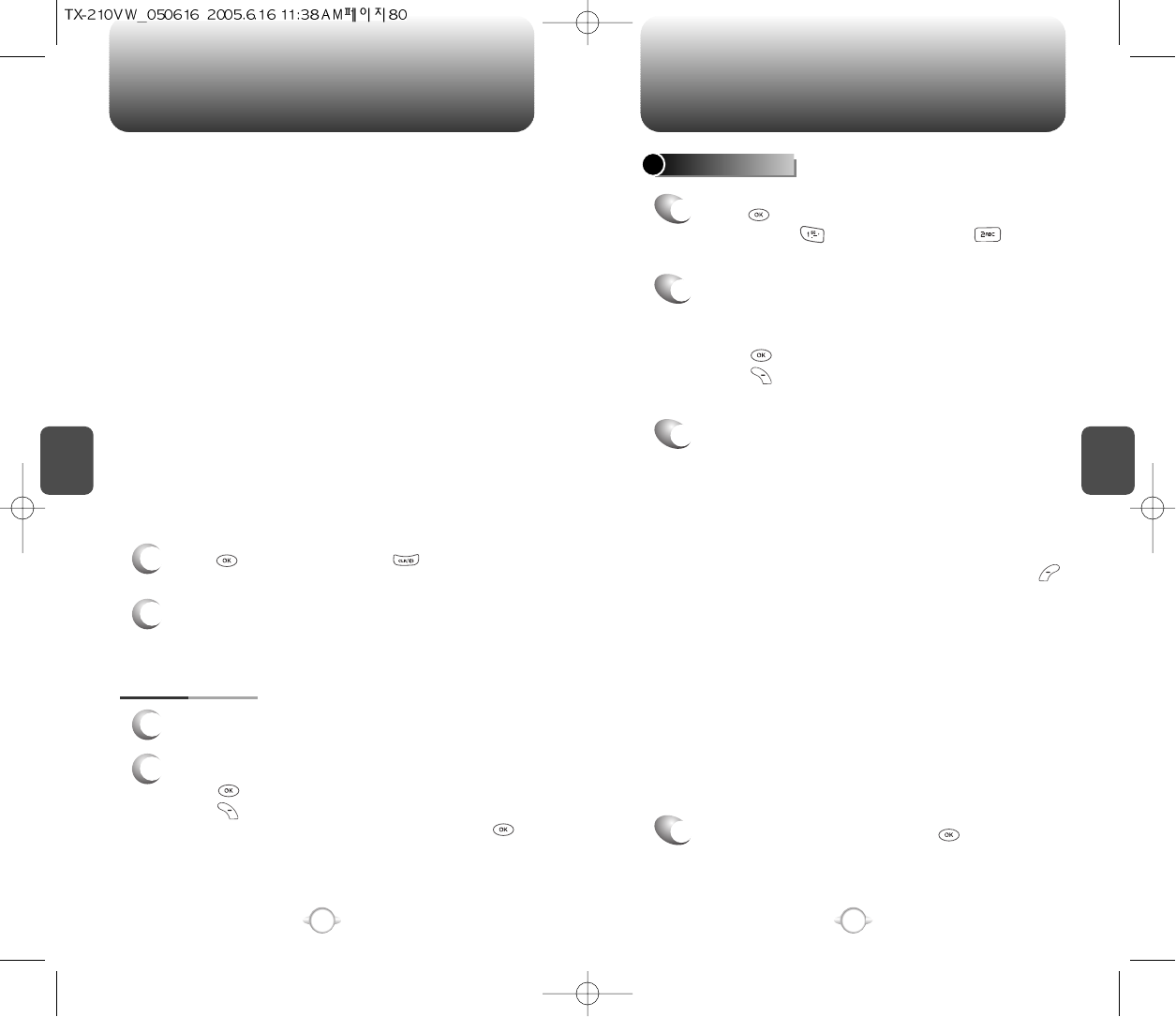
C
H
4
81
TOOLS
C
H
4
80
TOOLS
Use the keypad to change or enter the end date.
END DATE
Use the keypad to select the alert tone you wish
to set.
ALERT
Use the Navigation Key to select vibrate on/off.
VIBRATE
Use the Navigation Key to select an alert time
interval option (0, 5 Minutes, 10 Minutes,
15Minutes before the appointment time).
REMINDER
4
Press [SAVE] to save it or [CLR] to
return to the calendar.
5
The date of the event will be marked on your
calendar.
1
To view the Calendar List.
VIEW PLAN LIST
2
Move the Navigation Key to choose an event then
press [VIEW].
Press [OPTIONS] and select “SAVE” to save it
or select “Erase”, then select “Yes”, press .
Use the Navigation Key to select a setting for the
repeat repeating the calendar. (Daily, Weekly,
Monthly or Yearly).
RECURRENCY
ALARM CLOCK
Select one of the entries using the Navigation Key.
To set a new alarm, choose alarm 1, 2 or 3.
To edit an existing alarm, select that alarm.
Press [OK].
Press [OPTIONS] to 1. Off, 2. Reset,
3. Reset All.
2
1
The setting field will be highlighted. Press the
Navigation Key down to select alarm options.
3
Use the Navigation Key to select a setting for the
alarm (Once, Daily, Monday through Friday,
Weekends).
FREQUENCY
Press [MENU], then select “Settings & Tools”
menu, press “Tools” then select
“Alarm Clock”.
Use the Navigation Key to select alarm On/Off.
ALARM
Use the keypad to set a time for the alarm and
to select “AM” or “PM”.
TIME
Use the keypad to select the alert tone you wish
to set.
RINGER
To save an alarm setting press [SAVE].
4
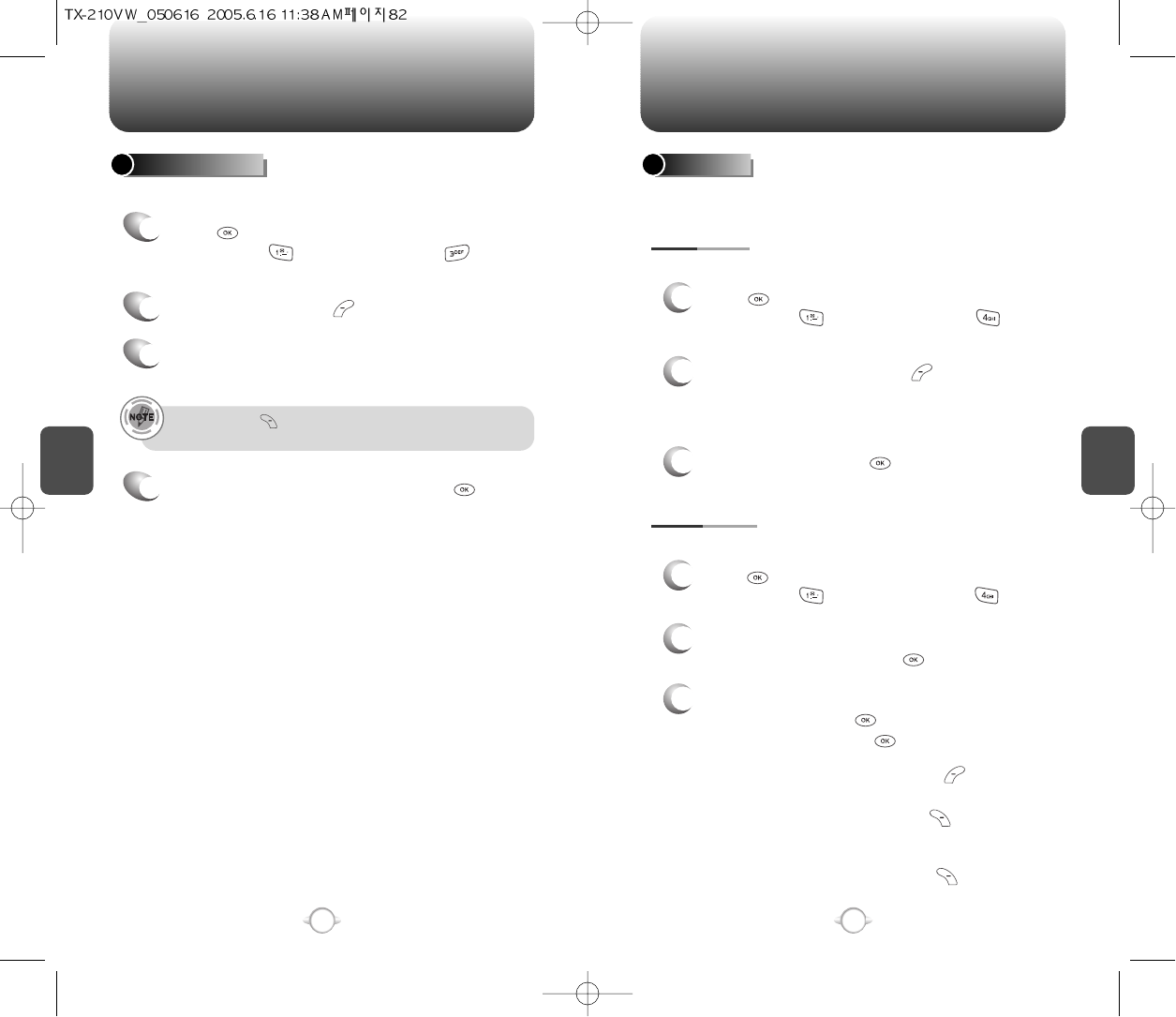
C
H
4
83
TOOLS
C
H
4
82
TOOLS
To display the time and date in pre-programmed cities:
WORLD CLOCK
2
4
Select a city with the [CITIES].
3
The world map appears with the city, its date
and time.
• If user press [DST], then all DST supporting cities DST turn
on/off.
To return to the previous page, press [OK].
1
Press [MENU], then select “Settings & Tools”
menu, press “Tools” then select
“World Clock”.
Your phone includes an internal notepad that can be used to
compose and store reminders and notes.
NOTEPAD
1
Press [MENU], then select “Settings & Tools”
menu, press “Tools” then select
“Notepad”.
ADD MEMO
2
To add a new memo, press [NEW].
Input a new text memo.
(Please refer to page 31 for more details on entering
letters, numbers & symbols.)
1
VIEW MEMO
2
The list of all memos, in saved order, is displayed.
Select a memo then press [VIEW].
3
3.1. The selected memo will appear.
To edit it, press [EDIT] and input a new text
memo, then press [SAVE] to save it.
To compose a memo (there is an 80-letter limit):
To view a saved memo:
Press [MENU], then select “Settings & Tools”
menu, press “Tools” then select “Notepad”.
3.3. To erase a memos, press [OPTIONS]
“Erase”.
3.2. To add a new memo, press [NEW].
3.4. To erase all memos, press [OPTIONS]
“Erase All”.
3
To save memo, press [SAVE].
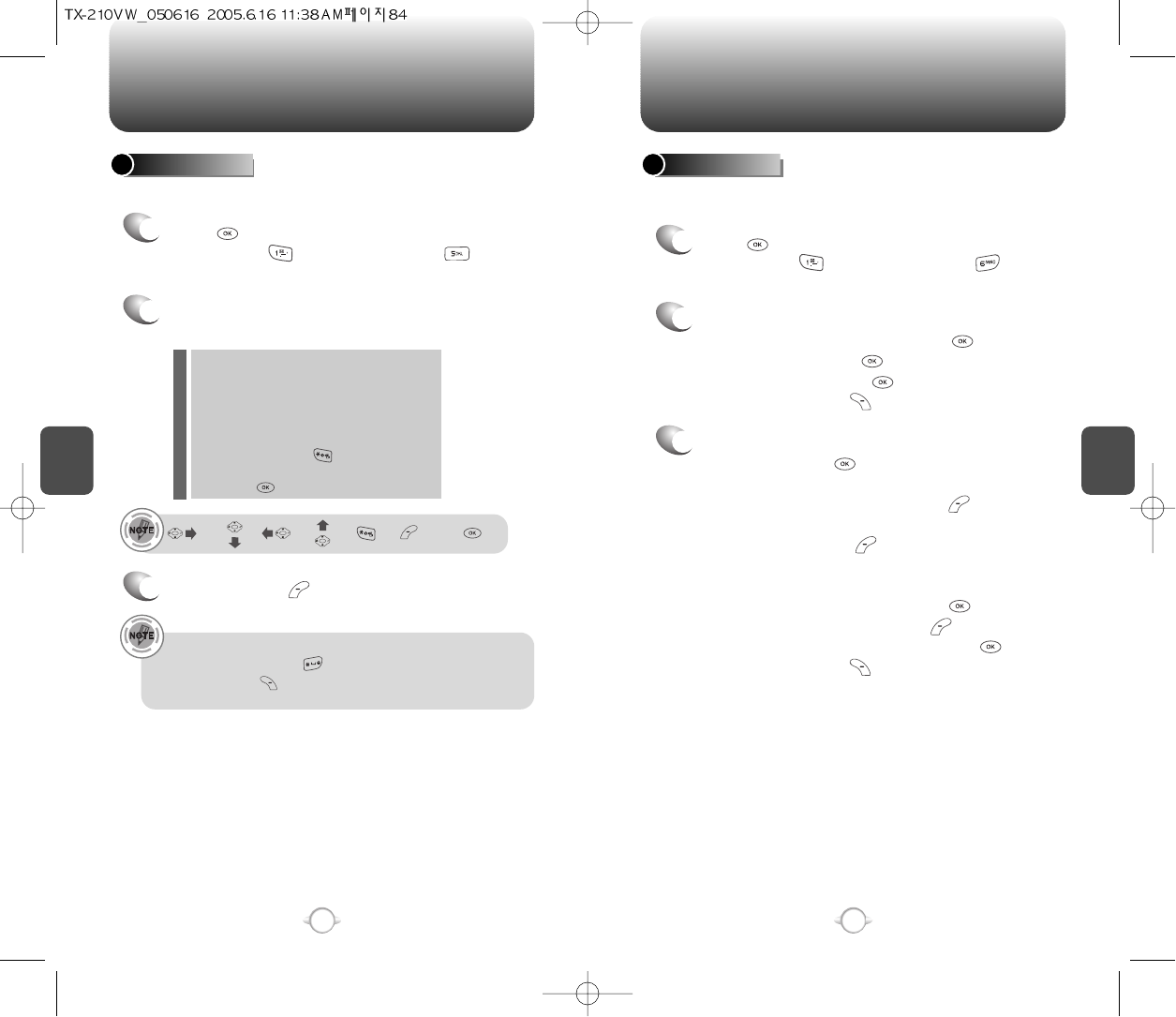
C
H
4
85
TOOLS
C
H
4
84
TOOLS
2
Follow the instructions below to calculate
8*64-2.5= 9.5
3
To reset, press [CLEAR].
To access the calculator:
CALCULATOR
Input 8.
Move the Navigation Key rightward.
Input 6 then press the Navigation Key.
Move it leftward.
Input 4 then press the Navigation Key.
Move it downward.
Input 2 then press the to input (.).
Press 5.
Then press and you will see the answer.
: X, : -, : /, : +, : ., : Clear, : =.
1
Press [MENU], then select “Settings & Tools”
menu, press “Tools” then select
“Calculator”.
• To change the displayed number from positive (+) to negative (-)
and vice versa, press [].
• If user press [OPERATOR], to use multi parenthesis support
and parenthesis rules [(,)] or power [^].
2
1
3
Simultaneously times up to six different events. To operate the
stop watch:
STOP WATCH
To measure a time period.
1. To start the stop watch, press [START].
2. To pause it, press [STOP].
3. To resume it, press [START].
To reset it, press [RESET].
To time up to six events at once:
1. To start, press [START].
2. To stop a time period and continue
measuring another one, press [CONT].
3. To stop the second and continue measuring
a third one, press [CONT].
4. To measure up to six time periods, repeat the
above steps.
5. To stop the stop watch, press [STOP].
6. To review the results, press [VIEW].
7. To return to the stop watch, press [OK].
8. To reset it, press [RESET].
Press [MENU], then select “Settings & Tools”
menu, press “Tools” then select
“Stop Watch”.
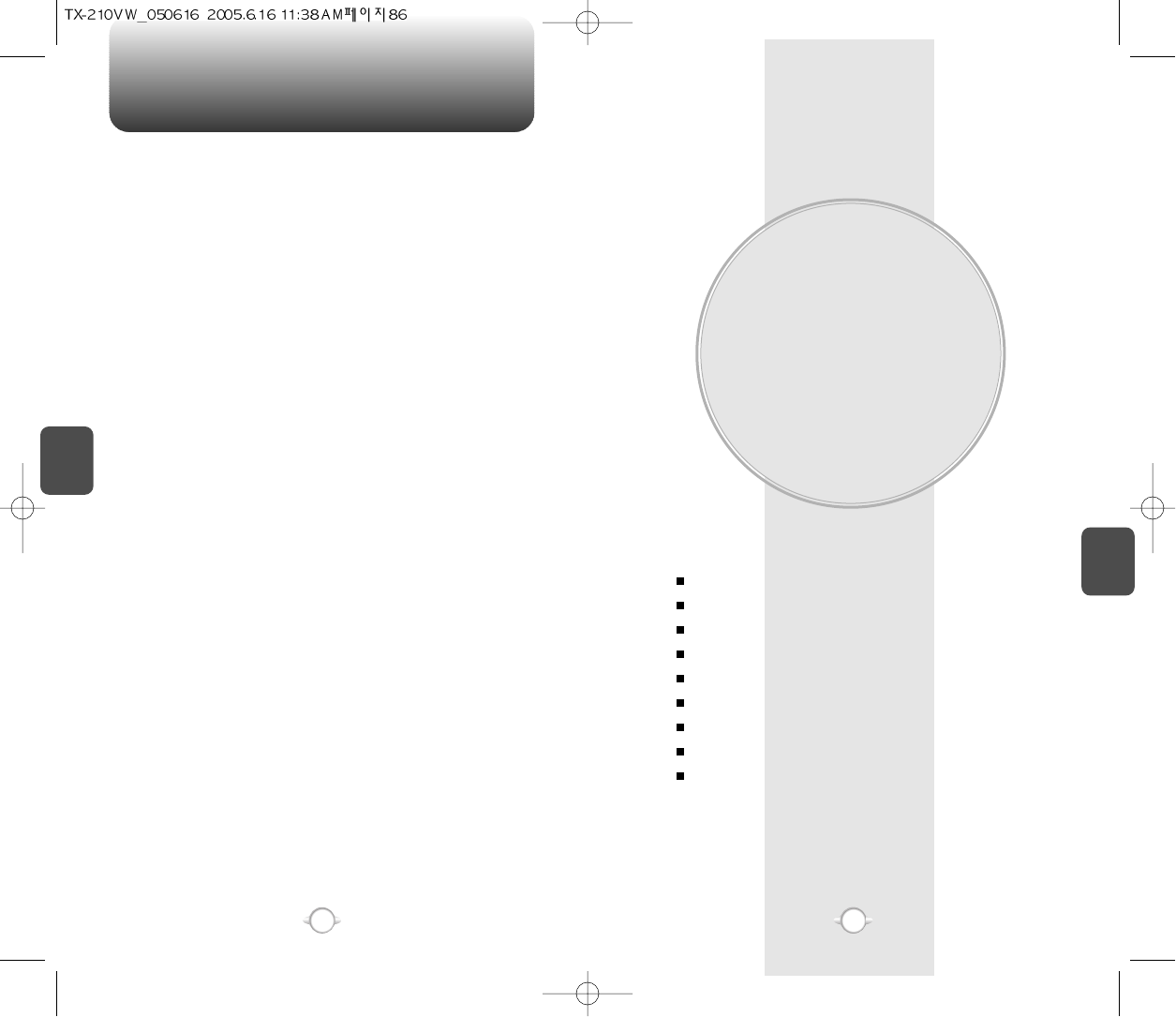
Chapter 5
87
86
C
H
5
87
MEMO
C
H
4
VOICE MAIL, TXT
MESSAGING
This chapter addresses Voice Mail, TXT Messaging functions
including:
WHEN A NEW MESSAGE ARRIVES
VOICE MAIL
NEW TXT MSG
INBOX
SENT
DRAFTS
E- MAIL
ERASE ALL
SETTINGS
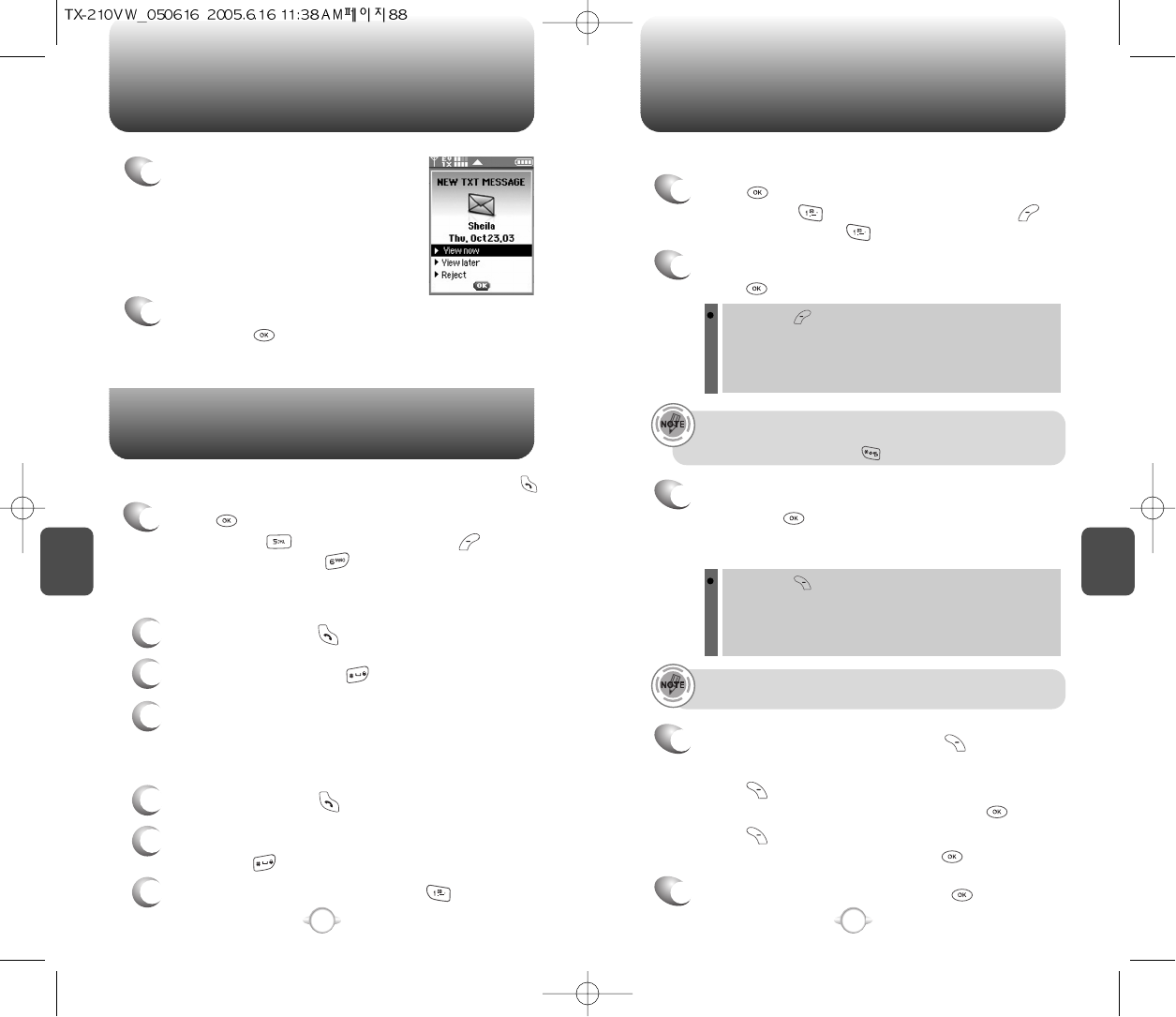
Displays the number of voice mails and accesses them by pressing .
VOICE MAIL
C
H
5
89
C
H
5
88
WHEN A NEW MESSAGE ARRIVES NEW TXT MSG
1
The following display appears
when a new message arrives.
2
To display the message, select “View Now”,
then press [OK].
1
Press [MENU], then select “Messaging”
menu, press “New TXT Msg” or press
[MESSAGE], press “New TXT Msg”.
To send a new txt message:
2
Under “To”, input the phone number and
press [OK].
3
Under “Message”, input a new TXT message
then press [OK].
By pressing [ADD], you can choose from the following:
1. Contacts : Search the phone number which is stored in
the contacts list.
2. Recent Calls : Search the phone number which is stored in
the recent calls list.
By pressing [OPTIONS], then select “ADD”.
You can choose from the following:
1. Graphics : Inserts simple graphic image in TXT Msg.
2. Sounds : Inserts EMS sound in TXT Msg.
3. Quick Text : Inserts already written sentences in TXT Msg.
(Please refer to page 31 for more details on entering letters,
numbers and symbols.)
FIRST TIME USER
1
Dial *86 then press [SEND].
2
At the recording, press .
3
To set up your account follow the voice tutorial.
EXISTING USER
1
Dial *86 then press [SEND].
2
At the recording, enter your 4 digit password,
then press .
3
To listen to new messages, press .
• To field support max 10 contacts.
• When user input phone number, user can insert international
prefix (+) by press and hold .
If one of field is inserted in txt msg field, message save at
draft box.
5
To send the TXT message, press [SEND].
4
Press [OPTIONS], then select “Priority Level”,
select “High” or “Normal”, then press [OK].
Press [OPTIONS], then select “Call Back #”,
select “On” or “Off”, then press [OK].
To save the TXT message, press [OPTIONS],
then select “Save as Drafts”.
1
Press [MENU], then select “Messaging”
menu, press “Voice Mail” or press
[MESSAGES], press “Voice Mail”.
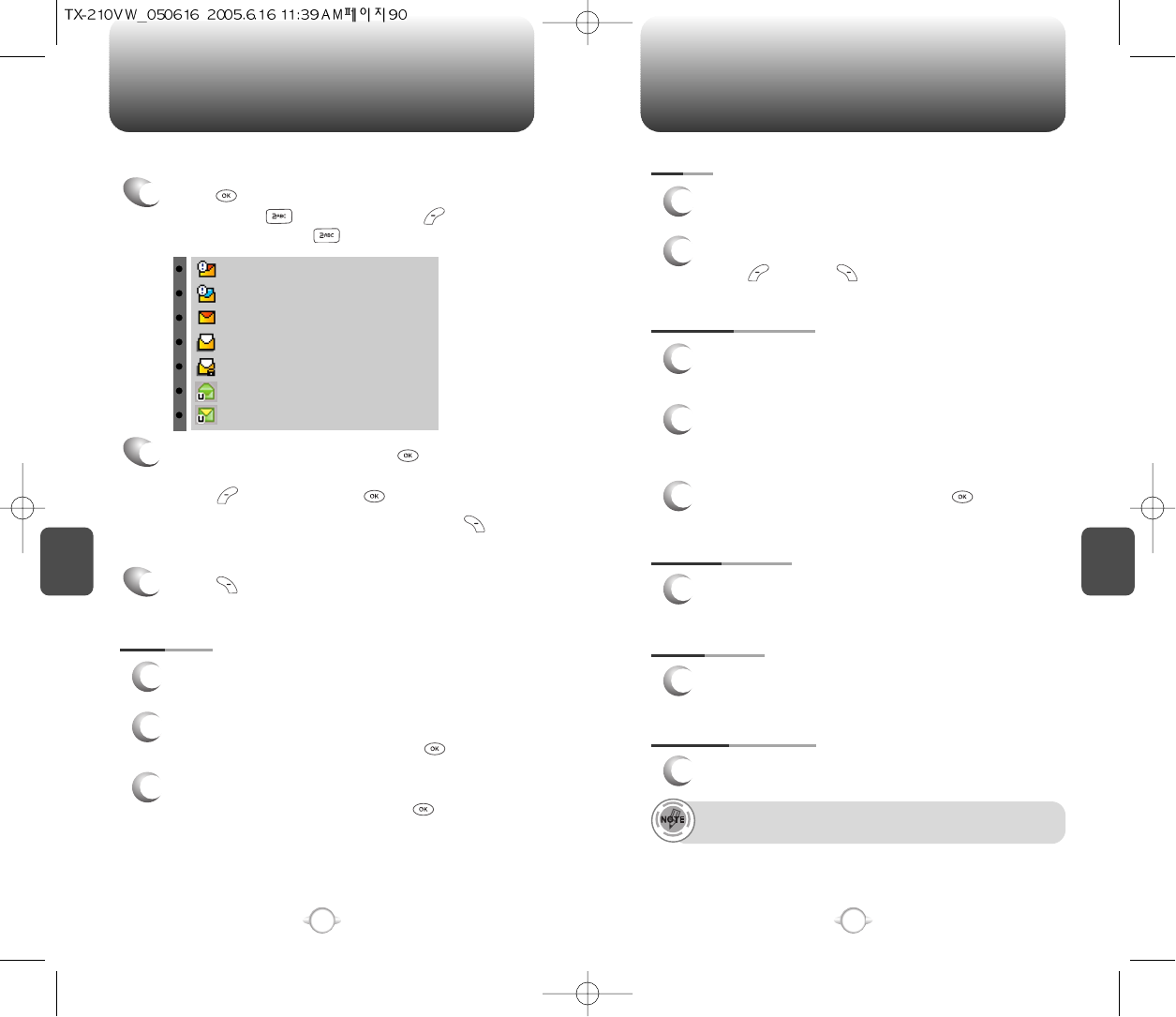
INBOX INBOX
C
H
5
91
C
H
5
90
SAVE GRAPHICS
1
To save a picture to the “Save Graphics” folder.
FORWARD
1
To forward the TXT message.
2
Input the phone number of the person you are
sending the message, then press [OK].
3
Input any text message to go along with the
forwarded message, then press [OK].
: Urgent New Msg (not read)
: Urgent Read Msg
: New Msg (not read)
: Old Msg (already read)
: Lock (already read and locked)
: Web Alert Read
: Web Alert Unread
The Inbox manages received TXT/Web Alert messages. To access:
2
Select a message, then press [OPEN].
The message is displayed. To delete a message,
press [ERASE], press [OK].
If you select web alert message, press [GET],
to Browser launching.
Press [OPTIONS].
3
REPLY WITH COPY
1
2
3
To reply to a received message and include the
received message into the message.
The default call back number is automatically
included into the Default CB# field.
You can scroll to the number and edit it.
ERASE
1
2
To erase this message, select “Erase”.
“Erase This Message?” will be displayed.
Press [YES] or [NO].
To send the TXT message, press [SEND].
SAVE SOUND
1
To save a sound to the “Save Sound” folder.
1
Press [MENU], then select “Messaging”
menu, press “Inbox” or press
[MESSAGE], press “Inbox”.
ADD TO CONTACTS
1
Select to save number to contacts.
“Save Graphics", “Save Sound" menu appears only when you
receive EMS message.
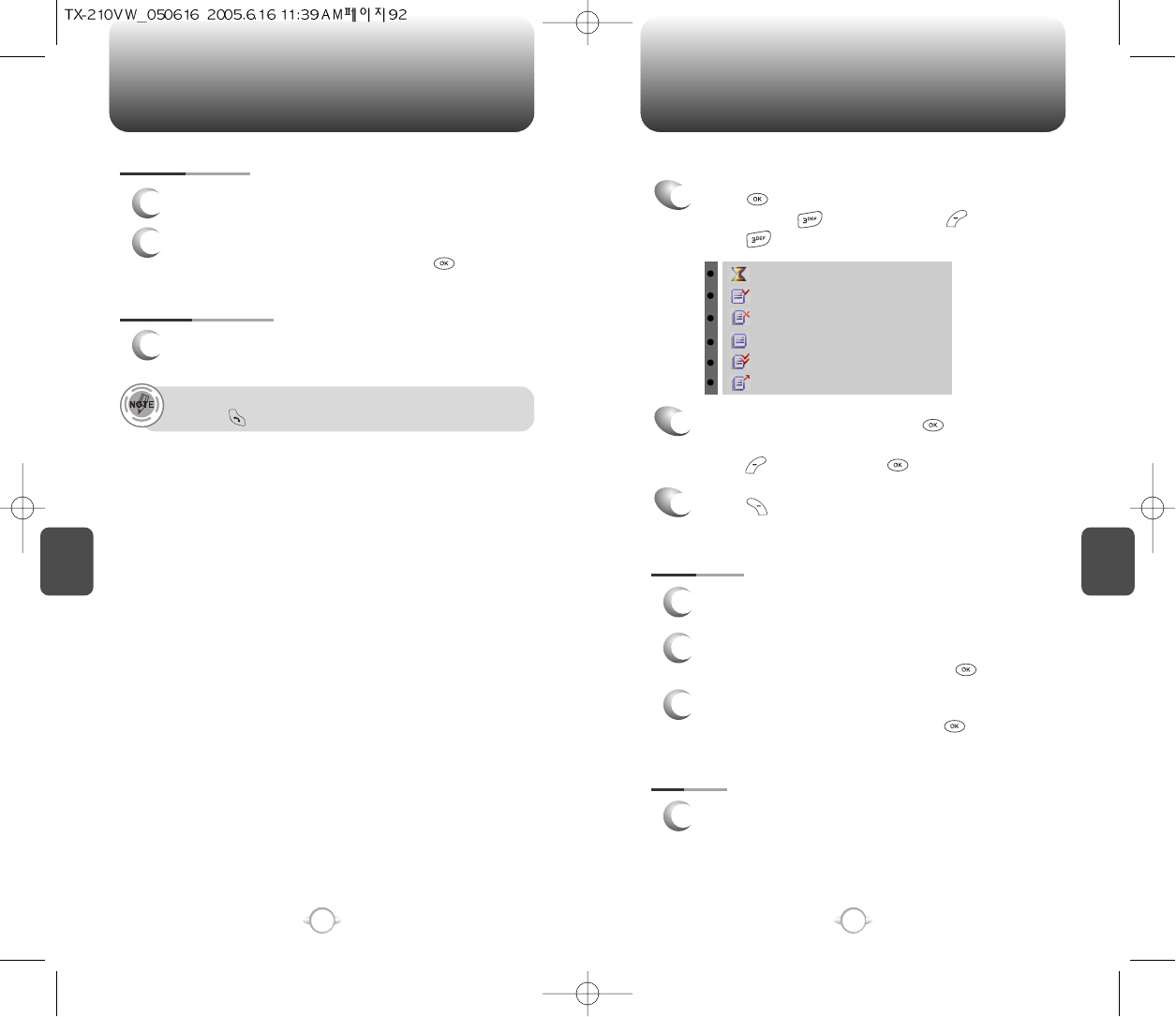
INBOX SENT
C
H
5
93
C
H
5
92
LOCK/UNLOCK
1
To lock or unlock the TXT or PIX message.
2
Select “Lock” to lock the message or “Unlock”
to unlock the message, then press .
• Place a call to a received message number by simply
pressing .
1
Press [MENU], then select “Messaging”
menu, press “Sent” or press [MESSAGE],
press “Sent”.
Manages sent TXT messages waiting to be sent.
: Auto resend
: Delivered
: Fail
: Not Sent
: Read
: Sent
2
Select a message then press [OPEN].
The message is displayed. To delete a message,
press [ERASE], press [OK].
Press [OPTIONS].
3
FORWARD
1
To forward the TXT message.
2
Input the phone number of the person you are
sending the message, then press [OK].
3
Input any text message to go along with the
forwarded message, then press [OK].
SAVE QUICK TEXT
1
Select to save received text msg to “Quick Text”.
RESEND
1
To resend a TXT message.
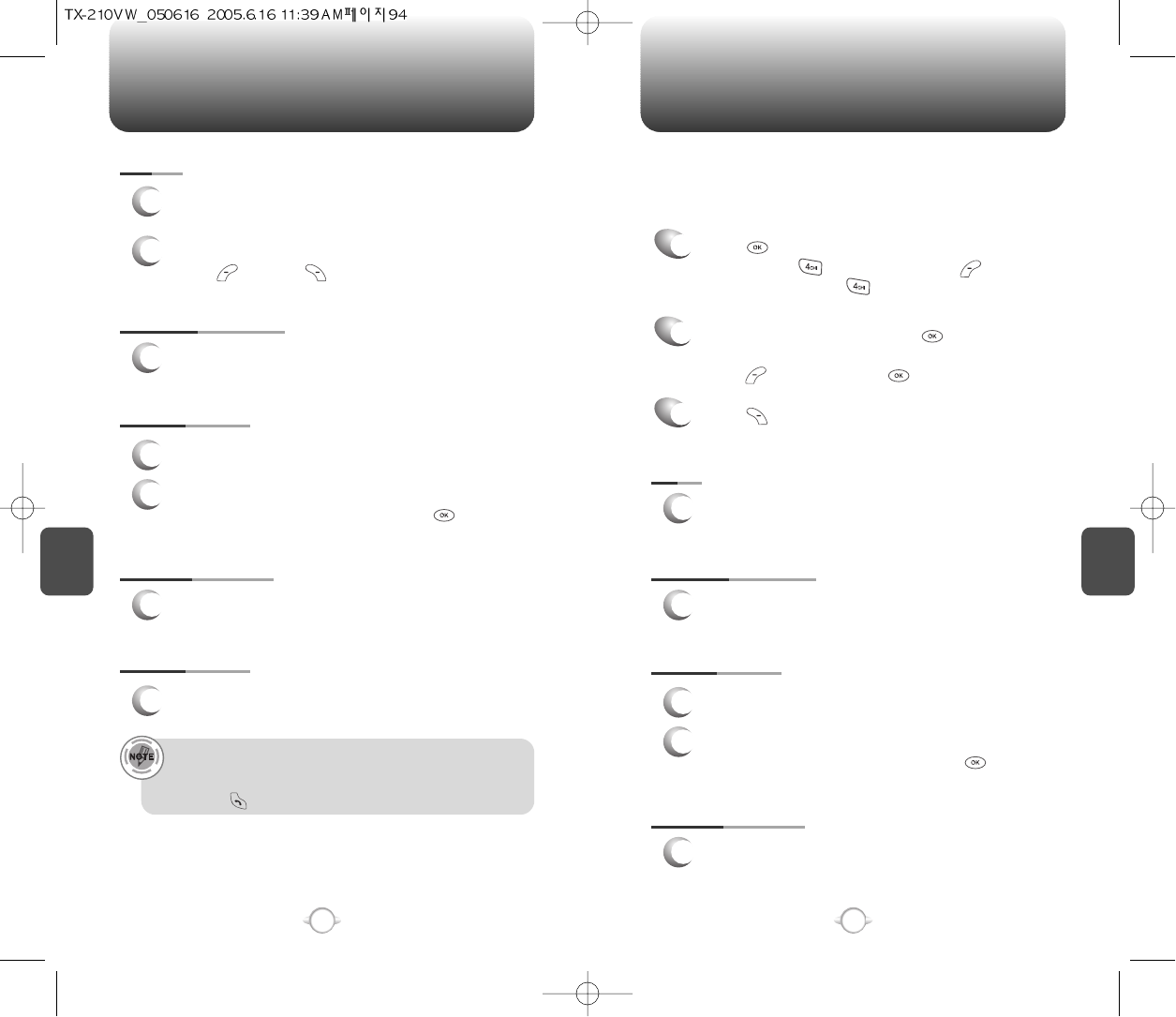
SENT DRAFTS
C
H
5
95
C
H
5
94
SAVE QUICK TEXT
1
Select to save received text msg to “Quick Text”.
ADD TO CONTACTS
1
Select to save number to contacts.
LOCK/UNLOCK
1
To lock or unlock the TXT message.
2
Select “Lock” to lock the message or “Unlock”
to unlock the message, then press .
SAVE QUICK TEXT
1
Select to save received text msg to “Quick Text”.
ADD TO CONTACTS
1
Select to save number to contacts.
SEND
1
To send a selected message.
LOCK/UNLOCK
1
To lock or unlock the TXT message.
2
Select “Lock” to lock the message or “Unlock”
to unlock the message, then press .
MESSAGE INFO
1
To show received message information.
• “Message Info” menu appears only when you receive EMS
message.
• Place a call to a received message number by simply
pressing .
1
Press [MENU], then select “Messaging”
menu, press “Drafts” or press
[MESSAGE], press “Drafts”.
2
Select a message then press [EDIT].
The message is displayed. To delete a message,
press [ERASE], press [OK].
Press [OPTIONS].
3
Draft Folder contains any draft messages or saved mes-sages.
If message composition is interrupted by a voice call or other
interrupting event, the text of the current composition is automatically
saved in the drafts folder.
ERASE
1
2
To erase this message, select “Erase”.
“Erase This Message?” will be displayed.
Press [YES] or [NO].
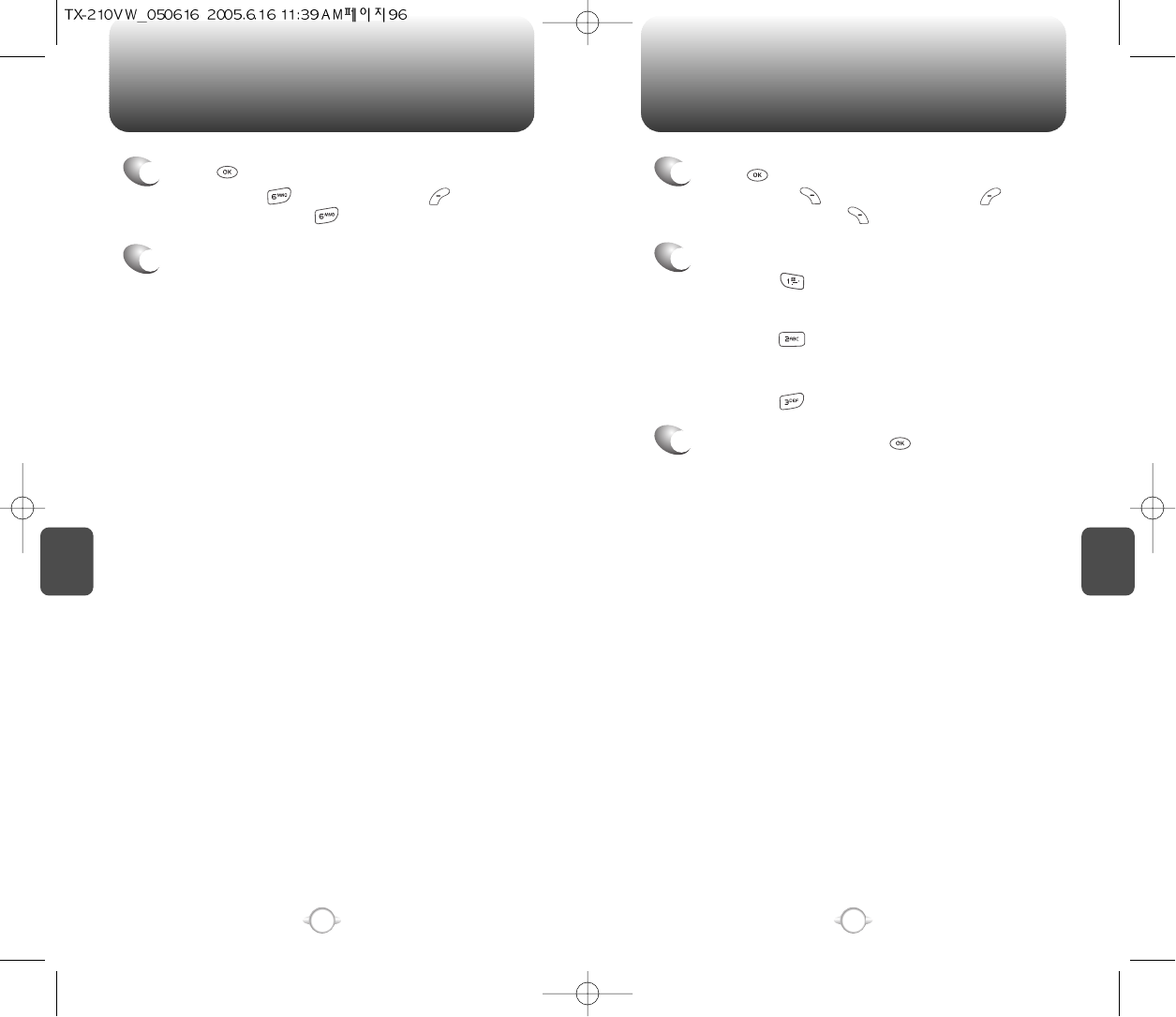
C
H
5
97
C
H
5
96
ERASE ALLE- MAIL
1
Press [MENU], then select “Messaging”
menu, press “E-mail” or press
[MESSAGE], press “E-mail”.
2
Browser launching.
2
2.1. To erase all the inbox messages,
press [ERASE INBOX].
3
Select “Yes”, then press .
2.2. To erase all the drafts messages,
press [ERASE DRAFTS].
2.3. To erase the sent messages,
press [ERASE SENT].
1
Press [MENU], then select “Messaging”
menu, press [OPTIONS] or press
[MESSAGE], press [OPTIONS].
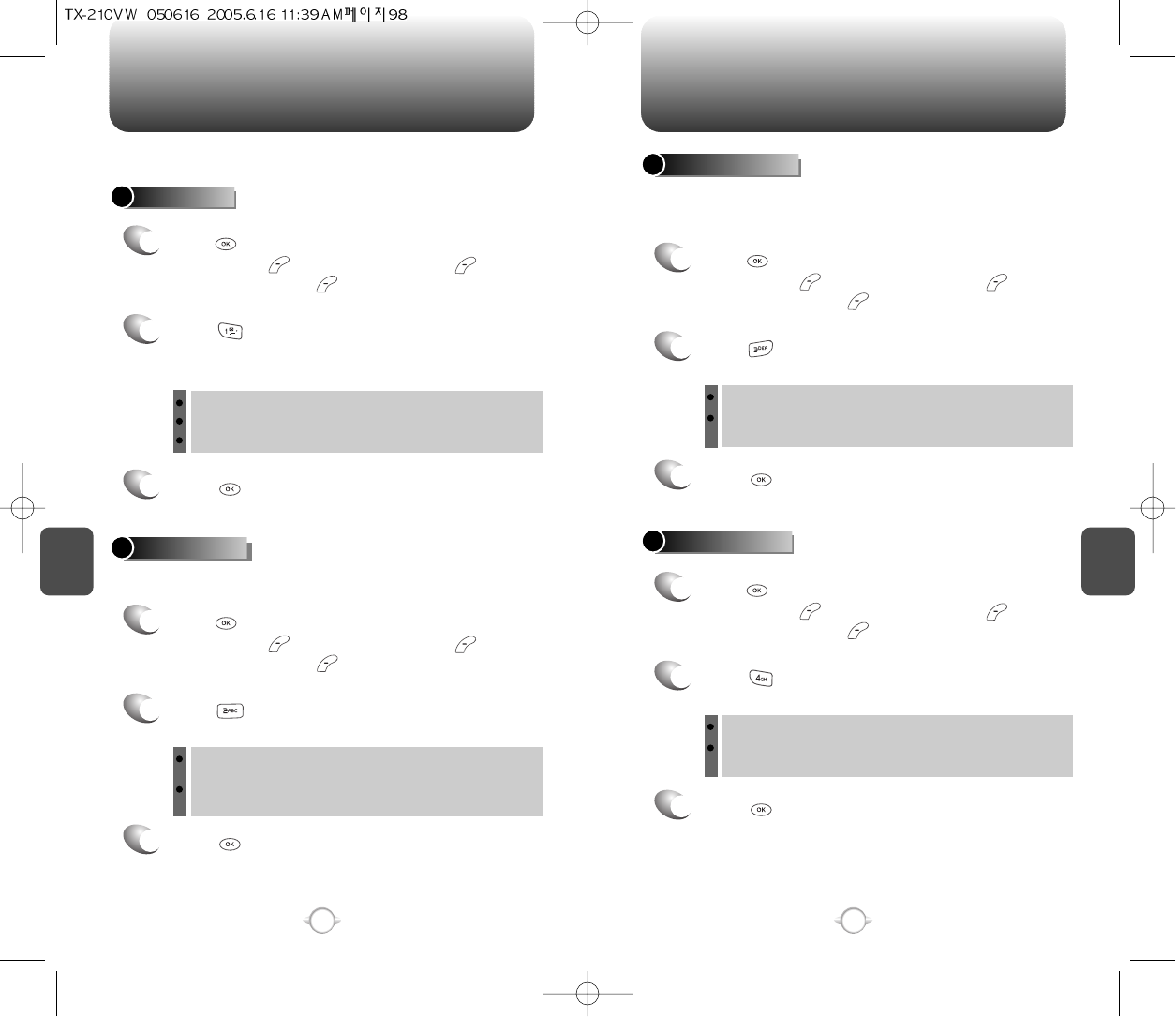
C
H
5
99
C
H
5
98
SETTINGSSETTINGS
AUTO SAVE
Press [AUTO SAVE].
Select “On”, “Off” or “Prompt” with the
Navigation Key.
Press [OK].
Manages messaging features through various features.
2
3
AUTO ERASE
Automatically erases inbox/sent messages when new messages
arrive.
1
Press [MENU], then select “Messaging”
menu, press [SETTINGS] or press
[MESSAGE], press [SETTINGS].
Press [AUTO ERASE].
Select “On” or “Off” with the Navigation Key.
Press [OK].
2
3
1
Press [MENU], then select “Messaging”
menu, press [SETTINGS] or press
[MESSAGE], press [SETTINGS].
AUTO VIEW TXT
Press [AUTO VIEW TXT].
Select “On” or “Off” with the Navigation Key.
Press [OK].
2
3
AUTO RECEIVE
1
Press [MENU], then select “Messaging”
menu, press [SETTINGS] or press
[MESSAGE], press [SETTINGS].
Press [AUTO RECEIVE].
Select “On” or “Off” with the Navigation Key.
Press [OK].
2
3
1
Press [MENU], then select “Messaging”
menu, press [SETTINGS] or press
[MESSAGE], press [SETTINGS].
If the “Auto View Txt” is set to on, the user will be able to view the
message by pressing the read key. If the “Auto View Txt” is set to
off, the user can view the message by entering SMS Menu-> Inbox.
On : All sent messages saved in the Sent box.
Off : All sent messages not saved in the Sent box
Prompt : “Yes”, “No” dialogue box displayed after sent message.
On : Oldest message erased frm inbox automatically when
message is full.
Off : Oldest message not erased frm inbox automatically when
message is full.
On : Text message be displayed automatically.
Off : User able to tetrieve the message from the inbox or based
on user input from interactive notification.
On : Pix msg downloaded autoamatically.
Off : User able to tetrieve the message from the inbox or based
on user input from interactive notification.
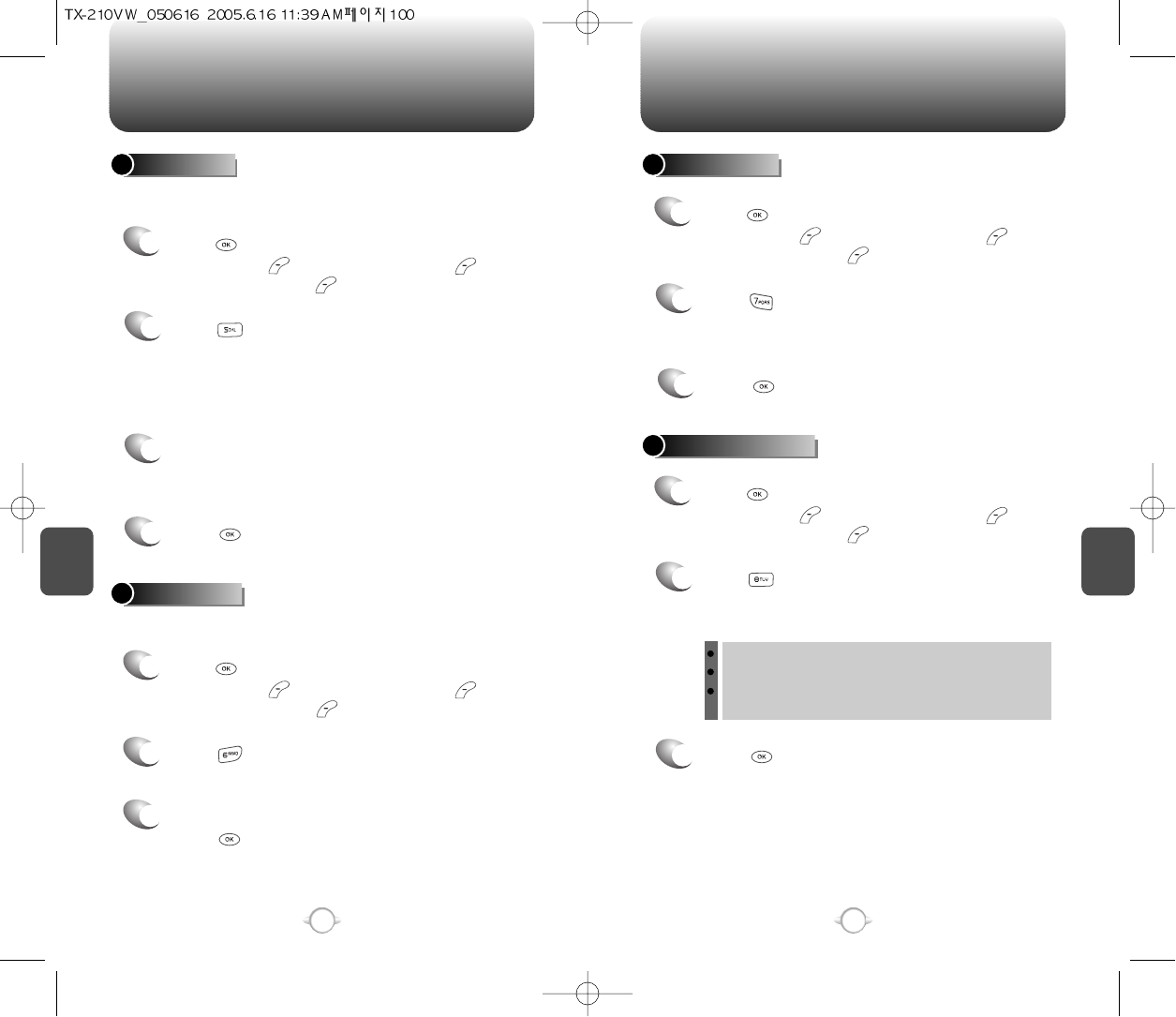
C
H
5
101
C
H
5
100
SETTINGSSETTINGS
Create a signature that can be automatically inserted at the end of a
message.
SIGNATURE
2
Press [SIGNATURE].
To activate Signature function, put the cursor
on Insert Signature then select “Custom” by
using right or left direction keys. To deactivate
Signature function, select “None”.
3
To input “Signature”, put the cursor on Edit
Signature then enter Signature Edit window by
using right or left direction keys.
4
Press [OK].
1
Press [MENU], then select “Messaging”
menu, press [SETTINGS] or press
[MESSAGE], press [SETTINGS].
VOICE MAIL#
2
Press [VOICE MAIL#].
Input a new voice call back number or edit
voice call back number.
3
Press [OK].
CALLBACK#
Edits a default callback number so that the recipient can callback or
reply.
Press [CALLBACK#].
Select “On” or “Off” with the Navigation Key.
Select “On”, then input a callback number,
press [OK].
2
3
1
Press [MENU], then select “Messaging”
menu, press [SETTINGS] or press
[MESSAGE], press [SETTINGS].
1
Press [MENU], then select “Messaging”
menu, press [SETTINGS] or press
[MESSAGE], press [SETTINGS].
1
Press [MENU], then select “Messaging”
menu, press [SETTINGS] or press
[MESSAGE], press [SETTINGS].
3
Press [OK].
BLOCK/UNBLOCK
2
Press [BLOCK/UNBLOCK].
Select “Block”, “Unblock” or “View List of
Blocked Addresses” with the Navigation Key.
BLOCK : Enter the address to block.
UNBLOCK : Enter the address to remove from block.
VIEW LIST OF BLOCKED ADDRESSES : Display the blocked
list on LCD.
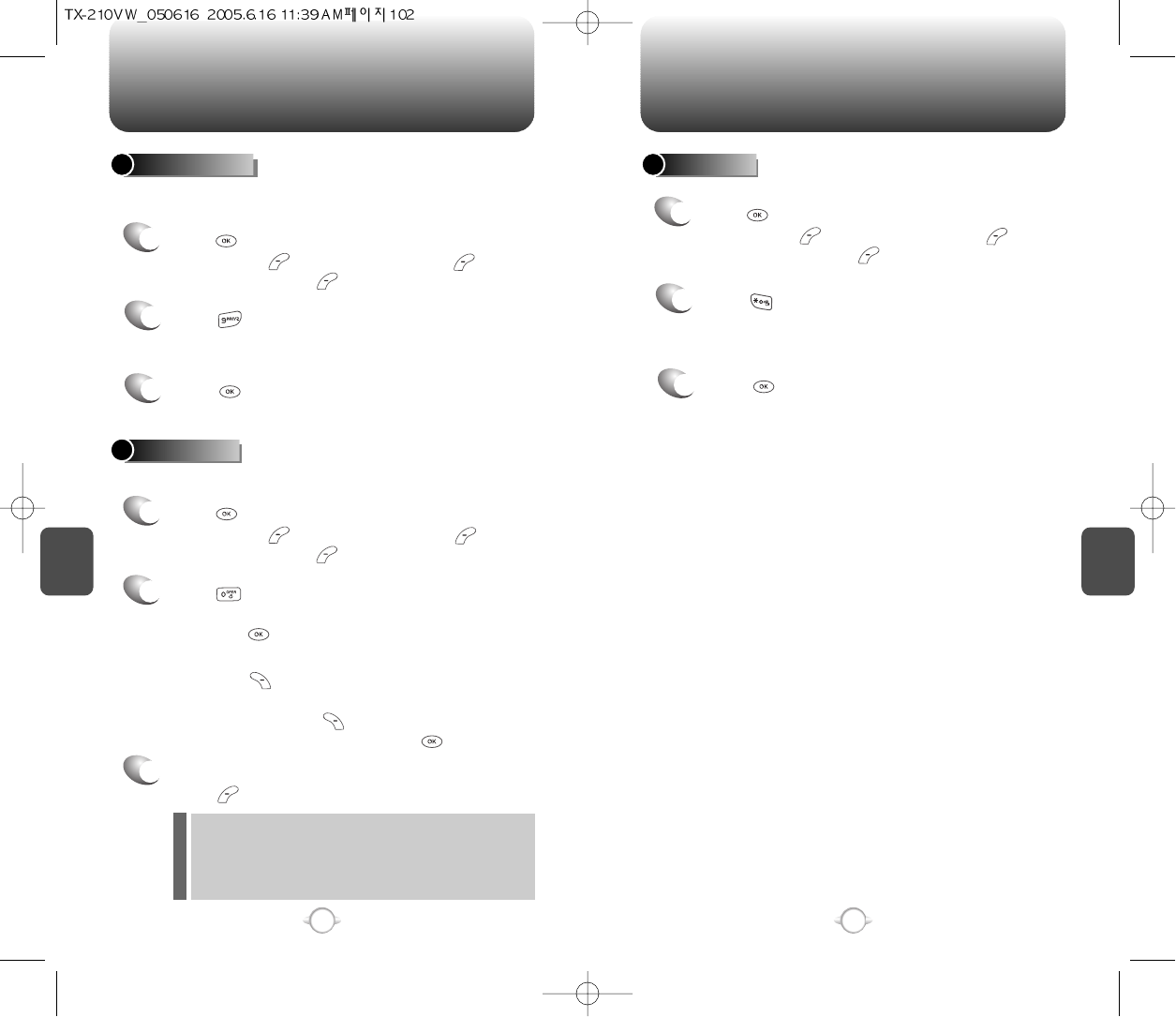
C
H
5
103
C
H
5
102
SETTINGSSETTINGS
FONT SIZE
2
Press [FONT SIZE].
Select “Small”, “Large” or “Normal” with the
Navigation Key.
3
Press [OK].
1
Press [MENU], then select “Messaging”
menu, press [SETTINGS] or press
[MESSAGES], press [SETTINGS].
ENTRY MODE
2
Press [ENTRY MODE].
Select “T9Word”, “Abc”, “ABC” or “123” with
the Navigation Key.
3
Press [OK].
Sets an Entry Mode as a default. For example, if T9 Mode is the
default, its icon will appear.
To edit the Quick Text message you have saved:
QUICK TEXT
2
Press [QUICK TEXT].
2.1. Select a message from the list.
Press [OK].
2.2. To add a new Quick Text message,
press [OPTIONS] to select “Add New”.
To edit the Quick Text message you have
selected, press [OPTIONS] to select
“Edit”, then enter text, press [SAVE].
3
To erase the saved Quick Text message,
press [ERASE].
1
Press [MENU], then select “Messaging”
menu, press [SETTINGS] or press
[MESSAGE], press [SETTINGS].
1
Press [MENU], then select “Messaging”
menu, press [SETTINGS] or press
[MESSAGE], press [SETTINGS].
Pre-defined quick text as below.
1. What’s up?/2. Lets meet/3. Check this out!/4. Whacha doin?/
5. Thanks/6. What do you think?/7. You’ve gotta be here to
enjoy this/8. Would you like to join me for a date tonight?/
9. On my way/10. Yes/11. You’re the best!/12. Call me
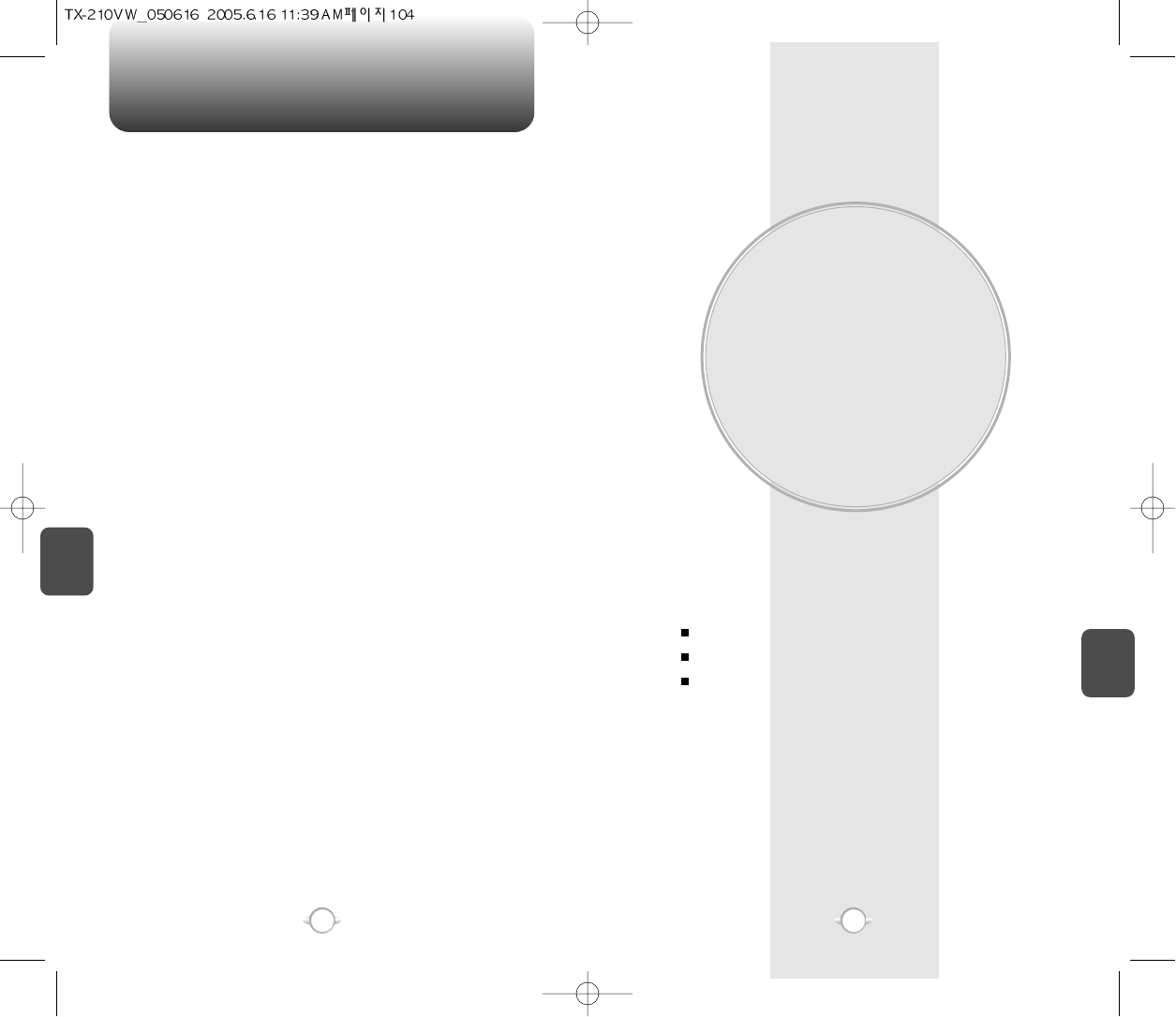
MEMO
GET IT NOW &
MOBILE WEB 2.0
Your phone provides a unique feature -Get It Now- that enables you
to download ringtones, wallpapers, games and more from your
network to your phone.
Or this chapter addresses Internet services and web browsing.
For more detailed information contact your service provider.
GET IT NOW
STARTING INTERNET BROWSER
BROWSER MENU
Chapter 6
105
C
H
5
C
H
6
104
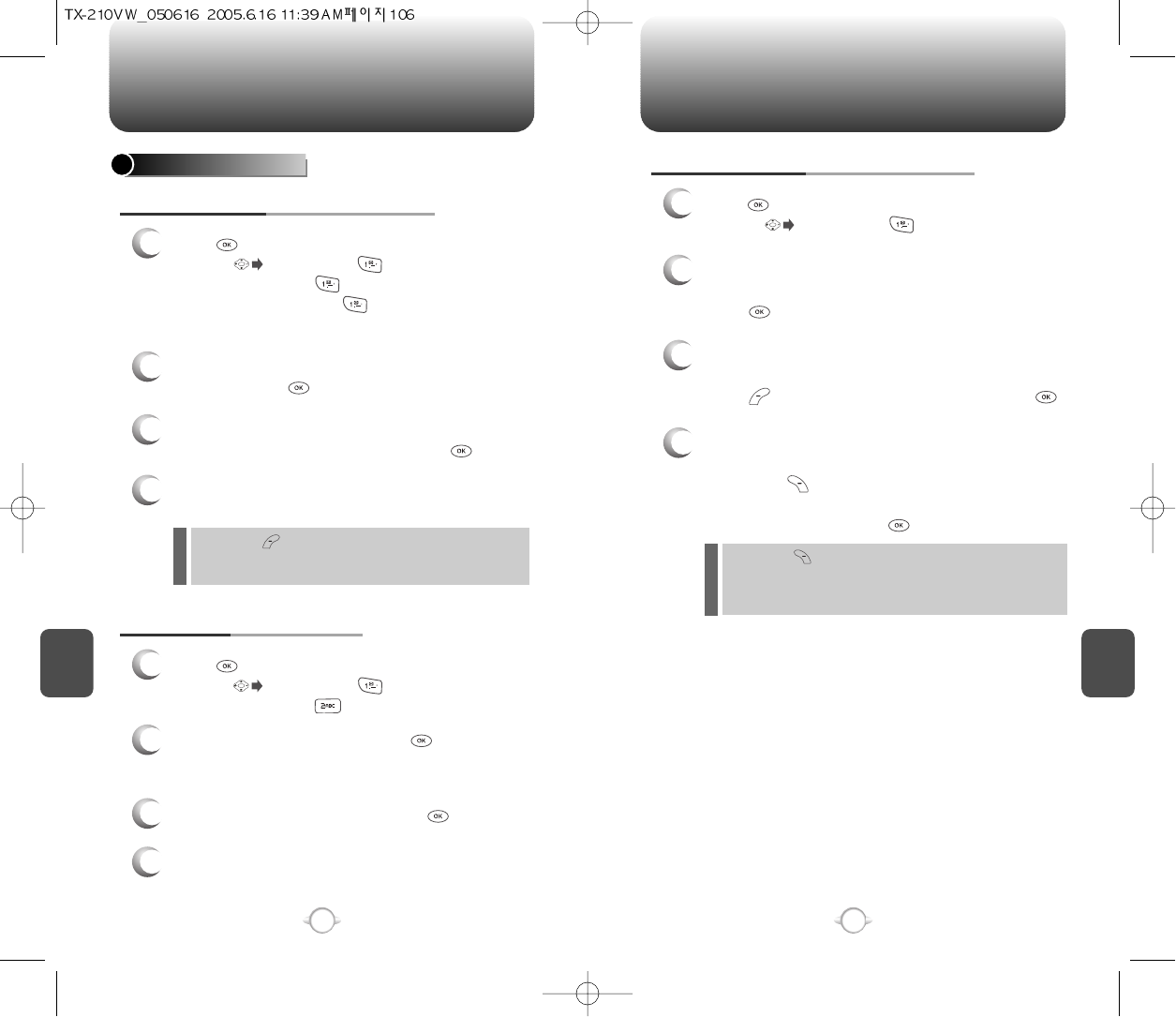
C
H
6
107
C
H
6
106
GET IT NOWGET IT NOW
GET TUNES & TONES
DOWNLOADING NEW TUNES & TONES
1
Press [MENU], then select “Get It now” menu
or press , then press “Get Tunes &
Tones” then select “Get New” the select
“New Provider”, press . (The BREW will
launch and take you to the download menu.)
3
Use your navigation key to select a “Tunes or
Tones” you wish to download, press [OK].
2
Use your navigation key to select a provider’s
browser, press [OK].
4
To save a downloaded tunes or tones to the
“Get Tunes & Tones” list and to sort file type.
USING DOWNLOADED TUNES & TONES
1
Press [MENU], then select “Get It now” menu
or press , then press “Get Tunes & Tones”.
2
To play downloaded tunes or tones.
Select the tunes or tones you want to play, then
press [PLAY].
3
To erase downloaded tunes or tones.
Select the tunes or tones you want to erase, then
press [EARSE], then select “Yes”, press .
4
To assign downloaded tunes or tones.
Select the tunes or tones you want to assign,
then press [OPTIONS].
Select “Set As Ringtone” or “Set As Ringer ID”,
then select “Yes”, press .
4
To save a downloaded tunes or tones to the
“Get Tunes & Tones” list and to sort file type.
By pressing [SOLT], you can choose sort type:
File type / Alphabet / Date (Recent-Old) /
File Size (Large-Small)
By pressing [OPTIONS], you can choose from the following:
1. Set As Ringtone
2. Set As Ringer ID
3. Rename
TO RECORDING NEW TONES
1
Press [MENU], then select “Get It now” menu
or press , then press “Get Tunes &
Tones” then select “Record New”.
3
To stop recording a memo, press [STOP].
2
To record a voice memo, press [OK]
Instructions will be displayed and you will hear
“Beep Sound”.
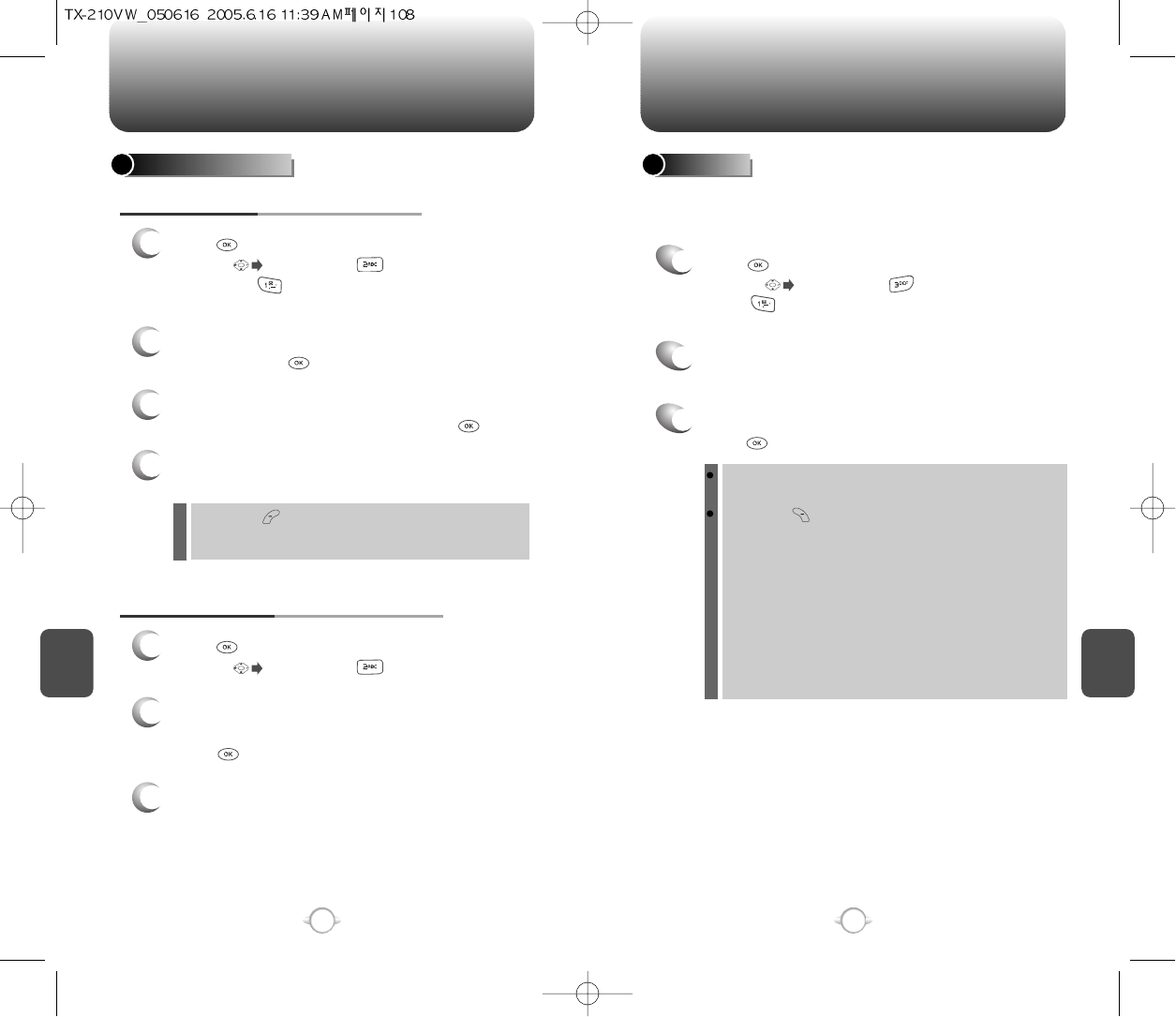
C
H
6
109
C
H
6
108
GET IT NOWGET IT NOW
GET FUN & GAMES
DOWNLOADING NEW FUN & GAMES
1
Press [MENU], then select “Get It now” menu
or press , then press “Get Fun & Games”
then select “Get New”. (The BREW will
launch and take you to the download menu.)
3
Use your navigation key to select a “Fun or
Games” you wish to download, press [OK].
2
Use your navigation key to select a provider’s
browser, press [OK].
4
To save a downloaded fun or games to the “Get
Fun & Games” list and to sort file type.
PLAYING DOWNLOADED FUN & GAMES
1
Press [MENU], then select “Get It now” menu
or press , then press “Get Fun & Games”.
2
To play downloaded fun or games.
Select the fun or games you want to play, then
press [PLAY].
3
To launch “BREW”.
By pressing [SOLT], you can choose sort type:
File type / Alphabet / Date (Recent-Old) /
File Size (Large-Small)
GALLERY
1
2
3
Select picture with the Navigation Key, then
press [VIEW]. You can see detail picture.
In Review Mode, you can view all the pictures
you have stored in your phone.
In Review Mode you can view all the pictures you have taken, store
selected images in your phone, send pictures to the Online Album,
delete images and access additional picture options.
Press [MENU], then select “Get It now” menu
or press , then press “Gallery” then
select “Get New”. (The BREW will launch
and take you to the download menu.)
In detail view, user can view previous or next picture by
pressing left or right navigation key.
By pressing [OPTIONS], you can choose from the following:
1. Send: To send a picture message.
2. To Pix Place: To uploading selected picture to pix server.
3. Set As: Assigns the selected pix to display for specific tasks.
(Wallpaper/Screen Saver/Picture ID/
Power On/Power Off.).
4. Rename: To edit the picture’s title.
5. Lock/Unlock: To select “Lock” or “Unlock”.
6. Erase: Erase the current picture from your phone.
7. Erase All: To erase all the pictures in your phone.
8. Pix Info: Displays information on the selected picture,
such as name, date, time, resolution and file size.
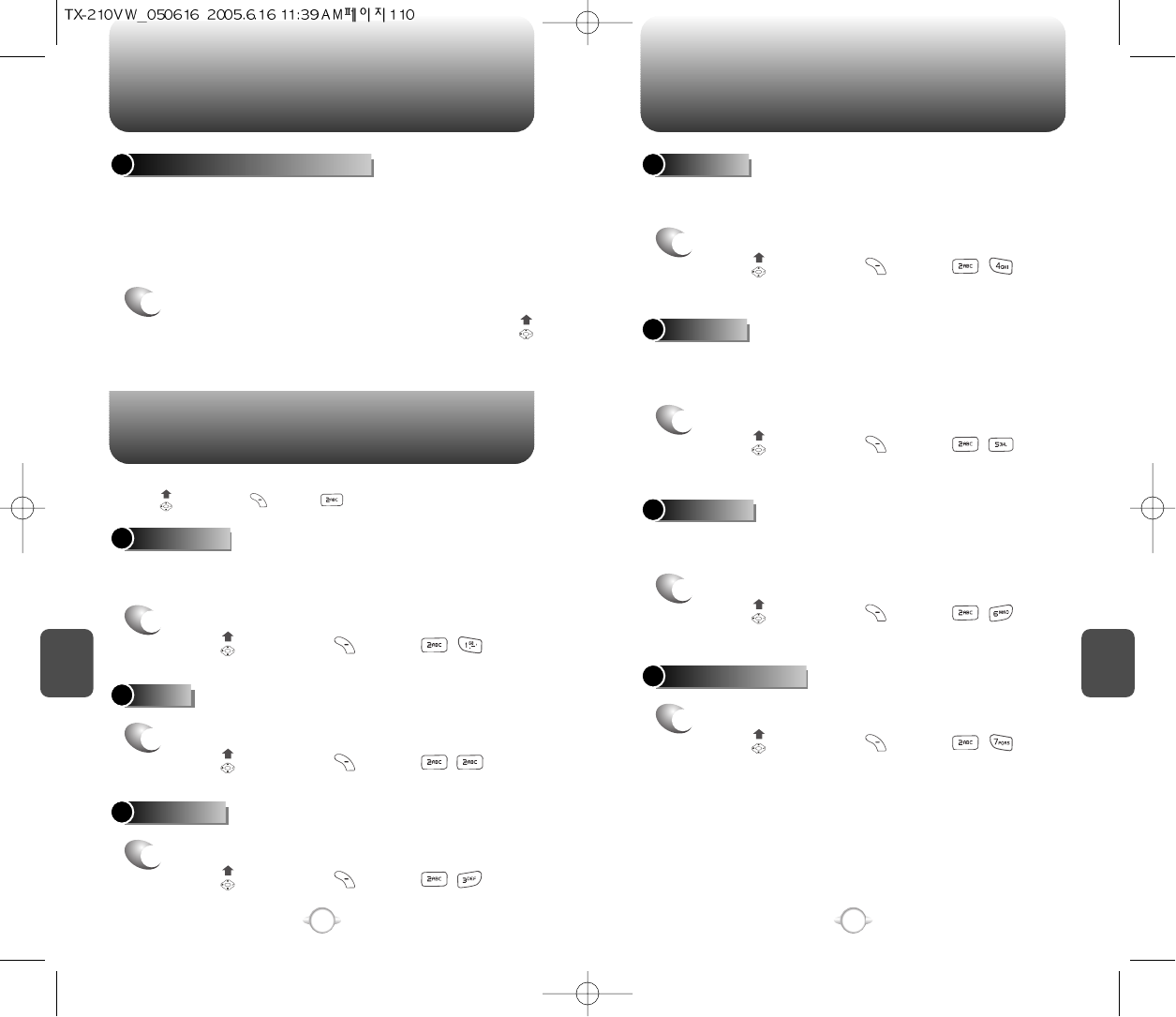
BROWSER MENU
STARTING INTERNET BROWSER BROWSER MENU
C
H
6
111
C
H
6
110
BACK
1
To return to the previous page.
Press , then press [MENU] .
LAUNCHING MOBILE WEB 2.0
1
To start your Internet browser and access
websites through your wireless handset press .
VZW HOME
1
To display the homepage.
Press , then press [MENU] .
ADDRESS
1
To select “Address”.
Press , then press [MENU] .
REFRESH
1
To select “Refresh”.
Press , then press [MENU] .
The browser menu lists the actions necessary to operate the browser.
press , then press [MENU] .
When the history item is selected from the browser menu, the browser
is displayed with the browser version and copyright information.
The device layer version is also displayed.
When the home item is selected from the browser menu, the phone
displays the home page.
Now you can access news, sports, weather, and e-mail from your
phone. Mobile Web 2.0 keeps you updated by providing access to
up-to-date information such as news, sports, weather and stock
quotes when you subscribe to Internet service with your service
provider. Please contact your service provider for a list of available
websites and service details.
Selecting the “Address” action displays the URL of the
current page.
Selecting the refresh item from the browser menu refreshes the current
page.
HISTORY
1
To select “History”.
Press , then press [MENU] .
FORWARD
1
To forward to the next page.
Press , then press [MENU] .
CLEAR MEMORY
1
To clear browser memory.
Press , then press [MENU] .
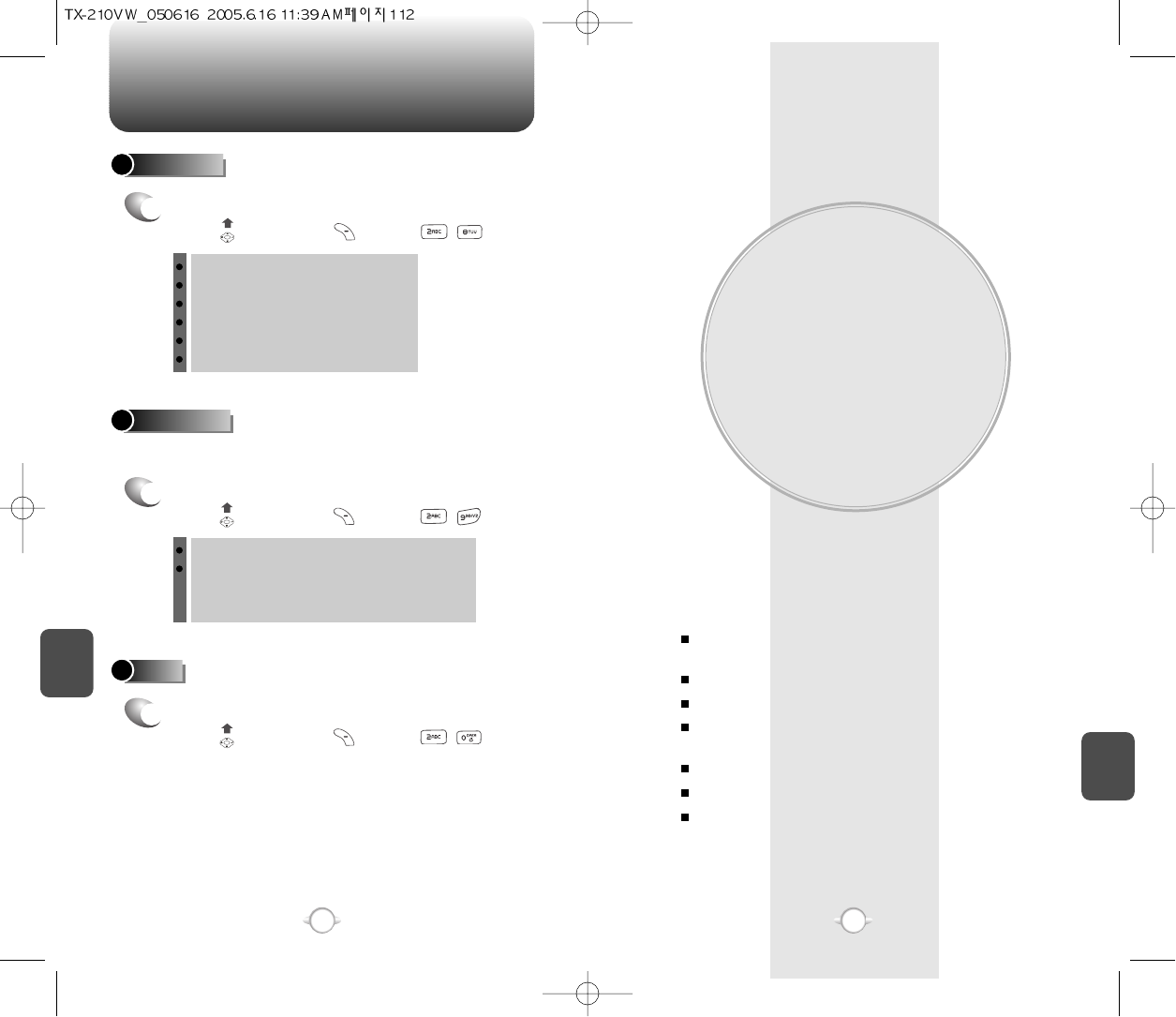
BROWSER MENU
SAFETY AND
WARRANTY
This chapter addresses the safety guidelines and precautions to
follow when operating your phone. Before operating your phone,
please be aware of all the safety details.
This chapter contains the terms and conditions of services and the
warranty for your phone. Please review them thoroughly.
SAFETY INFORMATION FOR WIRELESS
HANDHELD PHONES
SAFETY INFORMATION FOR FCC RF EXPOSURE
SAR INFORMATION
FCC Hearing-Aid Compatibility (HAC) Regulations for
Wireless Devices
FDA CONSUMER UPDATE
PROTECT YOUR WARRANTY
12 MONTH LIMITED WARRANTY
Chapter 7
113
C
H
6
C
H
7
112
ADVANCED
1
To select “Advanced”.
Press , then press [MENU] .
Selecting the advanced item in the browser menu displays the
advanced menu items.
To exit browser.
Press , then press [MENU] .
EXIT
1
SETTINGS
1
To select “Settings”.
Press , then press [MENU] .
Downloads
Restart Browser
Scroll Mode
Send Referrer
Key Press Timeout
Connection Timeout
About...
Encryption: 1. Authentication
2. Root Certificate
3. Current Certificate
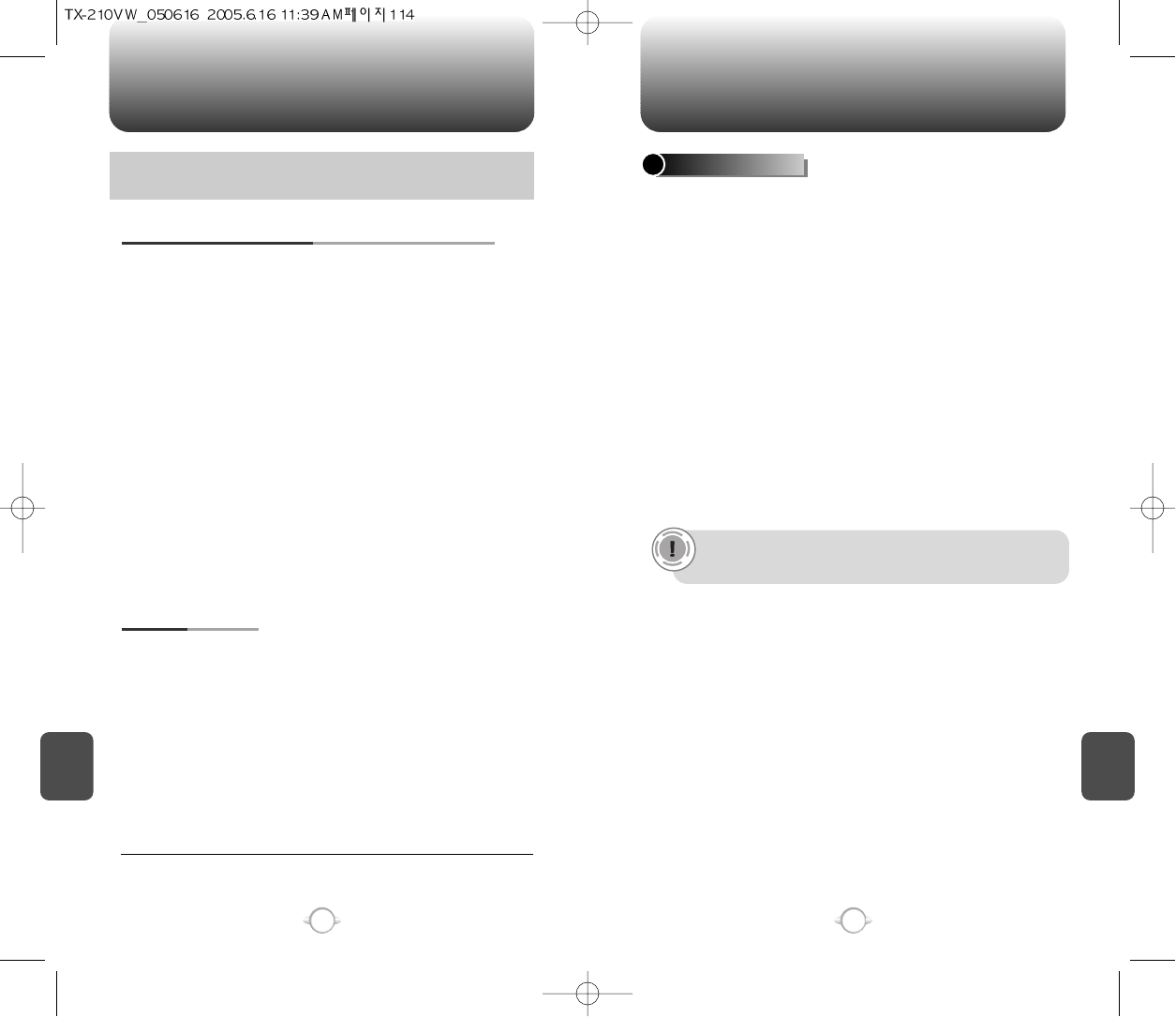
SAFETY INFORMATION FOR WIRELESS
HANDHELD PHONES SAFETY INFORMATION FOR WIRELESS
HANDHELD PHONES
115
C
H
7
C
H
7
114
Your wireless handheld portable telephone is a low power radio
transmitter and receiver. When it is ON, it receives and also sends out
radio frequency (RF) signals.
In August 1996, the Federal Communications Commissions (FCC)
adopted RF exposure guidelines with safety levels for handheld wireless
phones. Those guidelines are consistent with the safety standards
previously set by both U.S. and international standards bodies:
ANSI C95.1 (1992) *
NCRP Report 86 (1986) *
ICNIRP (1996) *
Those standards were based on comprehensive and periodic evaluations
of the relevant scientific literature. For example, over 120 scientists,
engineers, and physicians from universities, government health agencies,
and industry reviewed the available body of research to develop the ANSI
Standard (C951).
The design of your phone complies with the FCC guidelines (and those
standards).
EXPOSURE TO RADIO FREQUENCY SIGNALS
Use only the supplied or an approved replacement antenna. Unauthorized
antennas, modifications, or attachments could damage the phone and
may violate FCC regulations.
ANTENNA CARE
Read This Information Before Using Your Handheld
Portable Cellular Telephone
Talking on the phone while driving is extremely dangerous and is illegal in
some states. Remember, safety comes first. Check the laws and regulations
on the use of phones in the areas where you drive. Always obey them.
Also, if using your phone while driving, please:
lGive full attention to driving. Driving safely is your first responsibility.
lUse hands-free operation, if available.
lPull off the road and park before making or answering a call, if driving
conditions so require.
If you must use the phone while driving, please use one-touch, speed dialing,
and auto answer modes.
An airbag inflates with great force. DO NOT place objects, including both
installed or portable wireless equipment, in the area over the airbag or in the
air bag deployment area. If in-vehicle wireless equipment is improperly
installed and the air bag inflates, serious injury could result.
DRIVING SAFETY
WARNING: Failure to follow these instructions may lead to serious
personal injury and possible property damage.
1* : American National Standards Institute.
2* : National Council on Radiation protection and measurements.
3* : International Commission on Nonionizing Radiation Protection.
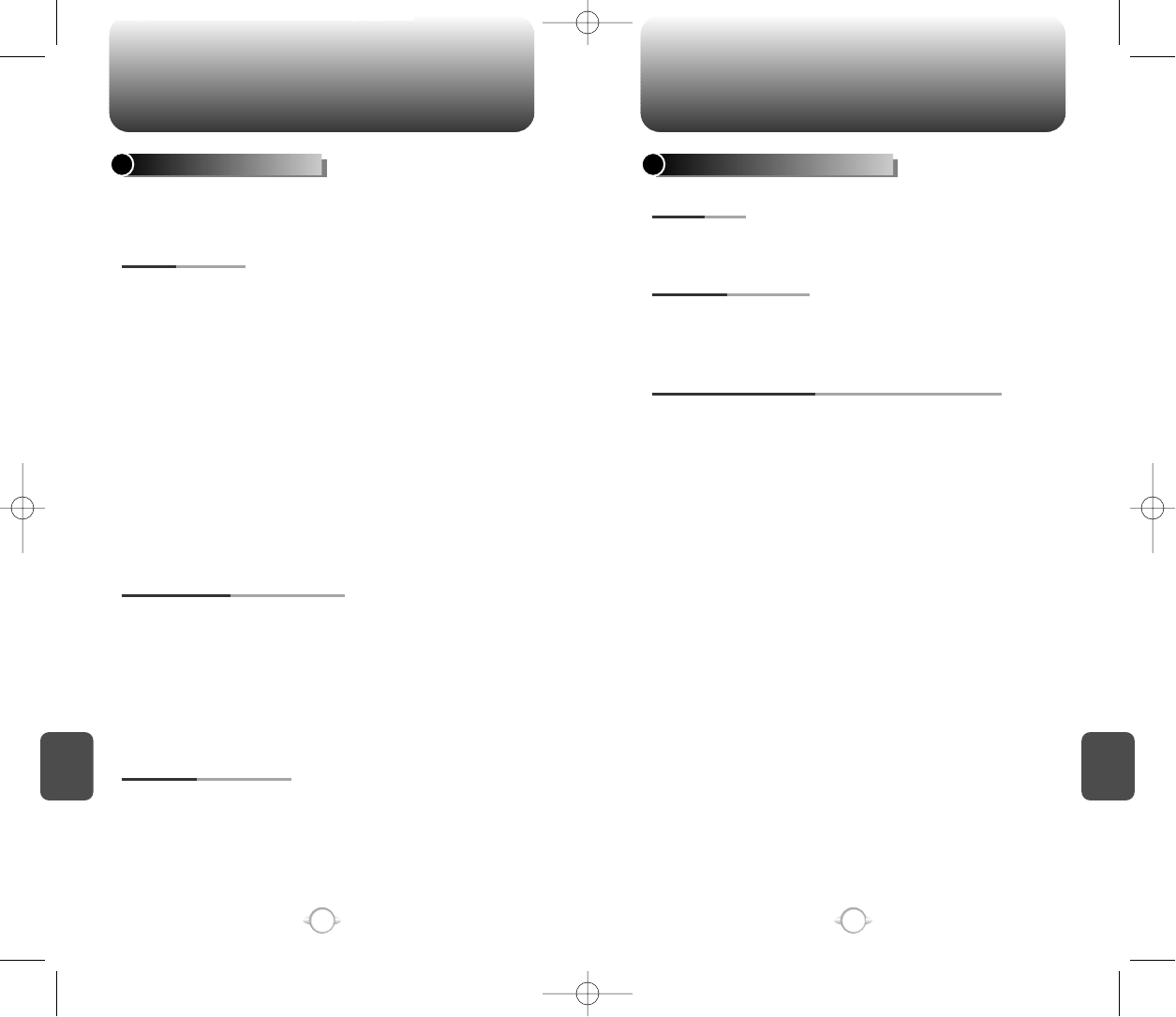
SAFETY INFORMATION FOR WIRELESS
HANDHELD PHONES
SAFETY INFORMATION FOR WIRELESS
HANDHELD PHONES
117116
The Health Industry Manufacturers Association recommends that a
minimum separation of six (6”) inches be maintained between a handheld
wireless phone and a pacemaker to avoid potential interference with the
pacemaker. These recommendations are consistent with the independent
research by and recommendations of Wireless Technology Research.
Persons with pacemakers :
lALWAYS keep the phone more than six inches from your
pacemaker when the phone is turned on.
lDo not carry the phone in a breast pocket.
lUse the ear opposite the pacemaker to minimize the potential for
interference.
lIf you have any reason to suspect that interference is taking place,
turn your phone OFF immediately.
PACEMAKERS
If you use any other personal medical device, consult the manufacturer of
your device to determine if they are adequately shielded from external RF
energy. Your physician may be able to assist you in obtaining this
information.
Turn your phone OFF in healthcare facilities when any regulations posted
in these areas instruct you to do so. Hospitals or healthcare facilities may
be using equipment that could be sensitive to external RF energy.
OTHER MEDICAL DEVICES
Turn your phone OFF where posted notices so require.
POSTED FACILITIES
ELECTRONIC DEVICES
Most modern electronic equipment is shielded from RF energy. However,
certain electronic equipment may not be shielded against the RF signals
from your wireless phone.
OTHER SAFETY GUIDELINES
FCC and Transport Canada Regulations prohibit using your phone while
in the air. Turn your phone OFF before boarding an aircraft.
AIRCRAFT
To avoid interfering with blasting operations, turn your phone OFF when in
a “blasting area” or in areas posted: “Turn off two-way radio.” Obey all
signs and instructions.
BLASTING AREAS
Turn your phone OFF when in any area with a potentially explosive
atmosphere and obey all signs and instructions. Sparks in such areas
could cause an explosion or fire resulting in bodily injury or even
death.
Areas with a potentially explosive atmosphere are often, but not
always, clearly marked. They include fueling areas such as gas
stations; below deck on boats; fuel or chemical transfer or storage
facilities; vehicles using liquefied petroleum gas (such as propane or
butane); areas where the air contains chemicals or particles, such as
grain, dust, or metal powders; and any other area where you would
normally be advised to turn off your vehicle’s engine.
POTENTIALLY EXPLOSIVE ATMOSPHERES
C
H
7
C
H
7
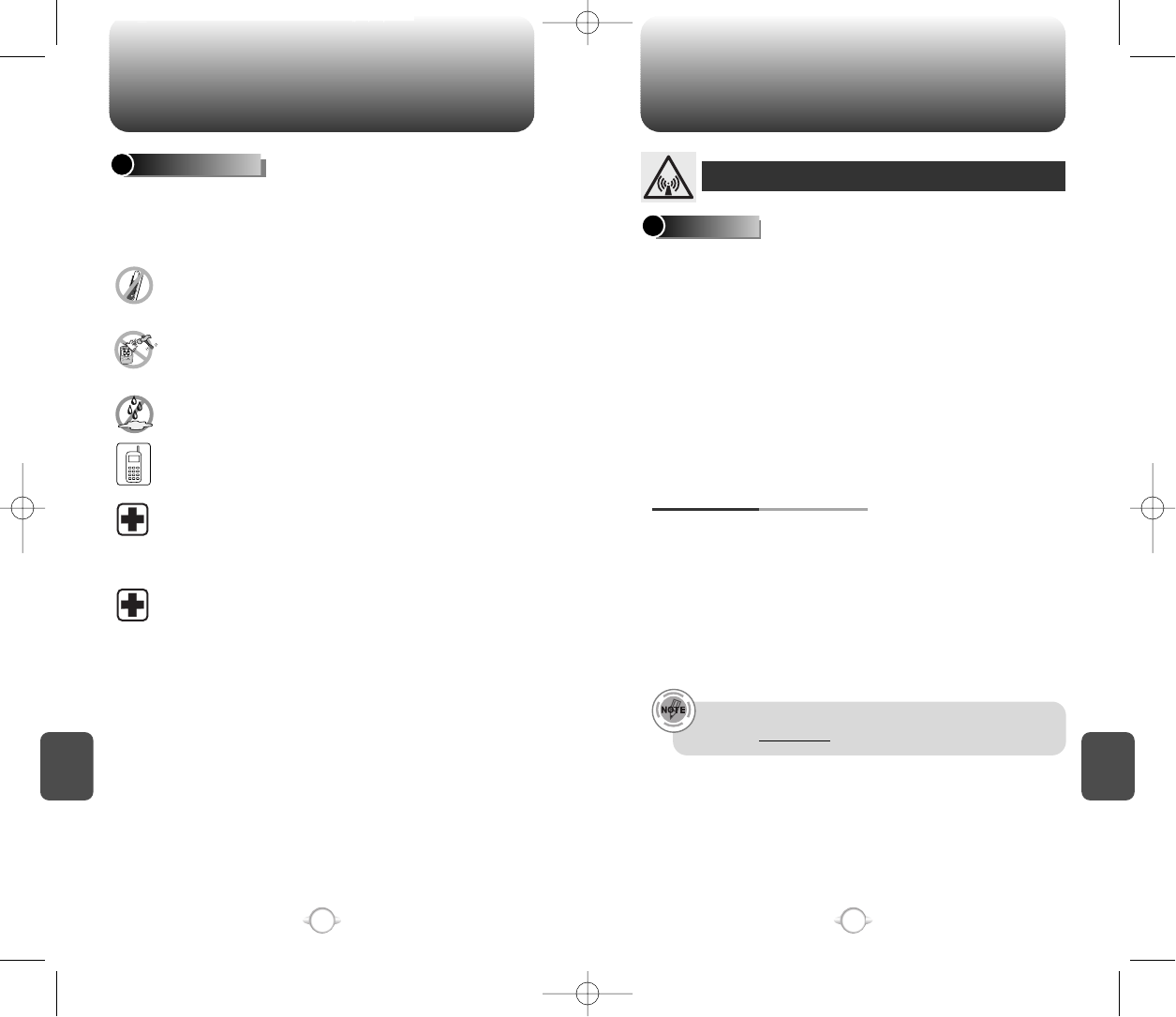
SAFETY INFORMATION FOR WIRELESS
HANDHELD PHONES
SAFETY INFORMATION FOR
FCC RF EXPOSURE
119118
PRECAUTIONS
Your Handheld Portable Telephone is a high quality piece of
equipment. Before operating, read all instructions and cautionary
markings on (1) AC Adaptor (2) Battery and (3) Product Using Battery.
DO NOT use this equipment in an extreme environment where
high temperature or high humidity exists.
DO NOT abuse the equipment. Avoid striking, shaking or
shocking. When not using, lay down the unit to avoid possible
damage due to instability.
DO NOT expose this equipment to rain or spilled beverages.
DO NOT use unauthorized accessories.
DO NOT disassemble the phone or its accessories. If service
or repair is required, return unit to an authorized Audiovox
cellular service center. If unit is disassembled, the risk of
electric shock or fire may result.
DO NOT short-circuit the battery terminals with metal items etc.
In August 1996 the Federal Communications Commission (FCC) of
the United States with its action in Report and Order FCC 96-326
adopted an updated safety standard for human exposure to radio
frequency electromagnetic energy emitted by FCC regulated
transmitters. Those guidelines are consistent with the safety standard
previously set by both U.S. and international standards bodies. The
design of this phone complies with the FCC guidelines and these
international standards.
Use only the supplied or an approved antenna. Unauthorized
antennas, modifications, or attachments could impair call quality,
damage the phone, or result in violation of FCC regulations.
Do not use the phone with a damaged antenna. If a damaged
antenna comes into contact with the skin, a minor burn may result.
Please contact your local dealer for replacement antenna.
This device was tested for typical body-worn operations with the
back of the phone kept 2.0 cm. from the body. To maintain
compliance with FCC RF exposure requirements, use only belt-clips,
holsters or similar accessories that maintain a 2.0 cm. separation
distance between the user’s body and the back of the phone,
including the antenna. The use of belt-clips, holsters and similar
accessories should not contain metallic components in its assembly.
The use of accessories that do not satisfy these requirements may
not comply with FCC RF exposure requirements, and should be
avoided.
BODY-WORN OPERATION
WARNING! Read this Information before using
CAUTIONS
For more information about RF exposure, please visit the FCC
website at www.fcc.gov.
C
H
7
C
H
7
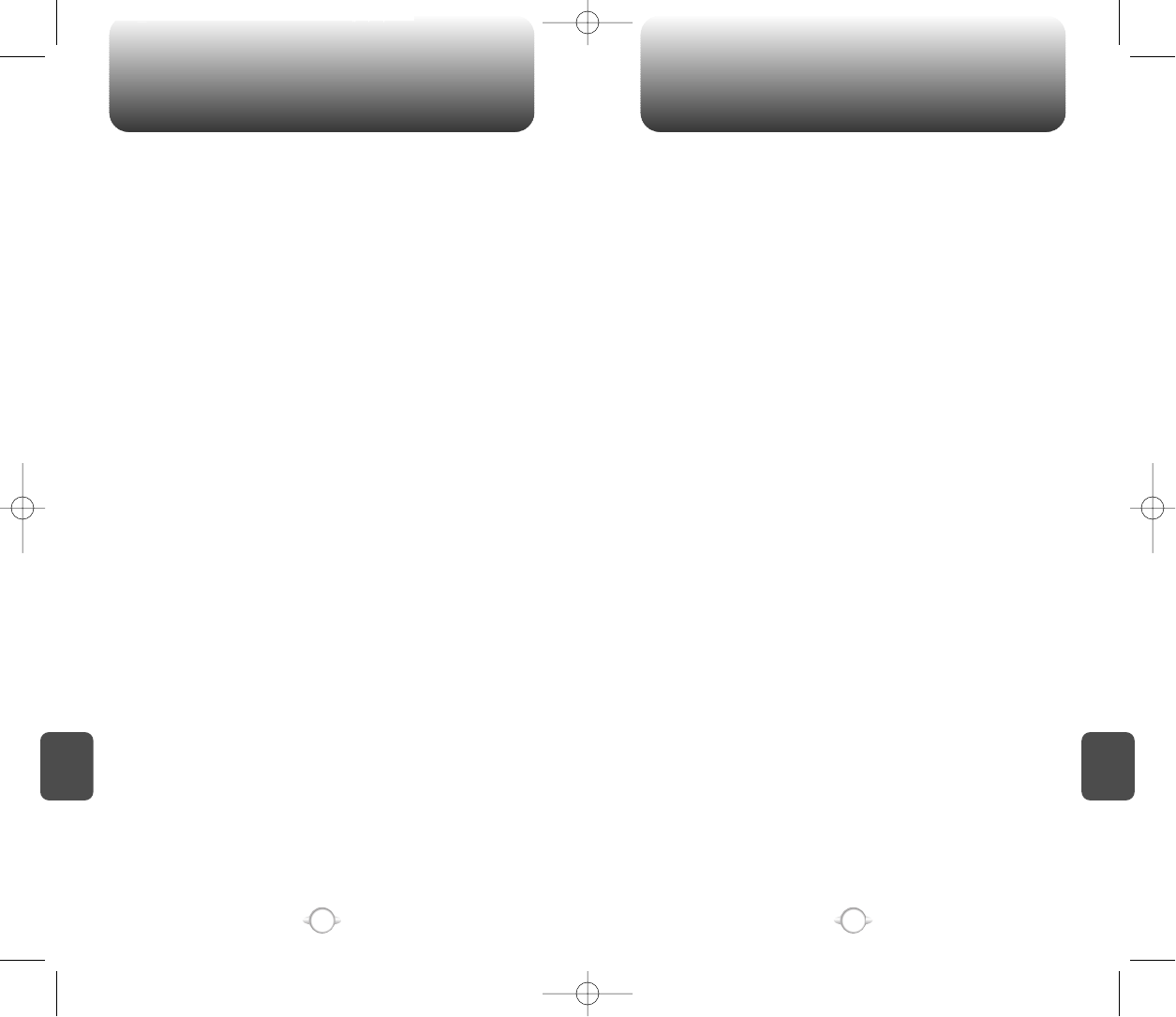
SAR INFORMATION SAR INFORMATION
121120
THIS MODEL PHONE MEETS THE GOVERNMENT’S
REQUIREMENTS FOR EXPOSURE TO RADIO WAVES.
Your wireless phone is a radio transmitter and receiver. It is designed
and manufactured not to exceed the emission limits for exposure to
radiofrequency (RF) energy set by the Federal Communications
Commission of the U.S. Government. These limits are part of
comprehensive guidelines and establish permitted levels of RF energy
for the general population. The guidelines are based on standards that
were developed by independent scientific organizations through
periodic and thorough evaluation of scientific studies. The standards
include a substantial safety margin designed to assure the safety of all
persons, regardless of age and health.
The exposure standard for wireless mobile phones employs a unit of
measurement known as the Specific Absorption Rate, or SAR. The SAR
limit set by the FCC is 1.6 W/kg. * Tests for SAR are conducted with the
phone transmitting at its highest certified power level in all tested
frequency bands. Although the SAR is determined at the highest
certified power level, the actual SAR level of the phone while operating
can be well below the maximum value. This is because the phone is
designed to operate at multiple power levels so as to use only the
power required to reach the network. In general, the closer you are to a
wireless base station antenna, the lower the power output.
Before a phone model is available for sale to the public, it must be
tested and certified to the FCC that it does not exceed the limit
established by the government adopted requirement for safe exposure.
The tests are performed in positions and locations (e.g., at the ear and
worn on the body) as required by the FCC for each model. The highest
SAR value for this model phone when tested for use at the ear is 1.35
W/Kg and when worn on the body, as described in this user guide, is
1.05W/Kg. (Body-worn measurements differ among phone models,
depending upon available accessories and FCC requirements). While
there may be differences between the SAR levels of various phones
and at various positions, they all meet the government requirement for
safe exposure.
The FCC has granted an Equipment Authorization for this model phone
with all reported SAR levels evaluated as in compliance with the FCC
RF exposure guidelines. SAR information on this model phone is on file
with the FCC and can be found under the Display Grant section of
http://www.fcc.gov/oet/fccid after searching on PP4TX-210.
Additional information on Specific Absorption Rates (SAR) can be found
on the Cellular Telecommunications Industry Asso-ciation (CTIA) web-
site at http://www.wow-com.com.
* In the United States and Canada, the SAR limit for mobile phones
used by the public is 1.6 watts/kg (W/kg) averaged over one gram of
tissue. The standard incorporates a sub-stantial margin of safety to give
additional protection for the public and to account for any variations in
measurements.
C
H
7
C
H
7
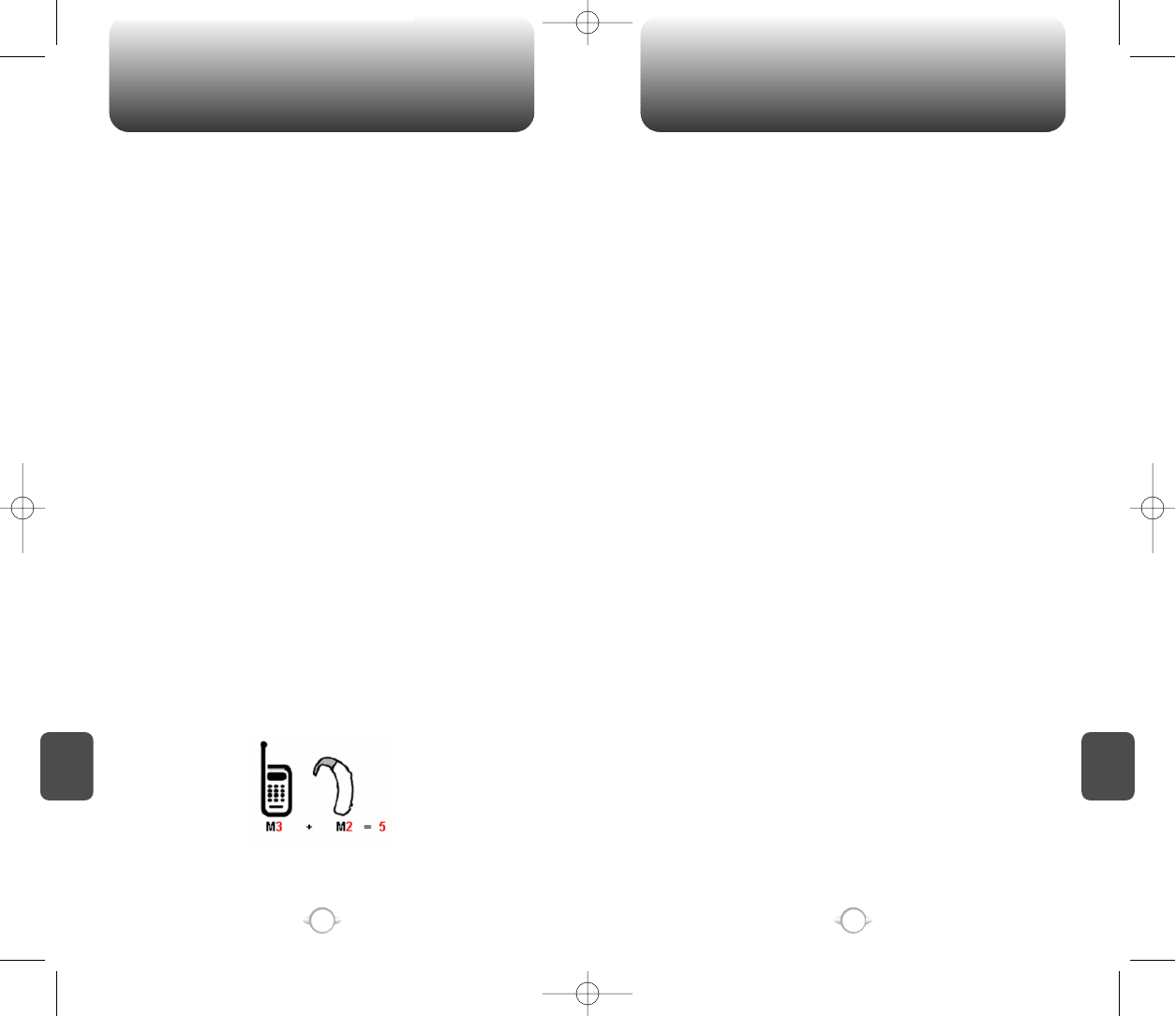
123122
C
H
7
C
H
7
On July 10, 2003, the U.S. Federal Communications Commission
(FCC) Report and Order in WT Docket 01-309 modified the exception of
wireless phones under the Hearing Aid Compatibility Act of 1988 (HAC
Act) to require digital wireless phones be compatible with hearing-aids.
The intent of the HAC Act is to ensure reasonable access to
telecommunications services for persons with hearing disabilities.
While some wireless phones are used near some hearing devices
(hearing aids and cochlear implants), users may detect a buzzing,
humming, or whining noise. Some hearing devices are more immune
than others to this interference noise, and phones also vary in the
amount of interference they generate.
The wireless telephone industry has developed a rating system for
wireless phones, to assist hearing device users find phones that may be
compatible with their hearing devices. Not all phones have been rated.
Phones that are rated have the rating on their box or a label located on
the box.
The ratings are not guarantees. Results will vary depending on the
user’s hearing device and hearing loss. If your hearing device happens
to be vulnerable to interference, you may not be able to use a rated
phone successfully. Trying out the phone with your hearing device is
the best way to evaluate it for your personal needs.
M-Ratings: Phones rated M3 or M4 meet FCC requirements and are
likely to generate less interference to hearing devices than phones that
are not labeled. M4 is the better/higher of the two ratings.
Hearing devices may also be rated. Your hearing device manufacturer
or hearing health professional may help you find this rating. Higher
ratings mean that the hearing device is relatively immune to interference
noise. The hearing aid and wireless phone rating values are then added
together. A sum of 5 is considered acceptable for normal use. A sum of
6 is considered for best use.
In the above example, if a hearing aid meets the M2 level rating and the
wireless phone meets the M3 level rating, the sum of the two values
equal M5. This should provide the hearing aid user with “normal usage”
while using their hearing aid with the particular wireless phone. “Normal
usage” in this context is defined as a signal quality that is acceptable
for normal operation.
The M mark is intended to be synonymous with the U mark. The T mark
is intended to be synonymous with the UT mark. The M and T marks
are recommended by the Alliance for Telecommunications Industries
Solutions (ATIS). The U and UT marks are referenced in Section 20.19
of the FCC Rules. The HAC rating and measurement procedure are
described in the American National Standards Institute (ANSI) C63.19
standard.
For information about hearing aids and digital wireless phone
lFcc Hearing Aid Compatibility and Volume Control
http://www.fcc.gov/cgb/dro/hearing.html
lGallaudet University, RERC
http://tap.gallaudet.edu/DigWireless.KS/DigWireless.htm
lSelf Help for Hard of Hearing People Inc. [SHHH]
www.hearinglpss.org/hat/TipsWirelessPhone.htm
lThe Hearing Aid Compatibility FCC Order
http://hraunfoss.fcc.gov/edocs_public/attachmatch/
FCC-03-168A1.pdf
FCC HEARING-AID COMPATIBILITY (HAC)
REGULATIONS FOR WIRELESS DEVICES FCC HEARING-AID COMPATIBILITY (HAC)
REGULATIONS FOR WIRELESS DEVICES
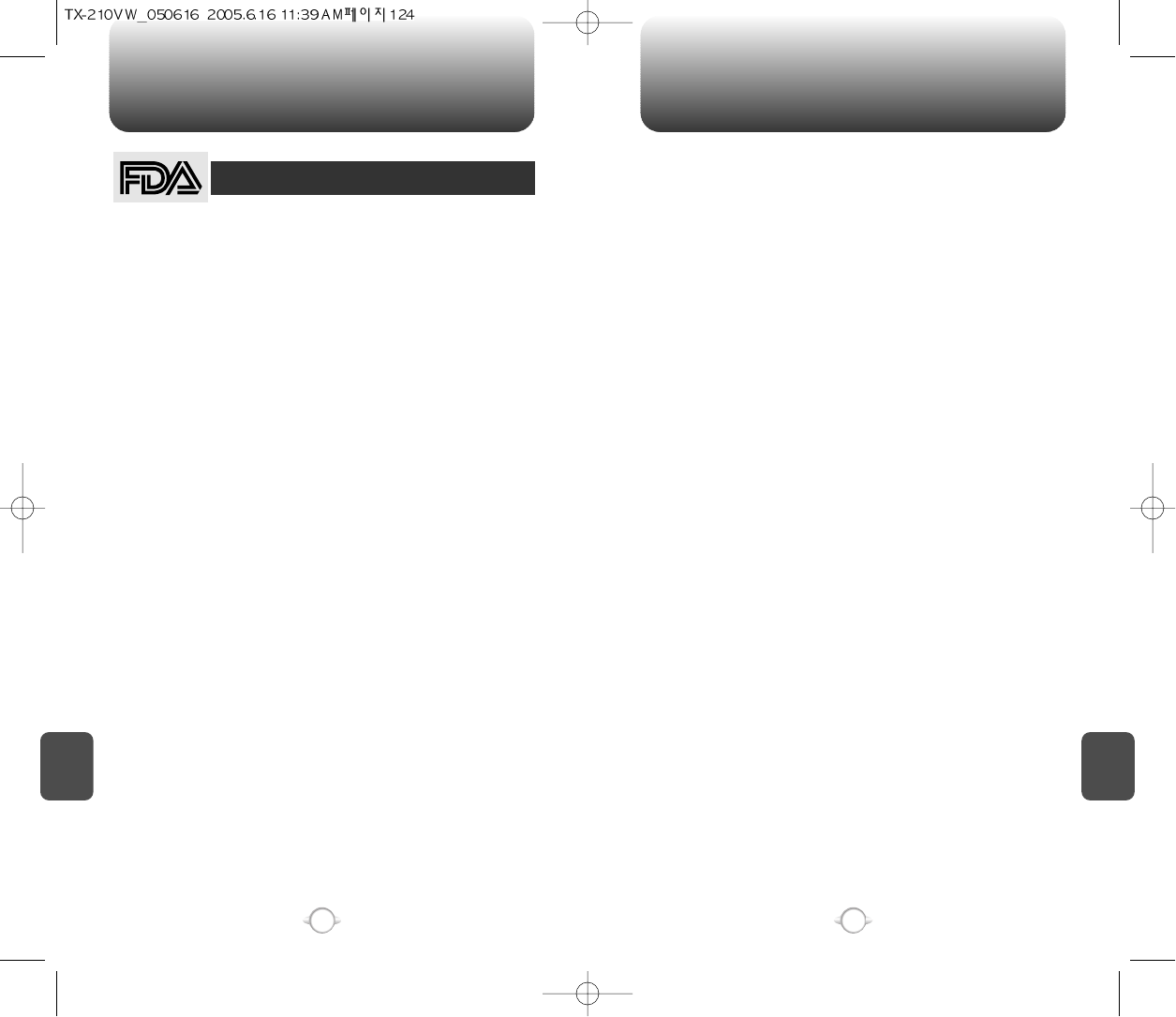
125124
FDA CONSUMER UPDATE FDA CONSUMER UPDATE
C
H
7
C
H
7
These types of wireless phones can expose the user to measurable radiofrequency
energy (RF) because of the short distance between the phone and the user’s head.
These RF exposures are limited by Federal Communications Commission safety
guidelines that were developed with the advice of FDA and other federal health and
safety agencies. When the phone is located at greater distances from the user, the
exposure to RF is drastically lower because a person’s RF exposure decreases
rapidly with increasing distance from the source. The so-called “cordless phones,”
which have a base unit connected to the telephone wiring in a house, typically
operate at far lower power levels, and thus produce RF expo-sures far below the
FCC safety limits.
4. What are the results of the research done already?
The research done thus far has produced conflicting results, and many studies
have suffered from flaws in their research methods. Animal experiments
investigating the effects of radiofrequency energy (RF) exposures characteristic of
wire-less phones have yielded conflicting results that often cannot be repeated in
other laboratories. A few animal studies, how-ever, have suggested that low levels
of RF could accelerate the development of cancer in laboratory animals. However,
many of the studies that showed increased tumor develop-ment used animals that
had been genetically engineered or treated with cancer-causing chemicals so as to
be pre-dis-posed to develop cancer in the absence of RF exposure. Other studies
exposed the animals to RF for up to 22 hours per day. These conditions are not
similar to the conditions under which people use wireless phones, so we don’t
know with certainty what the results of such studies mean for human health. Three
large epidemiology studies have been published since December 2000. Between
them, the studies investigated any possible association between the use of
wireless phones and primary brain cancer, glioma, meningioma, or acoustic neu-
roma, tumors of the brain or salivary gland, leukemia, or other cancers. None of the
studies demonstrated the existence of any harmful health effects from wireless
phone RF exposures. However, none of the studies can answer questions about
long-term exposures, since the average period of phone use in these studies was
around three years.
5. What research is needed to decide whether RF expo-sure from wireless
phones poses a health risk?
A combination of laboratory studies and epidemiological stud-ies of people
actually using wireless phones would provide some of the data that are needed.
Lifetime animal exposure studies could be completed in a few years. However,
very large numbers of animals would be needed to provide reliable proof of a
cancer promoting effect if one exists. Epidemiological stud-ies can provide data
that is directly applicable to human popu-lations, but 10 or more years’ follow-up
may be needed to pro-vide answers about some health effects, such as cancer.
This is because the interval between the time of exposure to a can-cer- causing
agent and the time tumors develop - if they do -may be many, many years. The
interpretation of epidemiologi-cal studies is hampered by difficulties in measuring
actual RF exposure during day-to-day use of wireless phones. Many fac-tors affect
this measurement, such as the angle at which the phone is held, or which model of
phone is used.
6. What is FDA doing to find out more about the possible health effects of
wireless phone RF?
FDA is working with the U.S. National Toxicology Program and with groups of
investigators around the world to ensure that high priority animal studies are
conducted to address impor-tant questions about the effects of exposure to
radiofrequency energy (RF). FDA has been a leading participant in the World Health
Orga-nization International Electromagnetic Fields (EMF) Project since its inception
in 1996. An influential result of this work has been the development of a detailed
agenda of research needs that has driven the establishment of new research pro-
grams around the world.
1. Do wireless phones pose a health hazard?
The available scientific evidence does not show that any health problems are
associated with using wireless phones. There is no proof, however, that wireless
phones are absolutely safe. Wireless phones emit low levels of radiofrequency
energy (RF) in the microwave range while being used. They also emit very low
levels of RF when in the stand-by mode. Whereas high levels of RF can produce
health effects (by heating tissue), exposure to low level RF that does not produce
heating ef-fects causes no known adverse health effects. Many studies of low level
RF exposures have not found any biological ef-fects. Some studies have
suggested that some biological ef-fects may occur, but such findings have not
been confirmed by additional research. In some cases, other researchers have had
difficulty in reproducing those studies, or in determining the reasons for
inconsistent results.
2. What is FDA’s role concerning the safety of wireless phones?
Under the law, FDA does not review the safety of radiation-emitting consumer
products such as wireless phones before they can be sold, as it does with new
drugs or medical de-vices. However, the agency has authority to take action if
wire-less phones are shown to emit radiofrequency energy (RF) at a level that is
hazardous to the user. In such a case, FDA could require the manufacturers of
wireless phones to notify users of the health hazard and to repair, replace or recall
the phones so that the hazard no longer exists. Although the existing scientific data
do not justify FDA regula-tory actions, FDA has urged the wireless phone industry
to take a number of steps, including the following:
• Support needed research into possible biological effects of RF of the type
emitted by wireless phones;
• Design wireless phones in a way that minimizes any RF ex-posure to the user
that is not necessary for device function;
and
• Cooperate in providing users of wireless phones with the best possible
information on possible effects of wireless phone use on human health.
FDA belongs to an interagency working group of the federal agencies that have
responsibility for different aspects of RF safety to ensure coordinated efforts at the
federal level. The following agencies belong to this working group:
• National Institute for Occupational Safety and Health
• Environmental Protection Agency
• Federal Communications Commission
• Occupational Safety and Health Administration
• National Telecommunications and Information Administration
The National Institutes of Health participates in some inter-agency working group
activities, as well. FDA shares regulatory responsibilities for wireless phones with
the Federal Communications Commission (FCC). All phones that are sold in the
United States must comply with FCC safety guidelines that limit RF exposure. FCC
relies on FDA and other health agencies for safety questions about wireless
phones. FCC also regulates the base stations that the wireless phone networks
rely upon. While these base stations operate at higher power than do the wireless
phones themselves, the RF expo-sures that people get from these base stations
are typically thousands of times lower than those they can get from wire-less
phones. Base stations are thus not the subject of the safety questions discussed in
this document.
3. What kinds of phones are the subject of this update?
The term “wireless phone” refers here to hand-held wireless phones with built-in
antennas, often called “cell,” “mobile,” or “PCS” phones.
U.S. Food and Drug Administration -Center for Devices and
Radiological Health Consumer Update on Wireless Phones
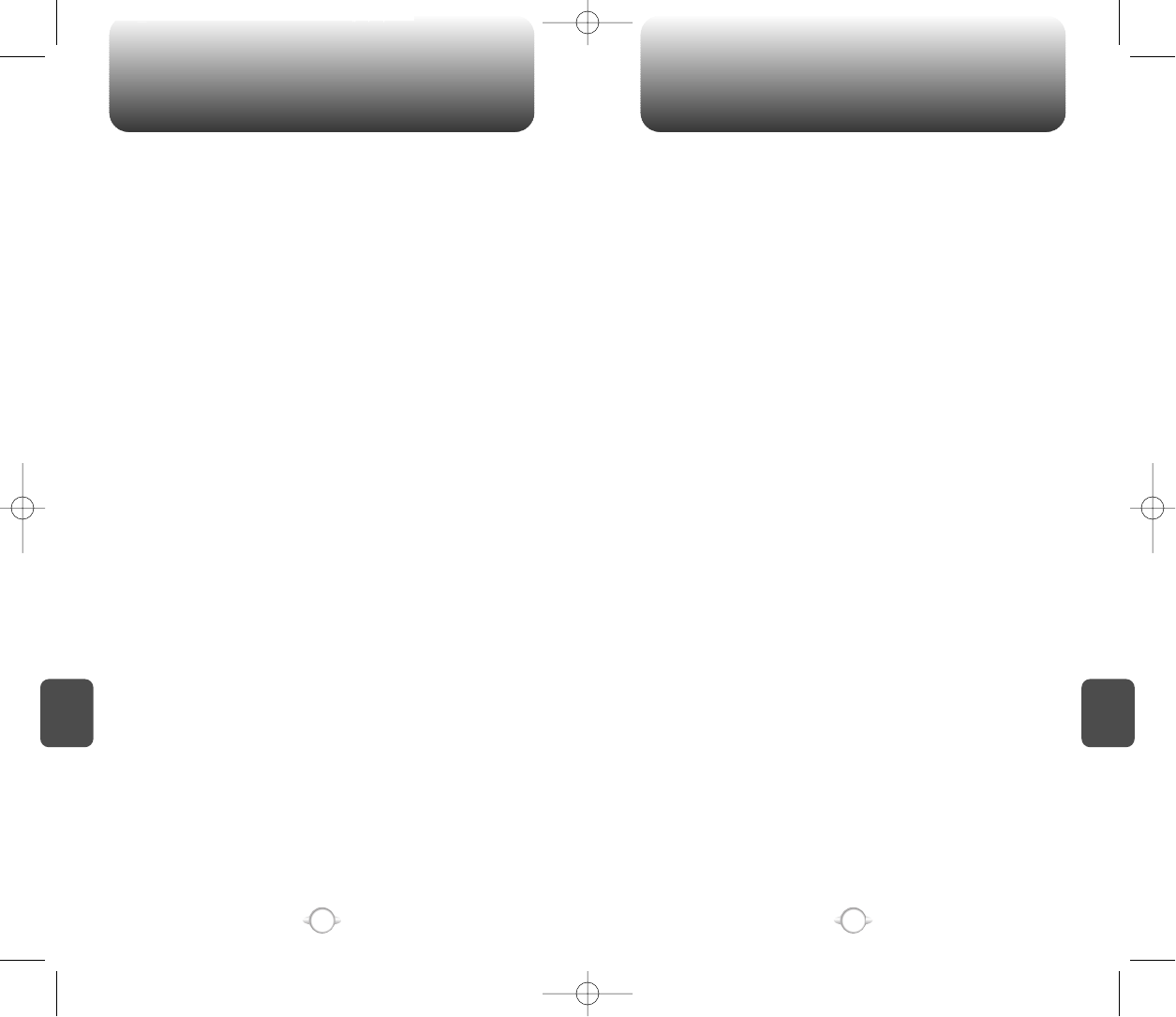
127126
FDA CONSUMER UPDATE FDA CONSUMER UPDATE
The Project has also helped develop a series of public information documents on
EMF issues. FDA and the Cellular Telecommunications & Internet Asso-ciation
(CTIA) have a formal Cooperative Research and De-velopment Agreement
(CRADA) to do research on wireless phone safety. FDA provides the scientific
oversight, obtaining input from experts in government, industry, and academic or-
ganizations. CTIA-funded research is conducted through con-tracts to
independent investigators. The initial research will include both laboratory studies
and studies of wireless phone users. The CRADA will also include a broad
assessment of additional research needs in the context of the latest research
developments around the world.
7. How can I find out how much radiofrequency energy exposure I can get by
using my wireless phone?
All phones sold in the United States must comply with Federal Communications
Commission (FCC) guidelines that limit radiofrequency energy (RF) exposures. FCC
established these guidelines in consultation with FDA and the other federal health
and safety agencies. The FCC limit for RF exposure from wire-less telephones is
set at a Specific Absorption Rate (SAR) of 1.6 watts per kilogram (1.6 W/kg). The
FCC limit is consistent with the safety standards developed by the Institute of
Electri-cal and Electronic Engineering (IEEE) and the National Council on Radiation
Protection and Measurement. The exposure limit takes into consideration the
body’s ability to remove heat from the tissues that absorb energy from the wireless
phone and is set well below levels known to have effects. Manufacturers of
wireless phones must report the RF expo-sure level for each model of phone to the
FCC. The FCC website (http://www.fcc.gov/oet/rfsafety) gives directions for
locating the FCC identification number on your phone so you can find your
phone’s RF exposure level in the online listing.
8. What has FDA done to measure the radiofrequency en-ergy coming from
wireless phones ?
The Institute of Electrical and Electronic Engineers (IEEE) is developing a technical
standard for measuring the radiofrequency energy (RF) exposure from wireless
phones and other wireless handsets with the participation and leader-ship of FDA
scientists and engineers. The standard, “Recom-mended Practice for Determining
the Spatial-Peak Specific Absorption Rate (SAR) in the Human Body Due to
Wireless Communications Devices: Experimental Techniques,” sets forth the first
consistent test methodology for measuring the rate at which RF is deposited in the
heads of wireless phone users. The test method uses a tissue-simulating model of
the human head. Standardized SAR test methodology is expected to greatly
improve the consistency of measurements made at different laboratories on the
same phone. SAR is the mea-surement of the amount of energy absorbed in
tissue, either by the whole body or a small part of the body. It is measured in
watts/kg (or milliwatts/g) of matter. This measurement is used to determine
whether a wireless phone complies with safety guidelines.
9. What steps can I take to reduce my exposure to radiofrequency energy
from my wireless phone?
If there is a risk from these products—and at this point we do not know that there
is—it is probably very small. But if you are concerned about avoiding even
potential risks, you can take a few simple steps to minimize your exposure to
radiofrequency energy (RF). Since time is a key factor in how much exposure a
person receives, reducing the amount of time spent using a wireless phone will
reduce RF exposure.
• If you must conduct extended conversations by wireless phone every day, you
could place more distance between your body and the source of the RF, since
the exposure level drops off dramatically with distance. For example, you could
use a headset and carry the wireless phone away from your body or use a
wireless phone connected to a remote an-tenna.
Again, the scientific data do not demonstrate that wireless phones are harmful. But
if you are concerned about the RF exposure from these products, you can use
measures like those described above to reduce your RF exposure from wire-less
phone use.
10.What about children using wireless phones?
The scientific evidence does not show a danger to users of wireless phones,
including children and teenagers. If you want to take steps to lower exposure to
radiofrequency energy (RF), the measures described above would apply to children
and teenagers using wireless phones. Reducing the time of wire-less phone use
and increasing the distance between the user and the RF source will reduce RF
exposure. Some groups sponsored by other national governments have advised
that children be discouraged from using wireless phones at all. For example, the
government in the United King-dom distributed leaflets containing such a
recommendation in December 2000. They noted that no evidence exists that us-
ing a wireless phone causes brain tumors or other ill effects. Their
recommendation to limit wireless phone use by children was strictly precautionary;
it was not based on scientific evi-dence that any health hazard exists.
11.What about wireless phone interference with medical equipment?
Radiofrequency energy (RF) from wireless phones can inter-act with some
electronic devices. For this reason, FDA helped develop a detailed test method to
measure electromagnetic interference (EMI) of implanted cardiac pacemakers and
defibrillators from wireless telephones. This test method is now part of a standard
sponsored by the Association for the Ad-vancement of Medical instrumentation
(AAMI). The final draft, a joint effort by FDA, medical device manufacturers, and
many other groups, was completed in late 2000. This standard will allow
manufacturers to ensure that cardiac pacemakers and defibrillators are safe from
wireless phone EMI. FDA has tested hearing aids for interference from handheld
wireless phones and helped develop a voluntary standard sponsored by the
Institute of Electrical and Electronic Engi-neers (IEEE). This standard specifies test
methods and per-formance requirements for hearing aids and wireless phones so
that that no interference occurs when a person uses a “com-patible” phone and a
“compatible” hearing aid at the same time. This standard was approved by the
IEEE in 2000. FDA continues to monitor the use of wireless phones for pos-sible
interactions with other medical devices. Should harmful interference be found to
occur, FDA will conduct testing to assess the interference and work to resolve the
problem.
12.Where can I find additional information?
For additional information, please refer to the following re-sources:
• FDA web page on wireless phones (http://www.fda.gov/cdrh/ phones/index.html)
• Federal Communications Commission (FCC) RF Safety Pro-gram
(http://www.fcc.gov/oet/rfsafety)
• International Commission on Non-Ionizing Radiation Protec-tion
(http://www.icnirp.de)
• World Health Organization (WHO) International EMF Project
(http://www.who.int/emf)
• National Radiological Protection Board (UK) (http://www.nrpb.org.uk/)
C
H
7
C
H
7
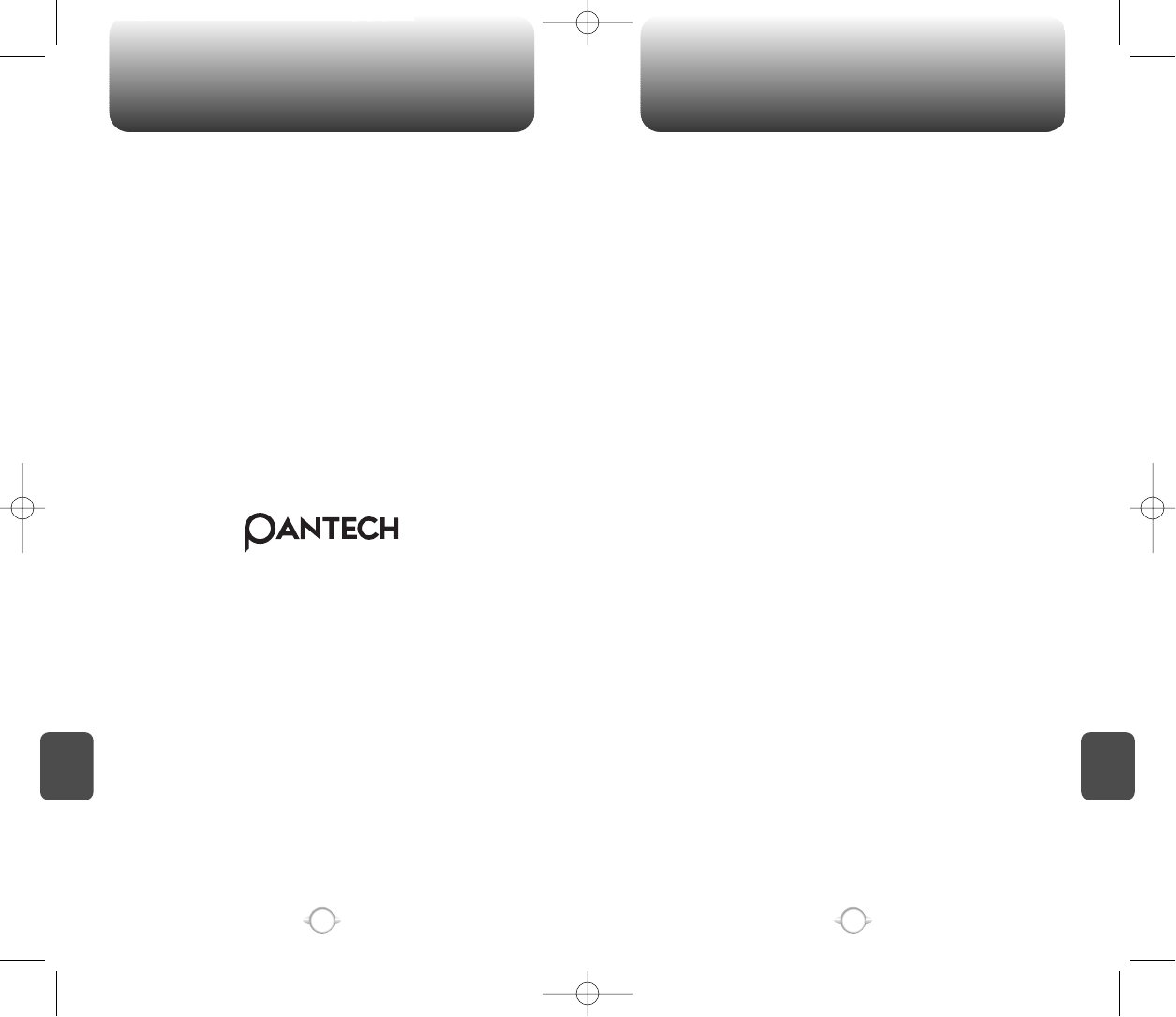
PROTECT YOUR WARRANTY 12 MONTH LIMITED WARRANTY
129128
C
H
7
C
H
7
Pantech Communications (the Company) warrants to the original retail
purchaser of this Pantech handheld portable cellular telephone, that
should this product or any part thereof during normal consumer usage
and conditions, be proven defective in material or workmanship that
results in product failure within the first twelve (12) months period from
the date of purchase, such defect(s) will be repaired or replaced (with
new or rebuilt parts) at the Company’s option, without charge for parts
or labor directly related to the defect(s).
The antenna, key pad, display, rechargeable battery and battery
charger, if included, are similarly warranted for twelve (12) months from
date of purchase.
This Warranty extends only to consumers who purchase the product in
the United States or Canada and it is not transferable or assignable.
This Warranty does not apply to:
(a) Product subjected to abnormal use or conditions, accident,
mishandling, neglect, unauthorized alteration, misuse, improper
installation or repair or improper storage;
(b) Product whose mechanical serial number or electronic serial number
has been removed, altered or defaced.
(c) Damage from exposure to moisture, humidity, excessive
temperatures or extreme environmental conditions;
(d) Damage resulting from connection to, or use of any accessory or
other product not approved or authorized by the Company;
(e) Defects in appearance, cosmetic, decorative or structural items such
as framing and non-operative parts;
(f) Product damaged from external causes such as fire, flooding, dirt,
sand, weather conditions, battery leakage, blown fuse, theft or
improper usage of any electrical source.
The Company disclaims liability for removal or reinstallation of the
product, for geographic coverage, for inadequate signal reception by
the antenna or for communications range or operation of the cellular
system as a whole.
To obtain repairs or replacement within the terms of this Warranty, the
product should be delivered with proof of Warranty coverage (e.g.
dated bill of sale), the consumer’s return address, daytime phone
number and/or fax number and complete description of the problem,
transportation prepaid, to the Company at the address shown below or
to the place of purchase for repair or replacement processing.
Read your Warranty carefully, with the special consideration to
paragraph seven of the Limited Warranty for your unit.
“Warranty does not apply to... or to any product or part
thereof which has suffered through alteration... mishandling
misuse, neglect or accident”.
Many companies are making look alike accessories and in some cases,
promoting that their product is equal to or better than the Pantech
product. Be careful. Some of these products may not be compatible to
use with your Pantech product and may damage the unit or cause it to
malfunction. If service is required on your unit and it is determined that
a non-Pantech accessory has created the problem with your unit, the
Warranty will not apply. In addition, if the unit has already suffered
irreversible damage by reason of a non-compatible accessory, the
Warranty will be voided. To protect your Warranty, use only compatible
accessories which cannot damage or interfere with the functioning of
your Pantech product.
PANTECH COMMUNICATIONS
555 Wireless Blvd., Hauppauge, New York 11788, 800-229-1235
16808 Marquardt Avenue, Cerritos, California 90703, 562-802-5100
Pantech Canada Company
5155 Spectrum Way, Unit #5, Mississauga, Ontario
Canada L4W 5A1, 800-465-9672
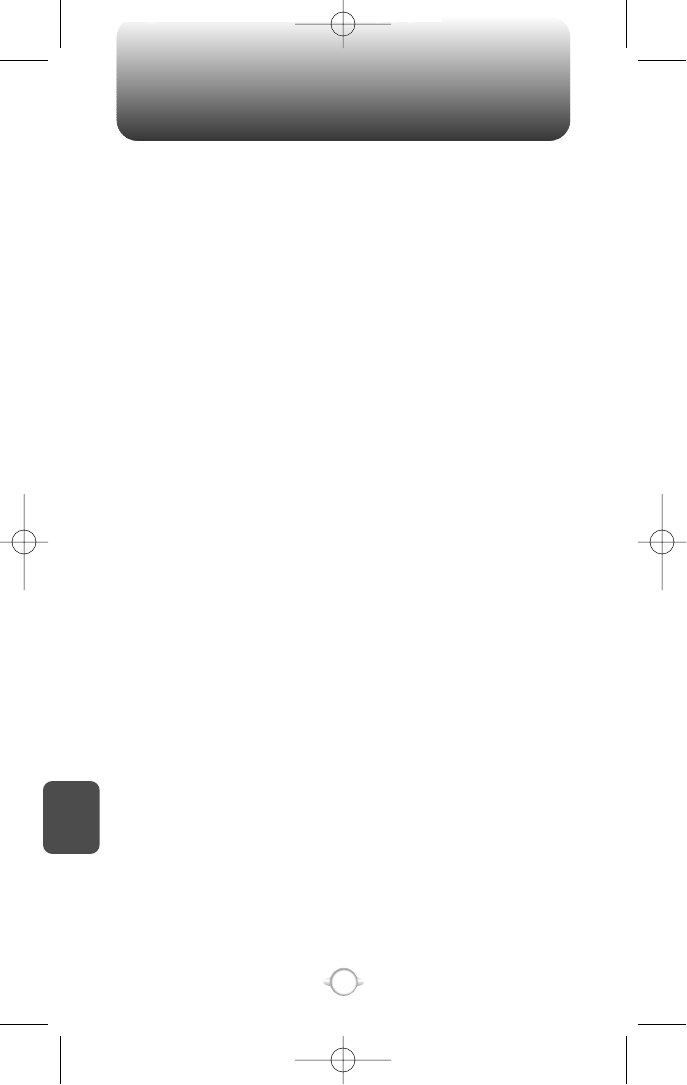
12 MONTH LIMITED WARRANTY
130
In addition, for reference to an authorized Warranty station in your area,
you may telephone in the United States (800) 229-1235, and in Canada
(800) 465-9672 (in Ontario call 905-712-9299).
THE EXTENT OF THE COMPANY’S LIABILITY UNDER THIS
WARRANTY IS LIMITED TO THE REPAIR OR REPLACEMENT
PROVIDED ABOVE AND, IN NO EVENT, SHALL THE COMPANY’S
LAIBILITY EXCEED THE PURCHASE PRICE PAID BY PURCHASER
FOR THE PRODUCT.
ANY IMPLIED WARRANTIES, INCLUDING ANY IMPLIED WARRANTY
OF MERCHANTABILITY OR FITNESS FOR A PARTICULAR PURPOSE,
SHALL BE LIMITED TO THE DURATION OF THIS WRITTEN
WARRANTY. ANY ACTION FOR BREACH OF ANY WARRANTY MUST
BE BROUGHT WITHIN A PERIOD OF 18 MONTHS FROM DATE OF
ORIGINAL PURCHASE. IN NO CASE SHALL THE COMPANY BE
LIABLE FOR AN SPECIAL CONSEQUENTIAL OR INCIDENTAL
DAMAGES FOR BREACH OF THIS OR ANY OTHER WARRANTY,
EXPRESS OR IMPLIED, WHATSOEVER. THE COMPANY SHALL NOT
BE LIABLE FOR THE DELAY IN RENDERING SERVICE UNDER THIS
WARRANTY OR LOSS OF USE DURING THE TIME THE PRODUCT IS
BEING REPAIRED OR REPLACED.
No person or representative is authorized to assume for the Company
any liability other than expressed herein in connection with the sale of
this product.
Some states or provinces do not allow limitations on how long an
implied warranty lasts or the exclusion or limitation of incidental or
consequential damage so the above limitation or exclusions may not
apply to you. This Warranty gives you specific legal rights, and you may
also have other rights which vary from state to state or province
to province.
IN USA : Pantech Communications
555 Wireless Blvd.
Hauppauge, NY 11788
(800) 229-1235
IN CANADA : Pantech Canada Company
5155 Spectrum Way, Unit #5
Mississauga, Ontario L4W 5A1
(800) 465-9672
C
H
7